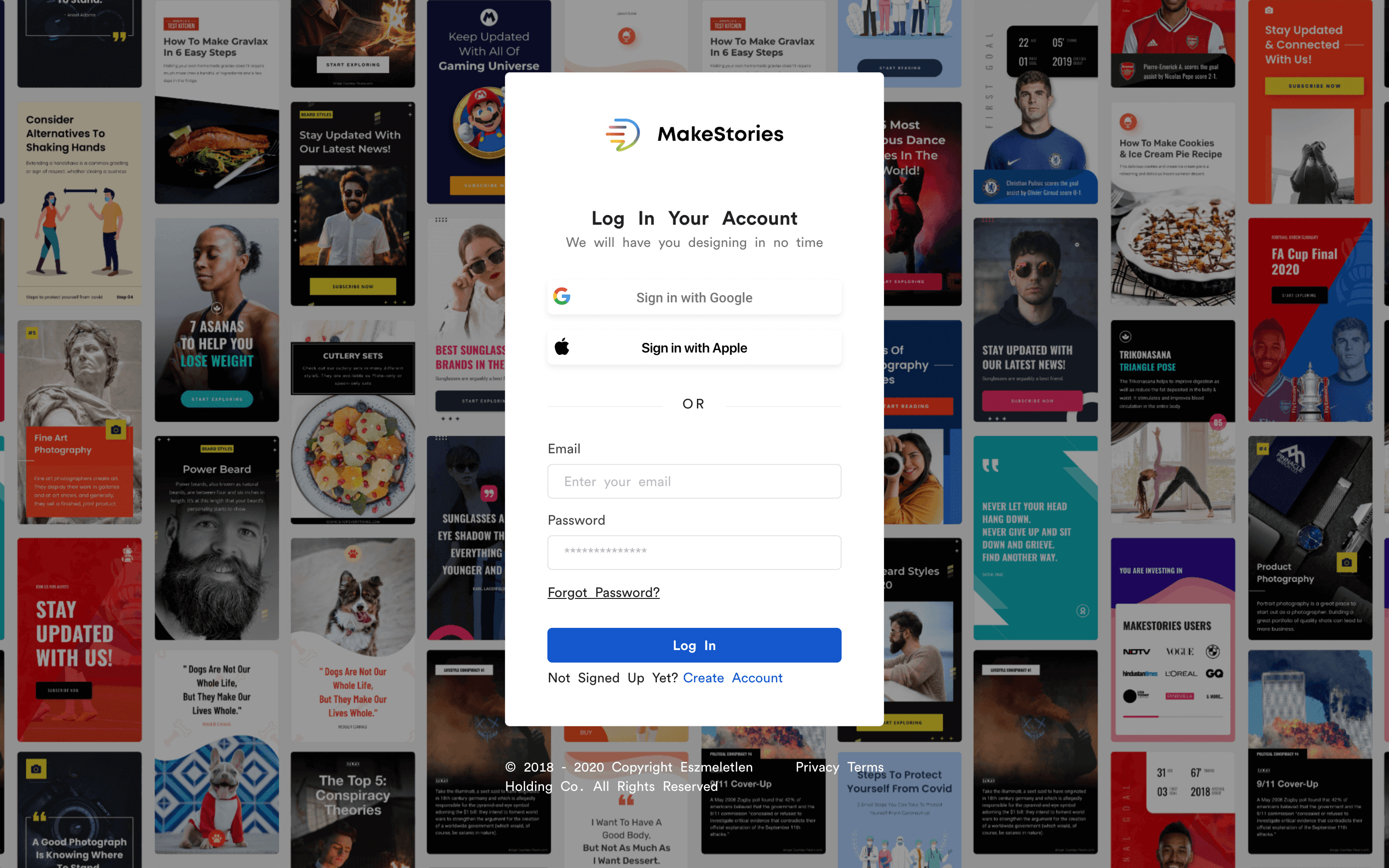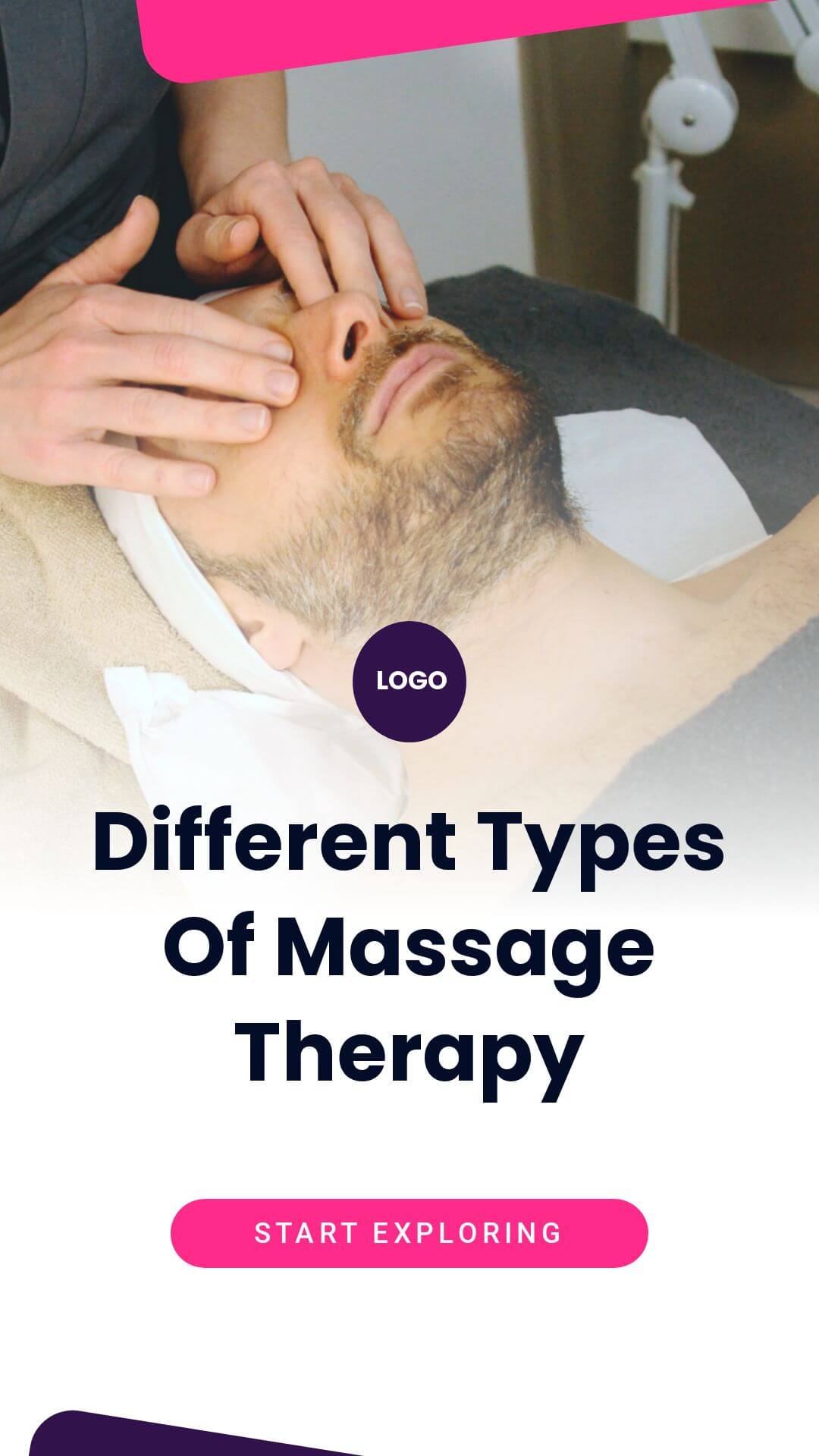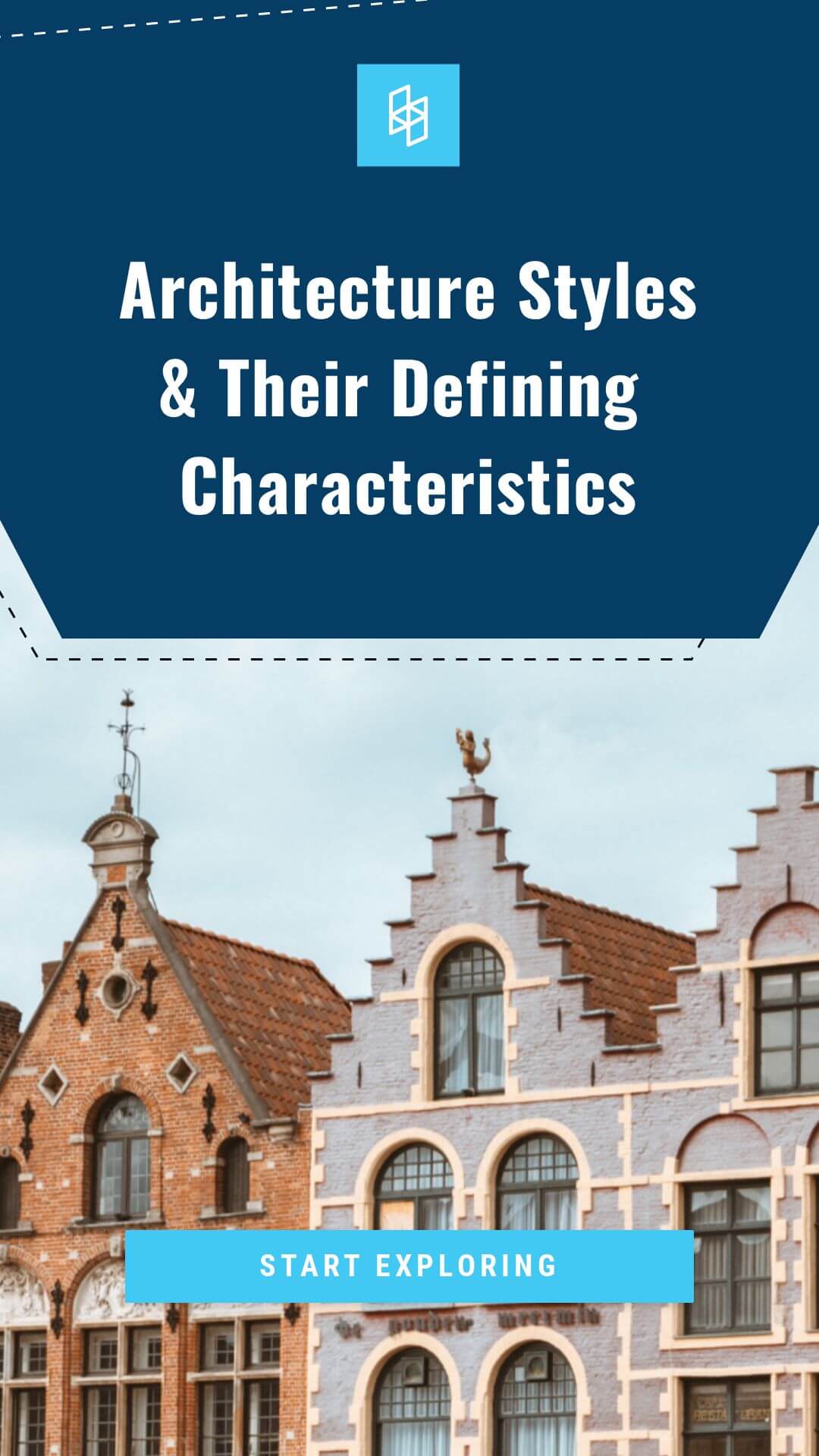![]()
7 Apr 2023, 11:56 am
Using Scrims for Google Web Stories

You know those moments when you have to squint your eyes to read text placed on an image or video? Well, that’s a big no-no when it comes to Web Stories etiquette. Google Web Stories are a fantastic tool to help your brand reach out to the billions that can find you on Google Search, Discover and Google Images.
A web story looks a lot like an Instagram story, but that’s where the similarities cease. A web story is hosted on your own website which gives you control over it’s duration and design. The features surpass any other story sharing platform. You can add multiple CTAs to external URLs, you can monetize your stories and generate revenue, you can multiply your audience reach and you can get SEO value out of them too!
Why good design is important for a Web Story
A web story is a completely visual tool. The more attractive and relevant a web story, the higher chances you have of attracting your audience to click and view. Good design has universal rules that also apply to a web story design.
- Good design makes the content/product/service easy to understand
- Good design is aesthetically pleasing
- Good design is functional
- Good design is sustainable
- Good design induces emotion
What is a Scrim and how does it help design better Web Stories?
Scrims are overlays. A word we are all more familiar with. Scrims are the dark overlays that help your text pop over images and videos. A scrim adds a layer or a shadow effect, making it easier to read text over pictures and videos.
Since a web story is optimized for phone viewing, it is important to ensure the text pops out and is easy to read, while still being pleasing to look at.
When should I use a Scrim?
- To highlight text in a story, scrims are the way to go.
- To draw the viewers eyes to a specific area, images or videos on your web story.
- To match the entire slide to a colour theme or brand vibe.
- To add a visual design element with colour.
How to add a Scrim on MakeStories?
To design a Web Story you will need to use a Web Story editor, there are many available online. MakeStories is a popular free Web Story editor and publisher available online. MakeStories has a drag and drop interface that makes it very easy to design high quality web stories.
Once you open the MakeStories editor, select ‘Background’ on the left side panel. You will see the header ‘Overlay’. Once you click ‘Overlay’, you will see the option to ‘Enable Scrim’. On doing so, you will find a host of options come to life to design the perfect Scrim or Overlay.
Types of Scrims or Overlays on MakeStories
1. Solid: On clicking ‘Solid’, your entire slide gets covered with an overlay. The overlay opacity can be decided by the controller. By swiping it up or down the colour turns from solid to translucent over the image or video. The colour grid available, allows you to select any colour you want or you can also input a Hex Code.
2. Linear: A Linear Scrim or Overlay, adds a gradient layer on top of your image background or video background. Typically, Linear Scrims are used on the bottom of Web Story slides, to ensure the text is clearly visible on top of an image.
- Add Multiple Linear Overlays: MakeStories is very intuitive and all about detailed customization. They provide you with in depth options to add multiple Linear Overlays, for eg: a gradient overlay on the top, and a gradient overlay at the bottom.
- Reverse Linear Overlays: If you have applied a red overlay on top and a blue overlay at the bottom, you can simply press the reverse icon to test the colours in exchanged spots.
- Select any Angle: MS also gives you the option to play around with the angle of the gradient. You can have it enter from the sides, corner edges, and more.
3. Radial: A radial scrim or overlay works beautifully to highlight a particular part of the slide, image or video. It can create a halo or radiating look of colour originating from one point of the slide.
Best Practices with Scrims and Overlays on Web Stories
- Linear is a popular choice: Linear Overlays are the most popularly used Scrims on Web Stories because they are a smaller, neater gradient look that create clear visuals for text to pop, without compromising on the image or video in the background.
- Pick the colour wisely: When selecting a colour for your Scrim/Overlay, ensure that it doesn’t clash with the image and background. Sometimes the wrong choice of colour can disturb the beauty of the backdrop or even work counter-productively to make the text less visible!
Scrims are a great way to add some visual flair to your web stories. They’re versatile, easy to use and can be used in a variety of ways. You can start creating good looking Web Stories right here with MakeStories.
6 Jan 2023, 10:46 am
CTA Link vs Tooltip Link on Google Web Stories

Social Media as a marketing tool is very limiting, brands have to engage in follower-increasing strategies to reach new users, content created after a lot of hard work expires in 24 hours, without ad budgets the reach is very minimal, call to actions are not seamless for the user, link redirection is not an intuitive experience.
But with Google Web Stories, brands get to skip the line and enter a much larger pool of people available on Google. That’s because Web Stories appear on Google Search, Images and Discover! Google Web Stories work like blogs and website content – they have SEO value! This means your potential readers, viewers and customers will come find you. Oh, and it gets better – you can also monetize your web stories!
Importance of a CTA in Web Stories
A call to action is a method to persuade a viewer to take action. This action can vary from clicking a website link to signing up for a newsletter, hitting the like button. leaving a comment and more. Websites, emailers, social media have all reinforced the importance of a CTA with statistics revealing, emails with a single call-to-action increased clicks 371% and sales by 1617%, CTAs to a Facebook page can increase the click-through rate by 285%.
In a Web Story, you could have the need to add various types of Call To Actions. If you’re a publisher you may want to send them to your website. If you’re a blogger you may want to redirect them to your Youtube Channel. As an influencer you may want to redirect audiences to affiliate links. If you’re a brand you may want to send customers to shop links. If you’re a restaurant you may want to send them to your Google Maps locations! The use cases are endless.
CTA Tools in Web Stories
Typically a CTA is thought to be a button. A button that says, ‘Click Here’, ‘Buy Now’, ‘Get Code’, etc. But in Web Stories you can do so much more than that!
Of course you can use the traditional CTA button, but you can also link elements like images, grouped text, grouped text and images to be clickable and lead to a link. You can even create a CTA that links to another slide of your story!
Free Web Story Editors and Publishers like MakeStories, have very 2 very simple ways of executing this.
1. Click CTA Link on MakeStories
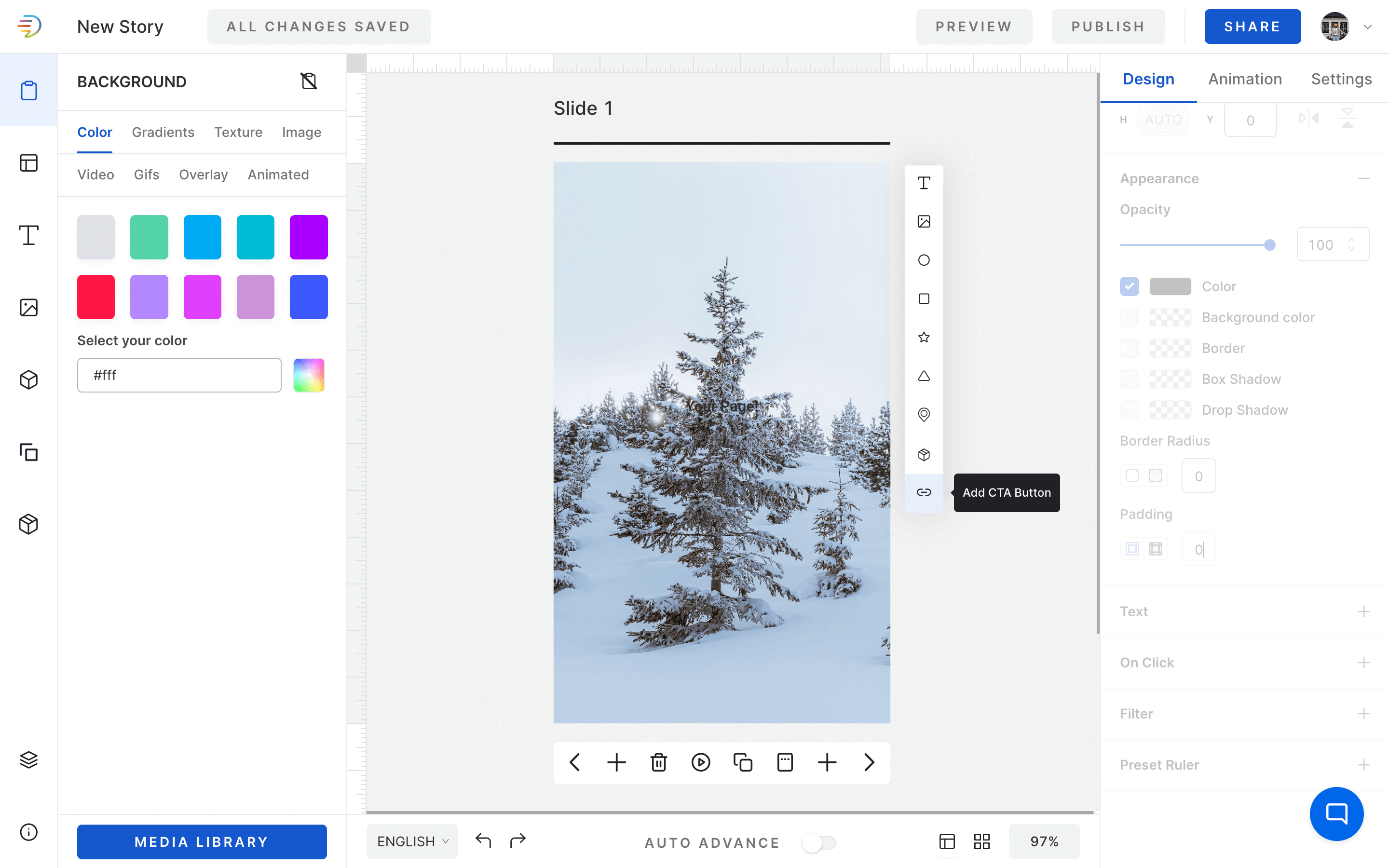
MakeStories actually has a built-in Call to Action button with backend settings ready to go. On your MakeStories left side panel, if you select ‘Layers’ you will find an ‘Add CTA Button’.
Upon clicking this, a CTA button gets automatically created and placed on the bottom half, bottom 20%, of your story slide. A viewer will click this button once and get redirected to the linked URL.
You can customize the following on your 1 Click CTA Link Button:
1. CTA Design: MakeStories has a host of buttons in different colours and styles that you can select from. If you want to customize it further, you can head to the ‘Appearance’ tab and edit colour, drop shadow, border radius and more according to your preferences. You can find these options on the right side panel of the MakeStories editor.
2. CTA Settings: Here you have 1 choices. You can either send your viewers to an external URL which opens on click.
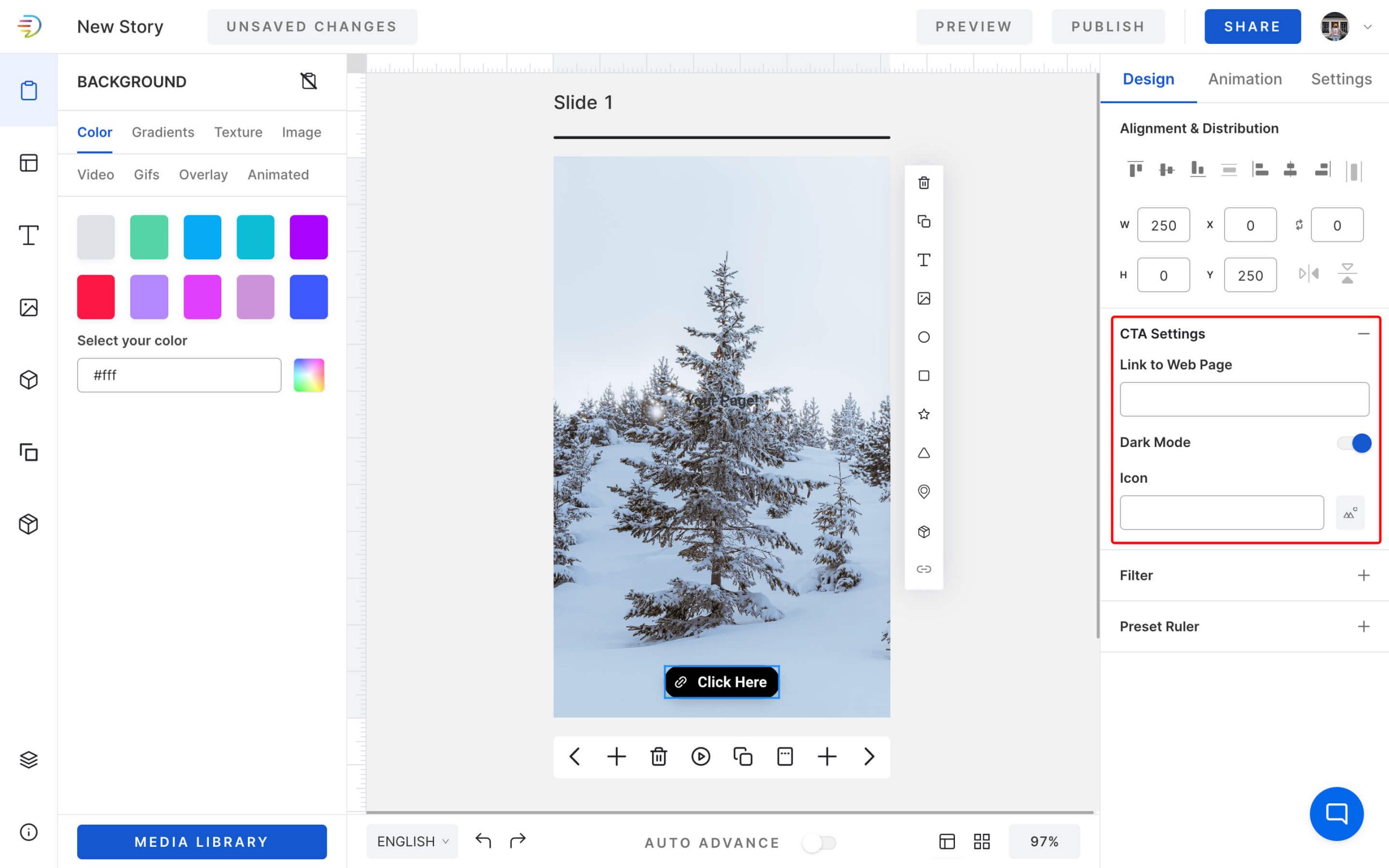
- External URL: This is as straightforward as it sounds. Simply type in the link to the web page on the right side panel under CTA Settings. The favicon gets pulled up automatically from the linked website. If there is no favicon connected to the web link you can upload a custom favicon too!
Note: You are allowed 1 CTA per slide. Any CTA placed on the bottom 20% automatically becomes a 1 click CTA.
2 Click Tooltip CTA on MakeStories
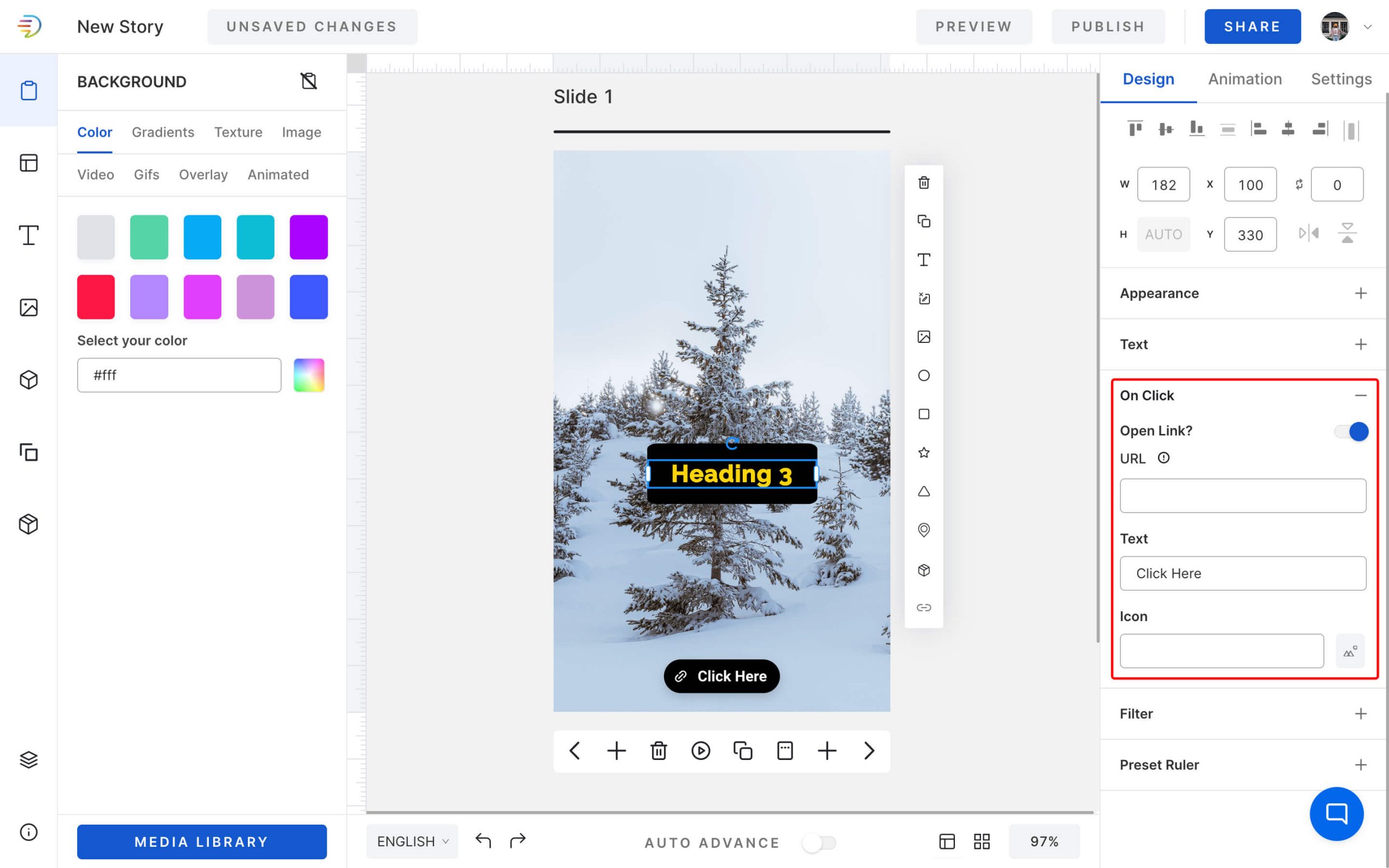
The Tool Tip is applicable on the top 80% of the story slide. This means that any element on the top 80% of your slide can be turned into a clickable button. An image, text, a group of images, or even a grouped text and image.
For example, your header text says, “Hi, we are MakeStories.” and then goes into a description of what MakeStories is. You want to link the word MakeStories to a website URL.
For this, select the text and go to ‘On Click’ in the right side panel on the editor. Now activate “Open Link” and feed the URl you would like the word to click open to.
Similarly, you can select a photograph to click open into a link, a video, an icon as well. The only difference is that this would be a 2 click call to action. When a viewer taps on the word or image, a small tooltip pops up which shows a preview of the link with a favicon. This helps the viewer get some context to where the link is taking them.
You can customize the following on your 2 Click Tooltip CTA:
- Text: When the tooltip pops up, you can customize the text they should see. It can say, ‘Go to Maps’, ‘Enter Now!’, ‘Visit MakeStories Website’ and more.
- Favicon: If the URL you have linked does not have a Favicon, you can upload a custom Favicon too!
CTA Button Vs Tooltip Link
Although both have the same purpose, which is to send traffic to an external link, there are just a few differences between the two. Check your requirements and pick the CTA format that works for you!
| 1 Click | 2 Click |
|---|---|
| Button text is the guiding text | Pop up on hover has additional text for context |
| Has an in-built button feature on MakeStories | Elements you create can be turned into clickable links |
| Built in CTA button feature anchors itself to the bottom 20% of the slide | Elements linked can be only in the top 80% of the slide |
| only external URLs | Cannot interlink to Slide, only external URLs |
| Allowed 1 CTA button per slide | Allowed more than 1 tooltip per slide |
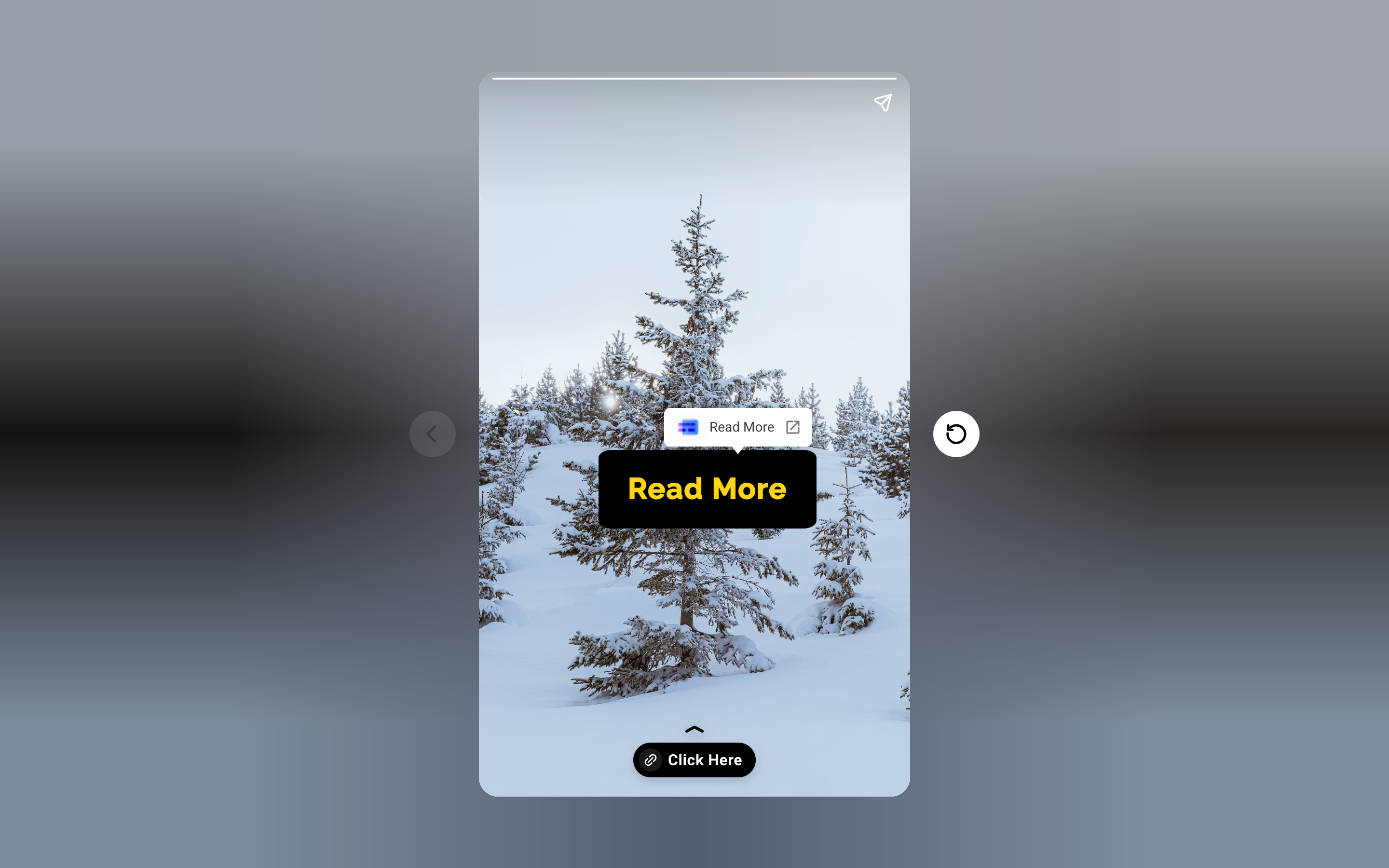
These two types of CTA elements may look similar at first glance but they can be used in different ways to optimize the web story experience. Tools like MakeStories make it very easy to execute. Finally, the purpose is for your viewer to take action. Best practices dictate streamlining viewers to one solid CTA, so as to not confuse the next step.
Web Stories are a dynamic method of marketing your brand. They allow you freedom of design, hosting and discoverability. You can even monetize your web stories and start generating revenue!
29 Dec 2022, 7:01 am
How to add a Location Tag in Google Web Stories

Did you know you can tag a location on Google Web Stories! Yes, if you are a product or a service that needs to send your audience to Google Maps to find you, you can simply tag your location to a web story.
If you’re new to Google Web Stories then here’s a quick recap. Web Stories are a new tool to reach audiences created by Google. It’s a form of tappable sliders or cards that look a lot like Instagram Stories. But the similarities end there. Google Web Stories do not expire in 24 hours, they are searchable on the open web – Google Search, Google Discover and Google Images, and they are hosted on your own website!
Google Web Stories allow customers to find you if they’re searching for keywords, topics, products, services similar to yours on Google. It follows an SEO style approach making your stories discoverable to relevant audiences from across the globe.
Why tag locations on Web Stories?
1. Generate Footfall: Are you a restaurant, store, co-working space, builder, school, hospital, car showroom, or owner of any business that requires physical footfall? You can use Web Stories to create engaging stories that lead viewers directly to your location on Google Maps.
2. Promote Affiliate Businesses: Are you a publisher helping viewers find the best holiday resorts in South Asia? Are you running a tourism campaign redirecting viewers to historical wonders in your country? Allow your readers to take action by clicking on location tags and viewing the actual location on Google Maps.

How do I tag locations on Web Stories?
Web Stories can be created and published using free tools on the internet like MakeStories. MakeStories is a drag and drop editor anyone can use to make Web Stories, it can also be used to publish and monetize Web Stories.
On MakeStories, you simply click the ‘Tag Location’ pin icon on the right side panel, next to your slide. This is the third icon from the bottom.

Upon clicking the icon, a pop up appears where you just have to enter the location of your choice. Select from the drop down curated from Google Maps.

A button matching the location name automatically gets created on your slide. Now all you have to do is align the design.
Location Tag Design Customization on MakeStories
1. Tag Type: MakeStories gives you three button customizations in the form of Dark, Light or Default. Each of these, as the name suggests, changes the look of the button. Based on your background image or video you can pick the best option to make your location tag stand out.
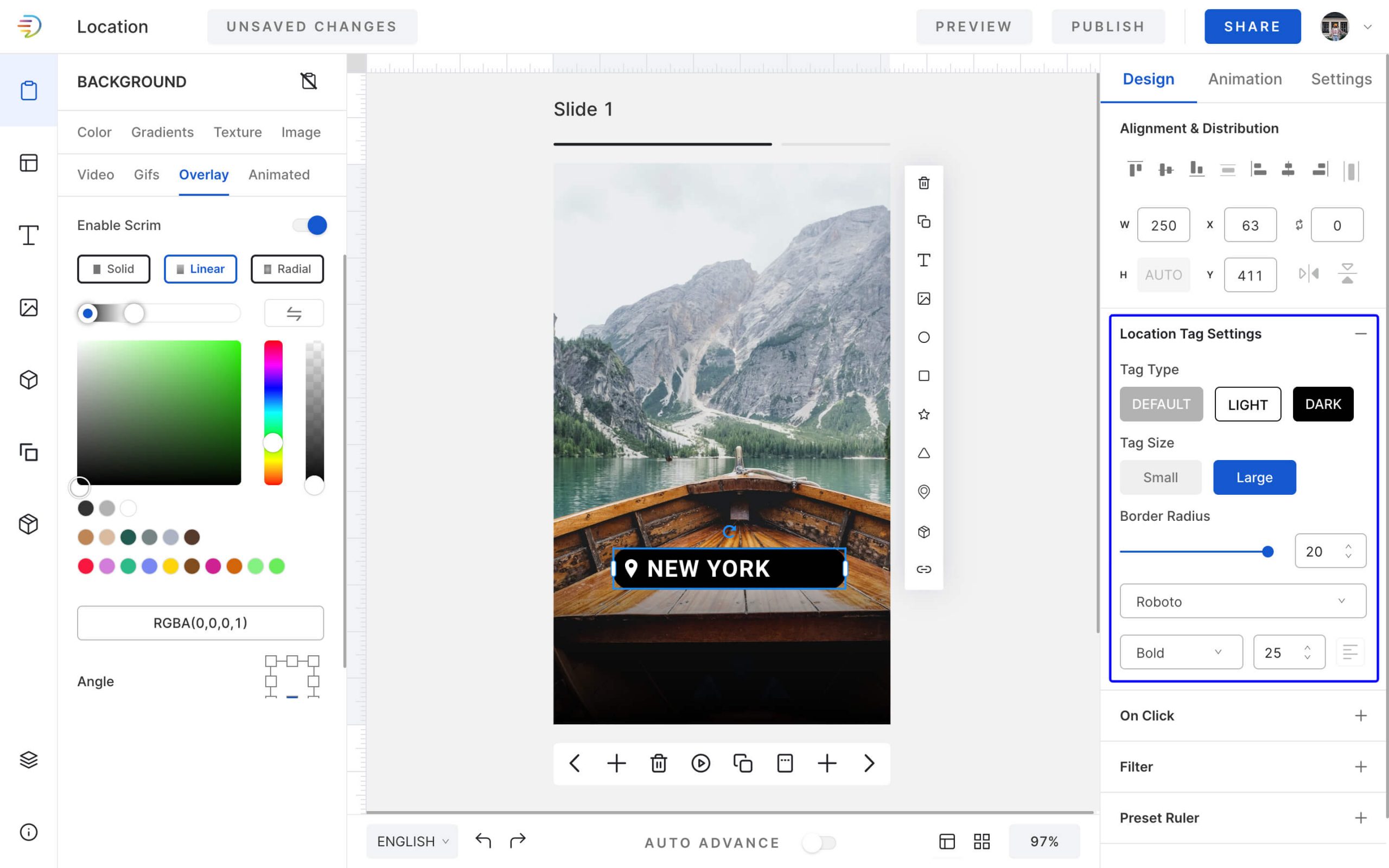
2. Tag Size: You can select between two sizes for the Location button, Small or Large
3. Border Radius: Edit your border Radius based on the look you want to achieve.
4. Font: You are free to match the fonts to your brand fonts for tag button.
5. On Click Text: When a viewer clicks on the location tag, the tool tip text can be further customized. For eg: “Go to Maps’, “View on Google Maps Now!’, ‘Check out the location on Maps!’
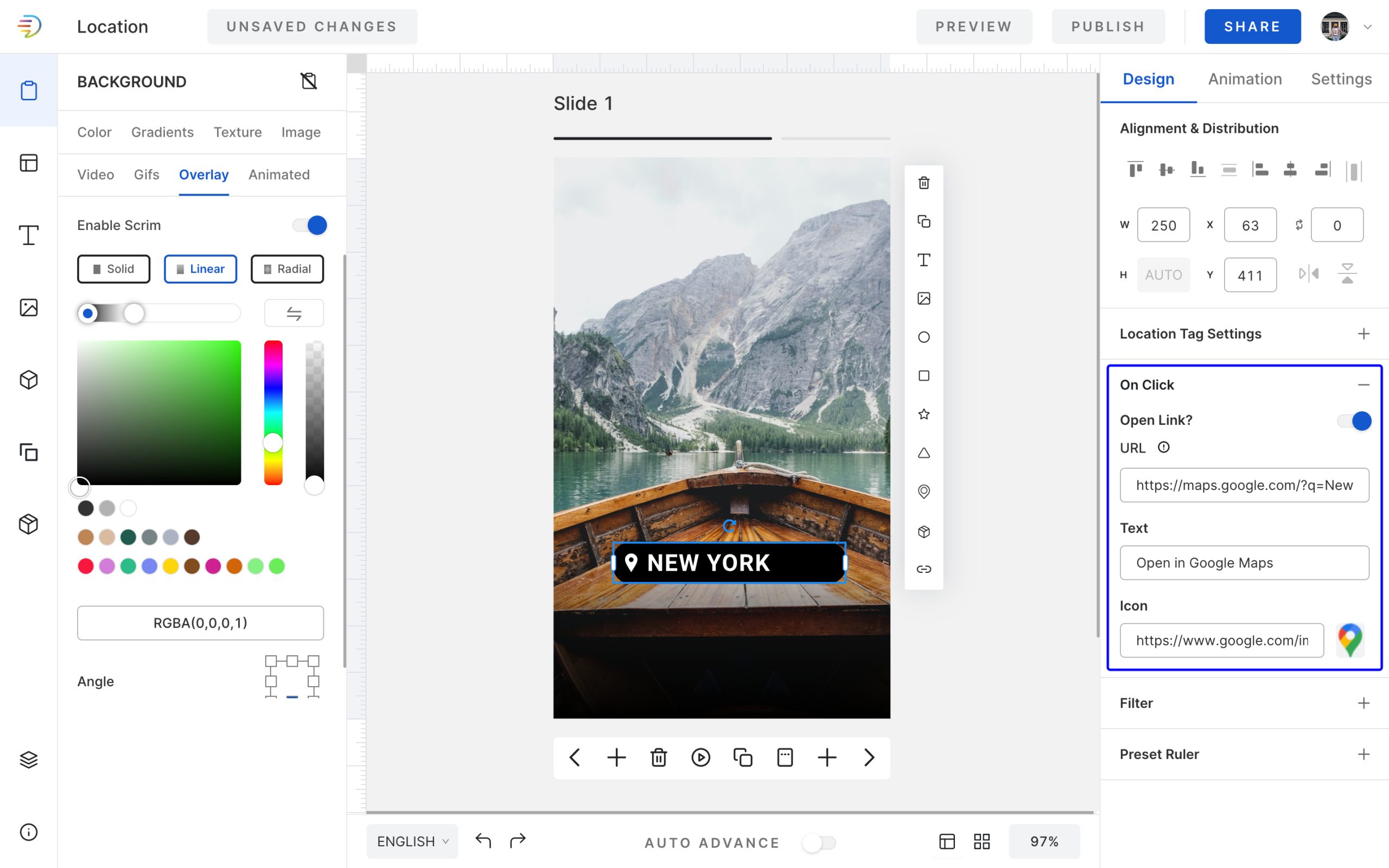
6. Animation: Add some animation to your location tags by adding an entry effect, for eg: fly in, fly out, zoom out, whoosh in and more. You can also select the duration and sequence of animated elements on your web story.
7. Filter: Select a filter for your location tag if you want to match a vibe. You can go grayscale, retro, dark, whimsical and many more
Get Tagging!
Location tags on Web Stories make it super easy to redirect customers to Google Maps. They create a direct pathway between your story and an address. So go ahead and bring in that new footfall, use Web Stories to generate more revenue online and offline!
22 Dec 2022, 10:56 am
Use Geometric Shapes to design better Google Web Stories

Geometry is beautiful. It’s all around us. It’s simplicity and versatility makes it a fundamental building block of design. Google Web Stories that succeed generally succeed because of great design. The nature of Google Web Stories are so visual that we cannot ignore the importance of compelling design to ensure we get the views and clicks.
You may already know that Web Stories by Google, are visual, tappable cards much like Instagram Stories but with a difference – they are discoverable on the open web. Your web stories are available on Google Discover, Google Images and Google Search. You can host Google Web Stories on your own website and have them show up in Google Search Results.
A study conducted by Forrester Consulting revealed that a single, popular Web Story could drive a million page views to a website! The same report also shows regular web story creators generating $160 – $400 of advertising revenue per month per Web Story. And finally, since Web Stories are hosted on our own website we have complete ownership over how they look and when they expire, unlike other platforms where brands are bound by platform limitations.
Good Design Adds Business Value
A McKinsey Report that tracked design decisions of 300 publicly listed companies over 5 years found that the higher a company scored on the McKinsey Design Index, the higher the business performance was. The market was clearly rewarding brands with good design.
Psychology of Geometric Shapes in Google Web Stories
Geometric shapes and design are rooted in Geometry, the mathematical study of the relationship between lines and surfaces. The reason geometric patterns appeal to the masses is because of shape psychology. The human eye is naturally attracted to them and the meaning we attach to it.
For example: Squares relate to structure, stability and reliability. Circles represent harmony, creativity, femininity. Triangles are associated with direction, movement, power.
Depending on the Web Story you’re creating, the story you’re narrating, you can choose Geometric Shapes that leave an impact on your viewer.
How to optimize Geometric Shape Design on MakeStories
Free web story creators available on the internet like MakeStories have fun features that can level up your design quotient. MakeStories has an easy drag and drop interface that allows you to add a variety of design elements.

For Geometric Shapes, MakeStories has ready-to-use icons that can be customized to suit your web story. You can simply click on the icon shaped like a – circle, square, star or polygon on the side panel of your slide to create your shape.
Best Uses of Geometric Shapes on Web Stories
1. Buttons: Circles and Squares are best used to highlight short special text, an offer, a discount or a call to action. Add a drop shadow to make the shape appear 3D and clickable. You can directly add links to these shapes to redirect viewers to your website or store link.
2. Backgrounds: Squares and Rectangles are very effective backdrops for a header or text layouts. Use a block colour square to make your text stand out from the background. Reduce Opacity if you’d like to give it a more sheer feel.
3. Symbolic Design Elements: Use shapes to highlight, draw attention to or convey messages without text. A star shape is the perfect option to show off a USP, a rating or a review. Add 5 star shapes to display a 5 star rating. Polygons can make for beautiful design accents. Triangles can be used to show movement and direction.
4. Patterns: Geometric patterns curated together can create very aesthetic patterns. These can be used as backdrops or accents on web stories. Try concentric circles, concentric squares, mirrored triangles and more repeated shapes to create attractive patterns.
Customize Geometric Patterns with MakeStories’ Features
1. Size: Once you click on the desired shape, just drag the edges to adjust the size or manually adjust the height and width in pixels.
2. Appearance: If you want a solid block look can keep the opacity at a 100%, but if you want a light, airy, translucent look you can play around with the opacity of your geometric shape. You can customize the colour of the border, box shadow and drop shadow on your shape in this section.
Tip: Use a drop shadow on a call to action square or circle to make it look like a 3D clickable button.
3. On Click: Unlike other story formats, web stories allow you to very easily add clickable links on your story. What are buttons if not geometric shapes? Add any call to action on your web story and a link to redirect your viewer.
4. Color: Pick colours from a colour chart or type in your brand colour hex codes to ensure your web stories match your brand seamlessly.
5. Filter: Want to match your shapes with a vibe, grayscale, retro, dark, whimsical? MakeStories’ ready filters adjust your shapes in just one click.
6. Animation: Add some drama to your web story by animating your shapes. MakeStories allows you to animate elements by adding an entry effect, for eg: fly in, fly out, zoom out, whoosh in and more. You can also select the duration and sequence of animated elements on your web story.
Tips & Tricks for MakeStories Shapes
1. Keyboard Shortcuts: MakeStories has keyboard shortcuts to make your experience easier than it already is. Just click ‘C’ fo Circle, ‘R’ for Rectangle, ‘S’ for Star and ‘P’ for Polygon. Type the keyboard shortcut and drag to adjust the size.
2. Polygon Sides: If you want to create a pentagon, hexagon, octagon and more, all you need to do is, go to Triangle and change the number of sides in the Design Settings. The shape automatically gets updated as you input the number of sides.
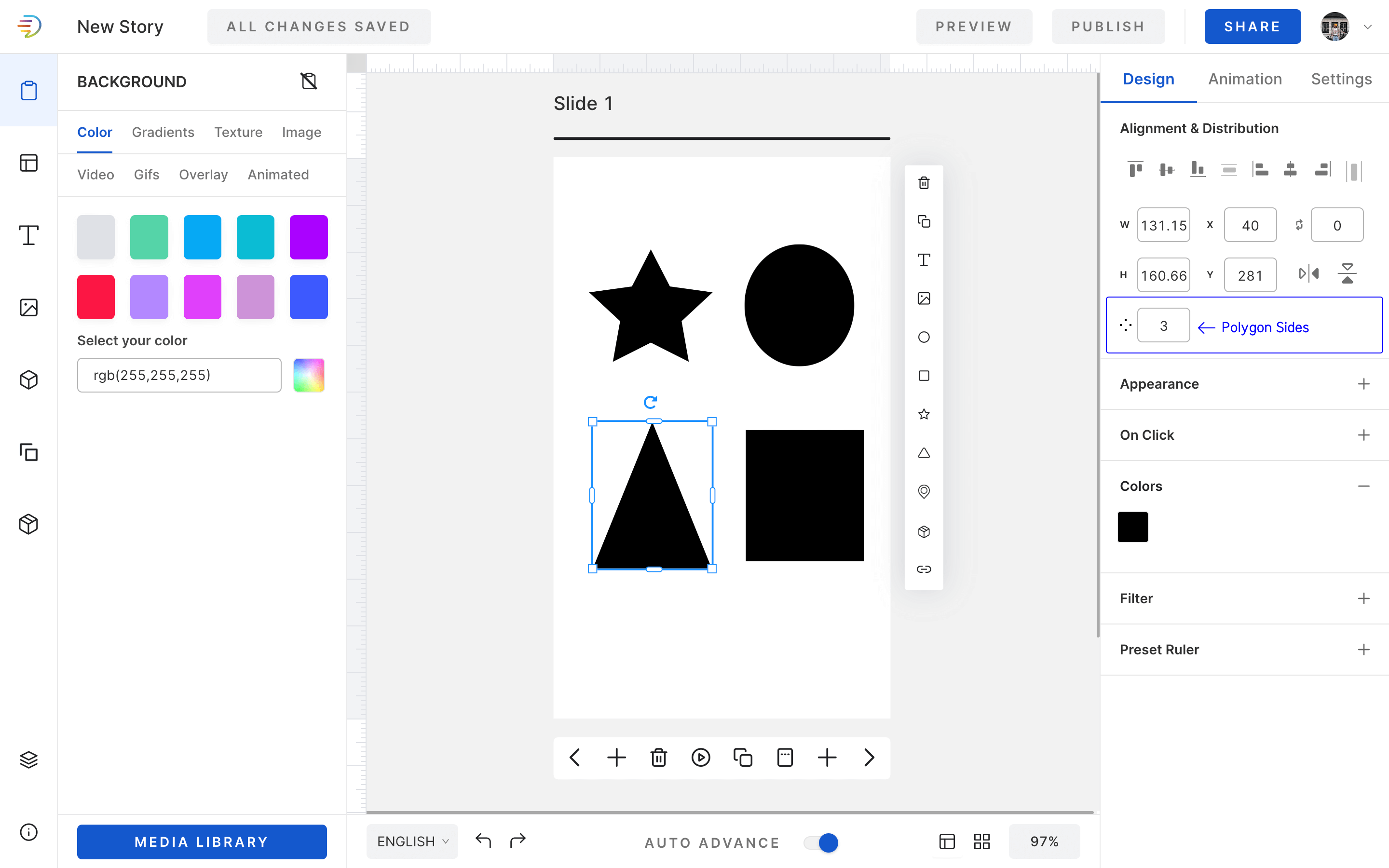
Tell Stories, Increase Traffic and Generate Revenue today!
Geometric shapes are easy to adapt for any theme, and can be used in multiple ways. The next time you design an interesting web story using geometric shapes might be the way to go!
Tools like MakeStories simplify your web story creation and publishing journey. With drag and drop tools, a huge collection of themes, libraries of images and videos, it is easy to use even for an amateur marketer or designer. Bring in more traffic, reach out to new audiences, generate revenue through ads from across the globe using this unique storytelling marketing tool.
15 Dec 2022, 11:40 am
Text and Font Best Practices for Web Story Success

Good storytelling in web stories is best combined with great text. The right typography can establish mood, tone and style. Text is becoming even more important as a sign of inclusivity to people who have a hearing impairment. It also aids the rising trend of users viewing content without audio, on mute.
If you want your Web Story to be consumed by as many people as possible, invest time in the right typography. It allows your viewers to take in the important context and narration before moving into the visual narrative. It is not recommended to use videos or images with text burned into the web story slide because they cannot be indexed by Google, nor are they responsive to different screen sizes.
But we can often get lost inside the vast world of fonts and typography. This could lead to text that is illegible. If a user cannot read your text, you’ve already lost them. The best font and text practices to enhancing web story user experience includes the following:
1. Text Length
Keep titles and body text concise per slide.
- Recommended title length should be between 10 to 40 characters including spaces.The body text on the inside slides should not cross 200 characters. To get a clearer idea, that’s no longer than a tweet.
- Tools like MakeStories keep a check of this for you. They validate your web story text and provide you with clear notifications if you are exceeding or are short of the ideal character limit.
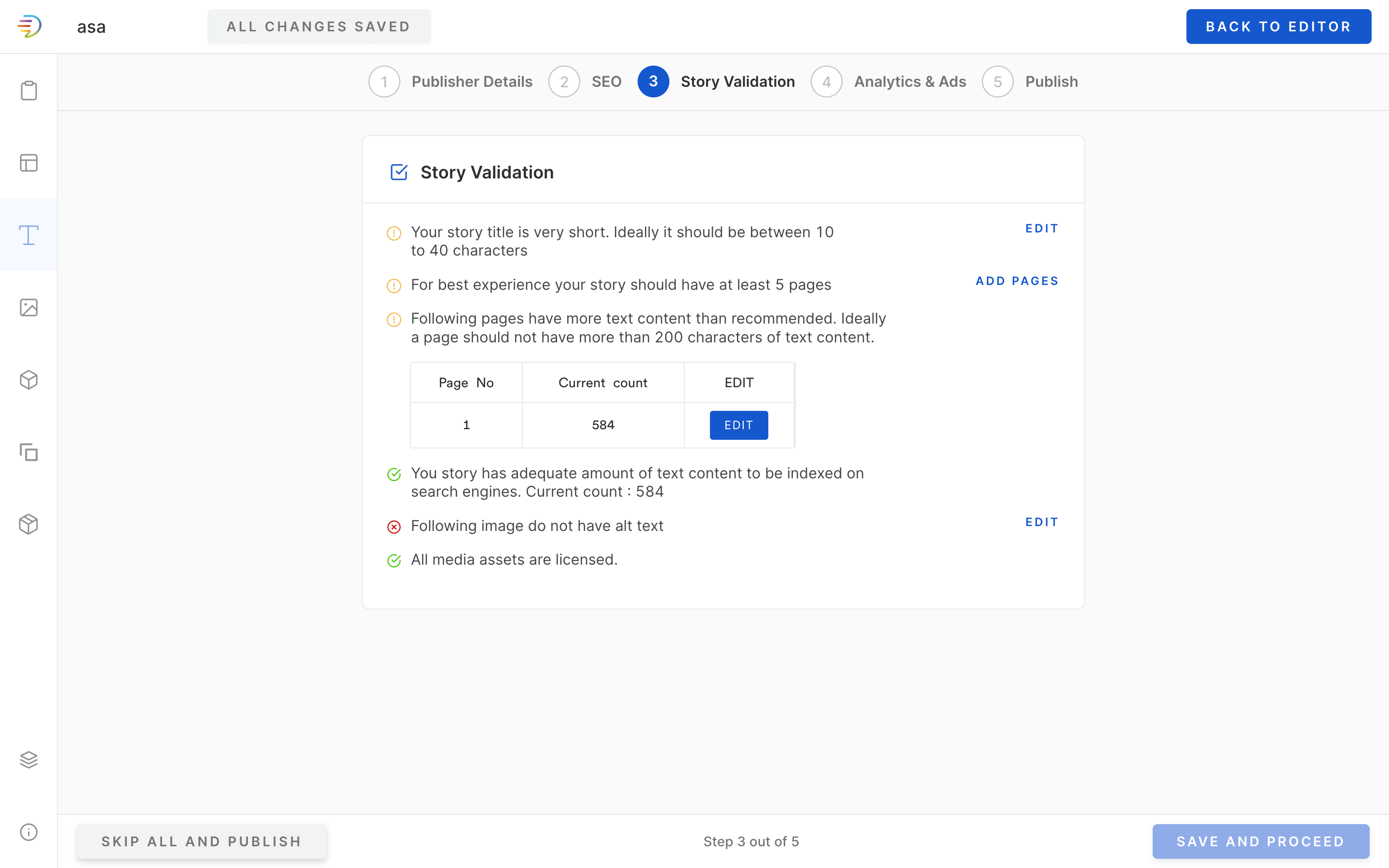
2. Font
Web Stories are typically viewed on mobile devices and the font you use could make or break your legibility. Users don’t have time to figure out the text on the screen.
- Online web story creator tool MakeStories comes with over 1400 fonts to suit your brand and content type.
- It also has Text Combinations that are very helpful for any web story editorial and creation team. These text combinations are reliable font combinations in style and size. Creators can simply drag and drop a font combination that suits their content and brand, edit and drag the unit to increase it’s size proportionately. The font unit increases and decreases in size in a fixed ratio, which means you would not have to make any extra adjustments upon dragging.
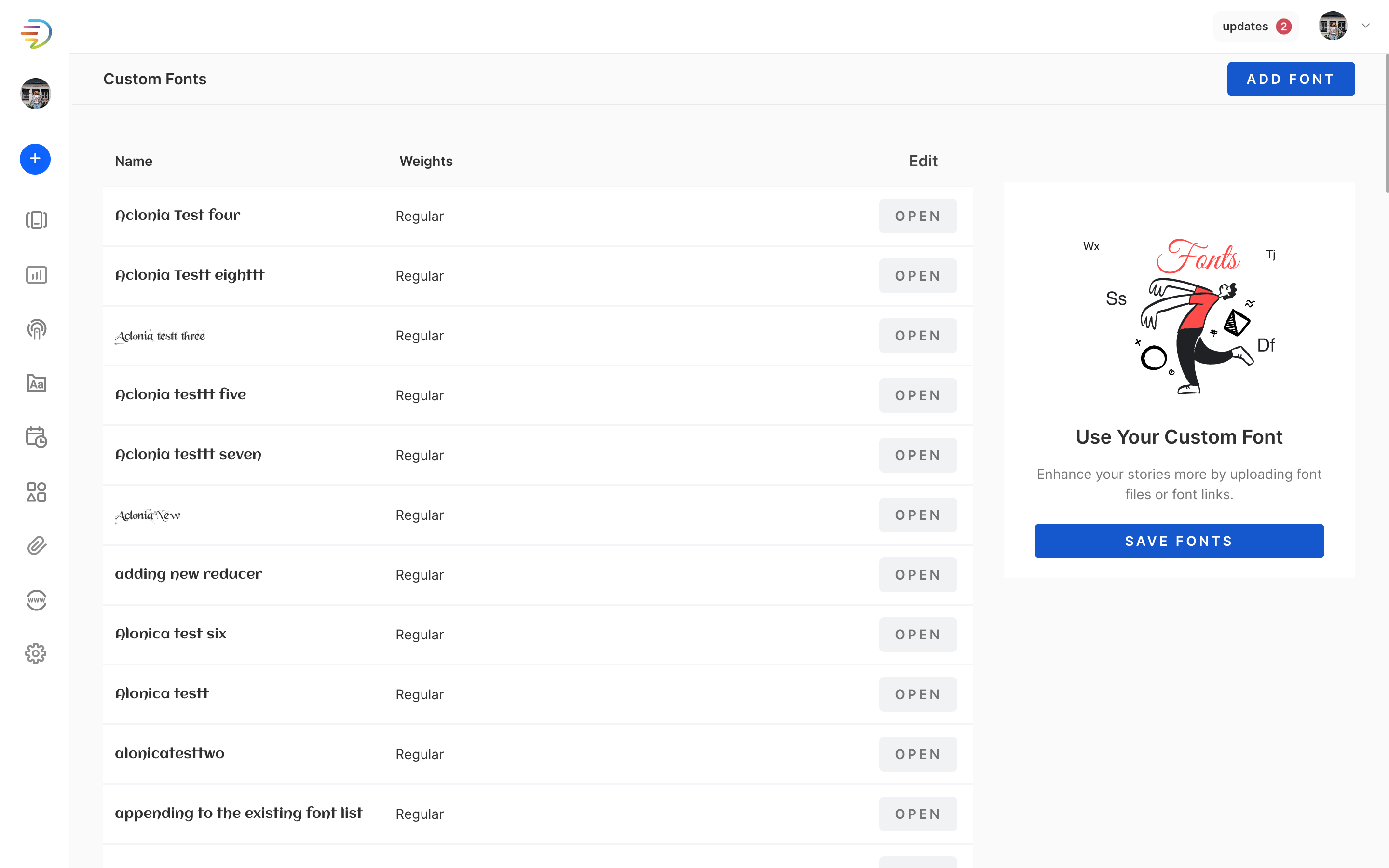
3. Size
Getting the font size right for mobile device viewing can also get tricky. MakeStories has built in recommended font sizes for Headings and Paragraph content. These range from the largest recommended header at 25px, Heading 2 at 23.5px, Heading 3 at 22px and Paragraph text at 16 and 14 each. These tried and tested font sizes take away the need for experimentation on the designer’s end.

4. Appearance
The text on your web story can be creatively eye-catching but must be clear at the same time.
- Ensure a contrasting color that is pleasing yet allows the text to come across clearly. If your background image or video is too colorful or busy add a text box to boost visibility. There’s nothing a text box cannot solve!
- Creator tools like MakeStories have features that allow designers to do this very quickly. Options like Background color instantly add a text box behind the text. Other tools allow you to select Opacity, add a Drop Shadow, or even a Box Shadow. These can further enhance text visibility while still keeping the web story slide aesthetically pleasing.
- MakeStories also offers filters for your text, if you do not wish to play around manually with brightness and contrasts. Some of their popular text filters are Sepia and Hue-Rotate.

5. Padding
When using text boxes with fonts, padding plays a vital role in it’s visual impact. Keeping balanced empty spaces between the box and the text is called padding, when text touches or overlaps with the edges of boxes it can make the text illegible or disturbing to the eye. MakeStories, which is free for enterprises of all sizes till December 2022, has an easy way to fix this too, with their four sided padding function.
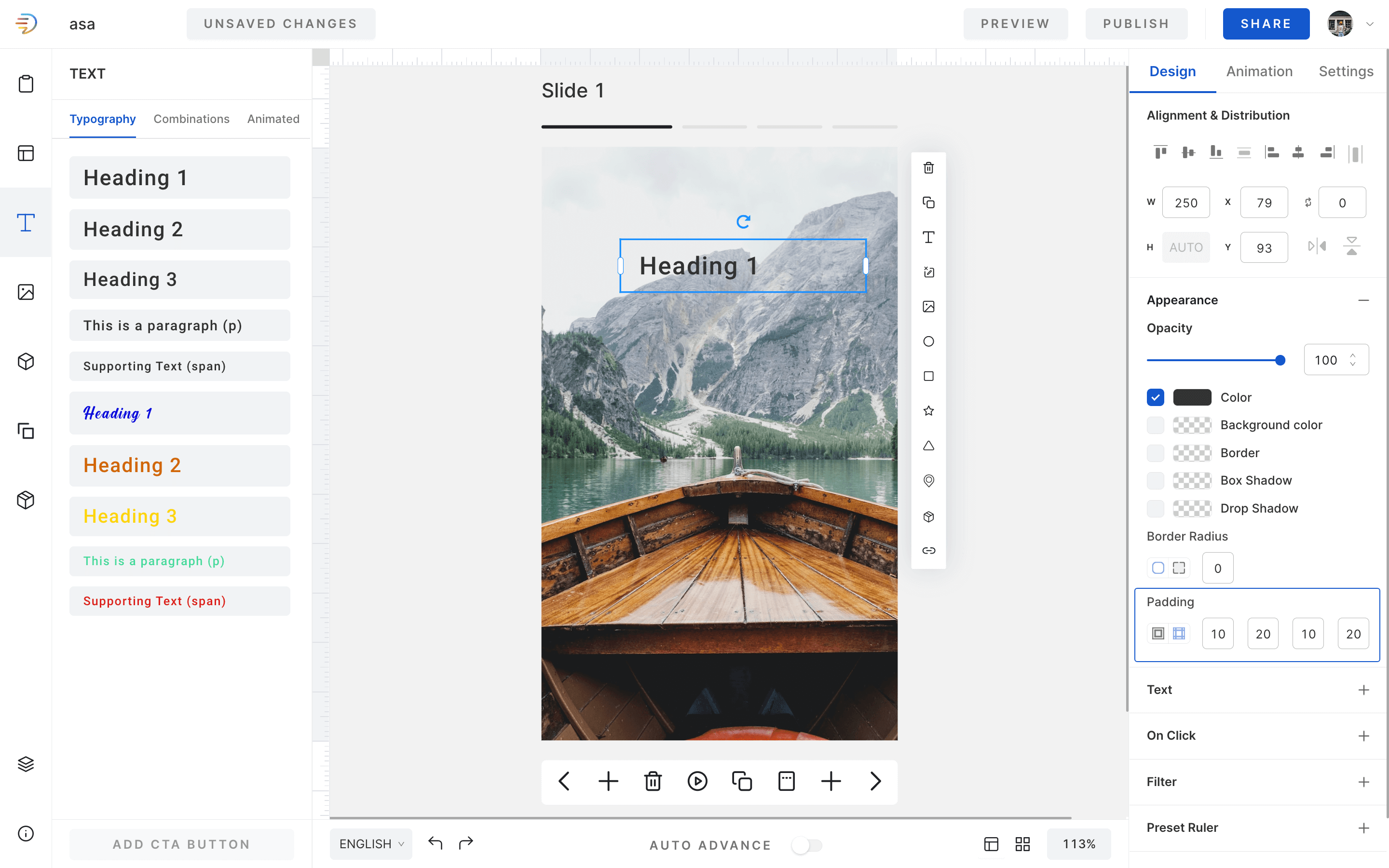
6. Text Animation
Bring your web stories to life with animated text. This is especially useful when you are working with static images. Animated text can give you the scope to stand out and create a unique experience for the user
- However, it is recommended not to go overboard with animations. Usew simple animations that are pleasing to the eye and not distracting from your actual content.
- Overuse of a particular text animation can also create fatigue in the minds of the user.
- MakeStories has 17 text animations pre built into the editor. You do not need any design expertise or training for this. You can simply select a text animation and edit the text. Drag the corners to increase or decrease the size of the text. Some of the popular text animations on MakeStories are Apple Reveal and Begin Race.

7. Safe Zone
When users view your web story across different devices, it might not always fit on the screen. For example, if you are showing a picture and the text is too long, the text may get completely cut off on their screen. Create a Safe Zone on your web story editor canvas and keep all the elements within those lines. Tools like MakeStories have Preset Rulers that have built in rulers at 20px, 30px and 40px. The recommended safe zone is
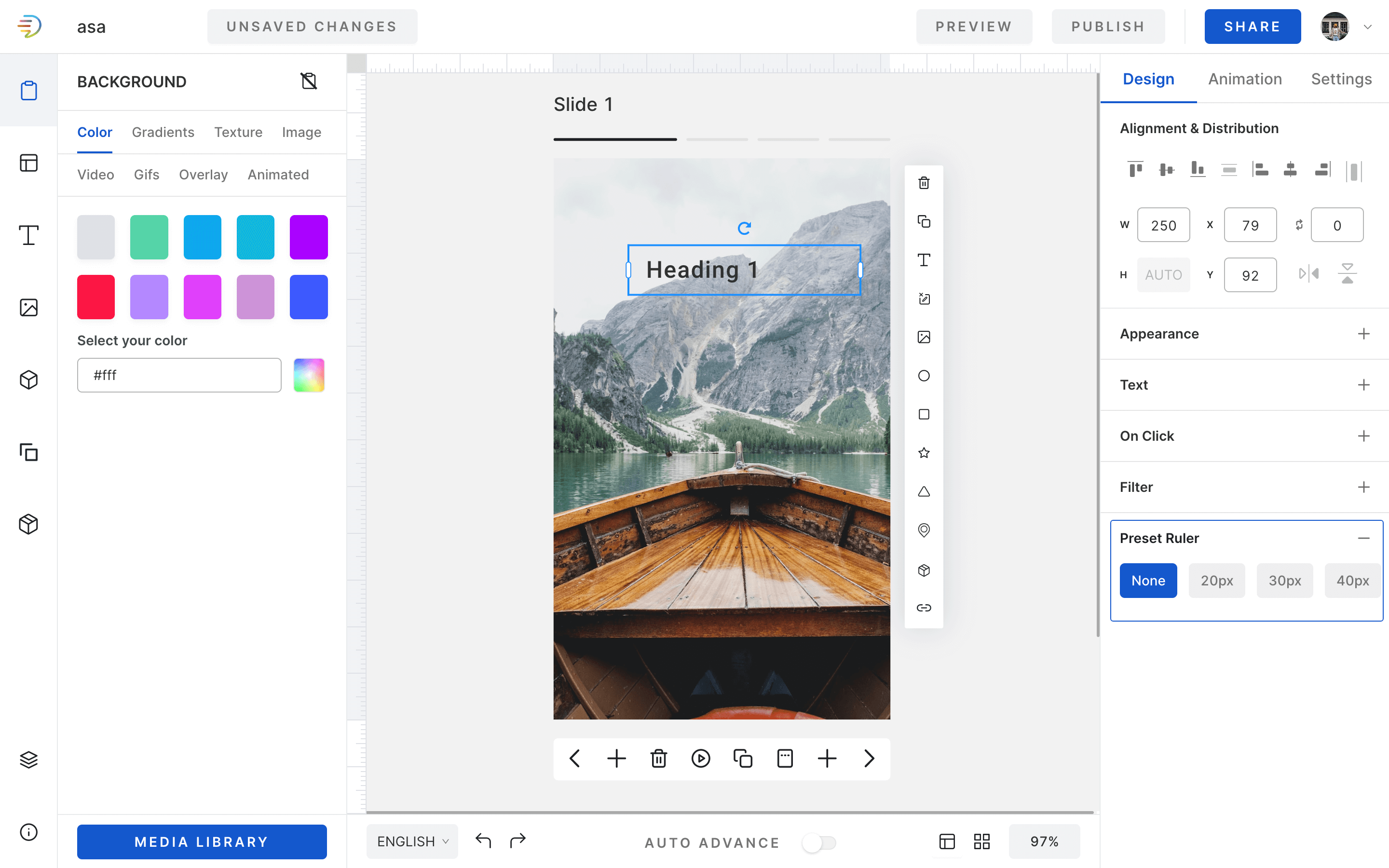
Text can be a powerful design element in the right hands. Web Stories are serving a purpose for your brand – be it for advertising, publishing content, or news. Craft your web stories with care, test out what works best for your audience, keep the above best practices in mind and let Web Stories add another content distribution and revenue generation dimension to your brand.
9 Dec 2022, 12:49 pm
Traffic, Revenue and Costs revealed of Publishers using Web Stories for Marketing

When Google launched Google “Stories” in beta form back in 2018, the company had no idea how useful it would become. As time has gone on, publishers have begun using web stories as a permanent method of storytelling to attract new audiences and retain existing. The results have established that web stories are here to stay.
Forrester Consulting conducted an in depth study to quantify benefits like website traffic, advertising revenue and costs across companies that deployed Web Stories as a marketing tool. For the purpose of this study, Forrester created a composite organization out of the 4 publishers they interviewed and 90 publishers they surveyed who invested in Web Stories. The organizations in this report are located in the United States, Brazil and India.
“Last year was really challenging for us during the [COVID-19] pandemic. A lot of people realized that diversifying revenue and alternative ways of making money are more important than ever. Exploring this with Google Web Stories makes a ton of sense.”
Why publishers and marketers found Web Stories an attractive marketing investment
Forrester’s study found that the need to invest in Web Stories for content creation and dissemination came from limitations in existing platforms. The popular challenges publishers faced were as follows:
- Audiences on mobile: With increasing traffic views only through mobile, publishers felt the need to focus more on mobile optimized content formats.
- Limited Content Types: Publishers wanted to increase engagement for their content and wanted to use more visually appealing formats.
- Content Restrictions: When sharing content across other platforms publishers had to follow their rules and create content for each differently. All that effort for a story and it would expire in 24 hours.
- Branding Inconsistency: In following different content rules for each external platform, publishers found their branding taking a hit.
- Revenue Stream Stagnation: As traditional channels of generating revenue through content creation went through a depression, brands needed to find new ways to monetize content.
What are the quantifiable economic benefits of using Web Stories as a marketing tool?
“A single, popular Web Story could drive a million page views to their website” said, one of the publishers interviewed in the study.
10.7% Increase in Website Traffic with Web Stories
The report reveals publishers that invested in web stories are publishing an average of 60 web stories per week. 53% of survey respondents witnessed website traffic increasing with Web Stories. This segment also indicated that a web story in comparison with a text story brought in a 10.7% increase in traffic.
13.1% Increase in Story Views and Impressions with Web Stories
61% of survey respondents expressed an increase in page views and impressions with web stories. In comparison with a text story, this segment indicated that Web Stories generated 13.1% more page views and impressions.
According to the Forrester report, if a publisher was generating 15500 monthly impressions per text article, the same article as a web story would generate 17531 monthly impressions. Annually, with the assumption of 120 stories per month, the publisher is enjoying 2,103,660 monthly impressions. WIth an average Revenue per thousand impressions at $2 for display advertising, web stories are contributing a revenue of $50,488 (with Risk Adjustment at 20%, it would be $40,390 ) just in Year 1.
“The study reveals Publishers are generating $160 – $400 of advertising revenue per month per Web Story.”
51% percent saw an increase in advertising revenues
Publishers that saw success with revenue through web stories shared their best practices in this study. They sold ads both directly and programmatically to advertisers. Revenue was found to be much higher with direct ads. Additionally, publishers usually placed advertisements around the 7th slide in a web story.
Publishers confirmed generating $160-$400 of ad revenue per web story per month, with an incremental increase of $182 per web story per month.
With 120 web stories published per month, presuming a publisher activated their ads only half way through Year 1, after risk adjustment, they are already generating ad revenues of $92,160.
| Advertising Revenue | |||||
|---|---|---|---|---|---|
| Ref. | Metric | Calculation | Year 1 | Year 2 | Year 3 |
| B1 | Web Stories published (per month) | A4 | 120 | 160 | 200 |
| B2 | Advertising revenue per story per month | Interviews and survey data | $160 | $160 | $160 |
| B3 | Advertising revenue per month with Web Stories | B1*B2 | $19,200 | $25,600 | $32,000 |
| B4 | Implied RPM | B2/(A3/1,000) | $9.13 | $9.13 | $9.13 |
| B5 | Advertising revenue with Web Stories | B3*12 months | $230,400 | $307,200 | $384,000 |
| B6 | Phased adoption of Web Stories advertising | Interviews and survey data | 50% | 70% | 80% |
| Bt | Advertising revenue | IB5*B6 | $115,200 | $215,040 | $307,200 |
| Risk adjustment | ↓20% | ||||
| Three-year total: $509,952 | Three-year present value: $410,600 | ||||
“Respondents saw an average $75 increase Month on Month with affiliate link advertising”
40% saw an increase in affiliate link revenue with Web Stories
Affiliate link revenue is a new avenue still being tested by many marketers. Current findings from the report shows a promising start. Each web story is generating an affiliate link revenue of $60 per Web Story per month. 40% of affiliate link advertising users are witnessing a revenue increase of $75 per Web Story per month.
| Affiliate Link Revenue | |||||
|---|---|---|---|---|---|
| Ref. | Metric | Calculation | Year 1 | Year 2 | Year 3 |
| C1 | Web Stories published (per month) | A4 | 120 | 160 | 200 |
| C2 | Affiliate link revenue per story per month | Interviews and survey data | $60 | $60 | $60 |
| C3 | Affiliate link revenue per month with Web Stories | C1*C2 | $7,200 | $9,600 | $12,000 |
| C4 | Affiliate link revenue with Web Stories | C3*12 months | $86,400 | $115,200 | $144,000 |
| C5 | Phased adoption of Web Story affiliate links | Interviews and survey data | 10% | 25% | 40% |
| Ct | Affiliate link revenue | C4*C5 | $8,640 | $28,800 | $57,600 |
| Risk adjustment | ↓20% | ||||
| Ctr | Affiliate link revenue (risk-adjusted) | $6,912 | $23,040 | $46,080 | |
| Three-year total: $76,032 | Three-year present value: $59,946 | ||||
With the assumption of only 10% of the 120 Web Stories a year using Affiliate Link Advertising as a revenue generation tool and $60 average revenue generation per web story, after risk adjustment, the Forrester report indicates Year 1 revenue at $6912
What are unquantifiable benefits of Web Stories to brands?
“With Google Web Stories, we own the eyeballs.” said a CEO of a publishing company
90% of survey respondents reported that Web Stories increased customer engagement.
Publishers have expressed their contentment with additional qualitative benefits that Web Stories have brought about as well. These benefits speak to the original challenges that marketers were facing with tools used before Web Stories.
1. Boosted engagement: Viewers enjoyed swiping through web stories more than reading the same story as a text, leading to higher engagement rate and time spent on the content. Average estimates include,
- 16.1% Increase in time spent on a story
- 13.5% Increase in story completion rate
- 17.2% Increase in CTR for CTA buttons
- 8.9 seconds Increase in view time
2. More than a website: Publishers admitted that Web Stories have allowed them to break out from just being a content publishing website. Adding stories as a channel of publishing and distribution allows them to expand their brand offerings, along with revenue creation.
“Web Stories live forever.”
3. Evergreen Content: Publishers are enjoying the ownership that Google Web Stories provide. “We don’t want to rely on third-party platforms. With Google Web Stories, we own the eyeballs. It’s very attractive from a branding perspective to control where the traffic and viewer is counted.” said SVP, content distribution and partnerships of a publishing house. Content that is created on stories is available till the moment the brand doesn’t bring it down. This means content is available for discovery and rediscovery anytime.
What setup do you need to deploy Web Stories as a serious marketing tool?
Publishers share 3 core areas they invested time and effort in order to create an effective Web Stories execution strategy.
“An editor can make a Web Story in as short as an hour or at the longest, 3 hours.”
1. Creative and Editorial Team: Companies hired dedicated web story editorial teams that script, design and create web stories. With the advent of online web story creator softwares, like MakeStories, teams with prior elementary skills in scripting and design are able to grasp the creation and distribution process with just 5 hours of training.
Some companies admitted that there was a learning curve to figure out what their audiences wanted. They started by creating web stories with 25-30 slides and finally found that 6-12 slides are a sweet spot.This has reduced the time investment in creation and optimized efficiency for their teams.
“Not all of the interviewed companies incurred upfront costs related to Web Stories”
2. Tools and Equipment: Some organizations used existing content and equipment to create content for their web stories, while others purchased equipment or hardware such as cameras or subscriptions to web story creation tools, the average cost of which was $3105. Online web story builders like MakeStories are still free for enterprises of any size till December 2022. It has built in media libraries that do not require marketers to invest any further in images or videos.
“81% survey respondents said it took just 34.7 hours on an average for initial implementation.”
3. CMS Integration: Most companies integrate web stories into their web CMS to have better control and ownership of their content. Tools like MakeStories have a ready WordPress Plug In, allowing brands to create stories inside WordPress.
“Brands that use Web Stories see a 36% Return on Investment”
The Forrester report used the Total Economic Impact methodology to help companies make informed decisions. The risk-adjusted Return on Investment is calculated on the project’s expected return in percentage terms by dividing net benefits (benefits less costs) by costs. The payback period is calculated at 22 months. Benefits include the quantitative factors such as website traffic and ad revenue, costs included team hires and tools.

8 Dec 2022, 11:35 am
Use Auto Advance to enhance web story user experience

Web stories are a great way to create engaging content for your audiences across platforms. Editors like MakeStories make it very easy to create and publish web stories. Web Stories are all about multi-page content. Brands create unique stories and present them in a tappable format, discoverable on Google Search, Discover and Images. As web stories grow in popularity marketers and creators are learning how to optimize reach and conversions with better user experiences.
Here’s a game changing feature that can create a completely hands free, intuitive experience for your user. The Auto Advance.
What is the auto advance feature for Web Stories?
Auto Advance, much like the title, allows viewers to watch your stories without having to tap the screen. They can move from one slide to the other based on your pre-built selection. Free web story creator editor, MakeStories has this feature with a wide range of creative variations. These variations make for a captivating read or watch.
Ways to use Auto Advance for Web Stories
MakeStories allows you to set the Auto Advance feature to three types of triggers.
How to optimally use each of the Auto Advance triggers
1. Send a viewer to the next slide after a set wait time
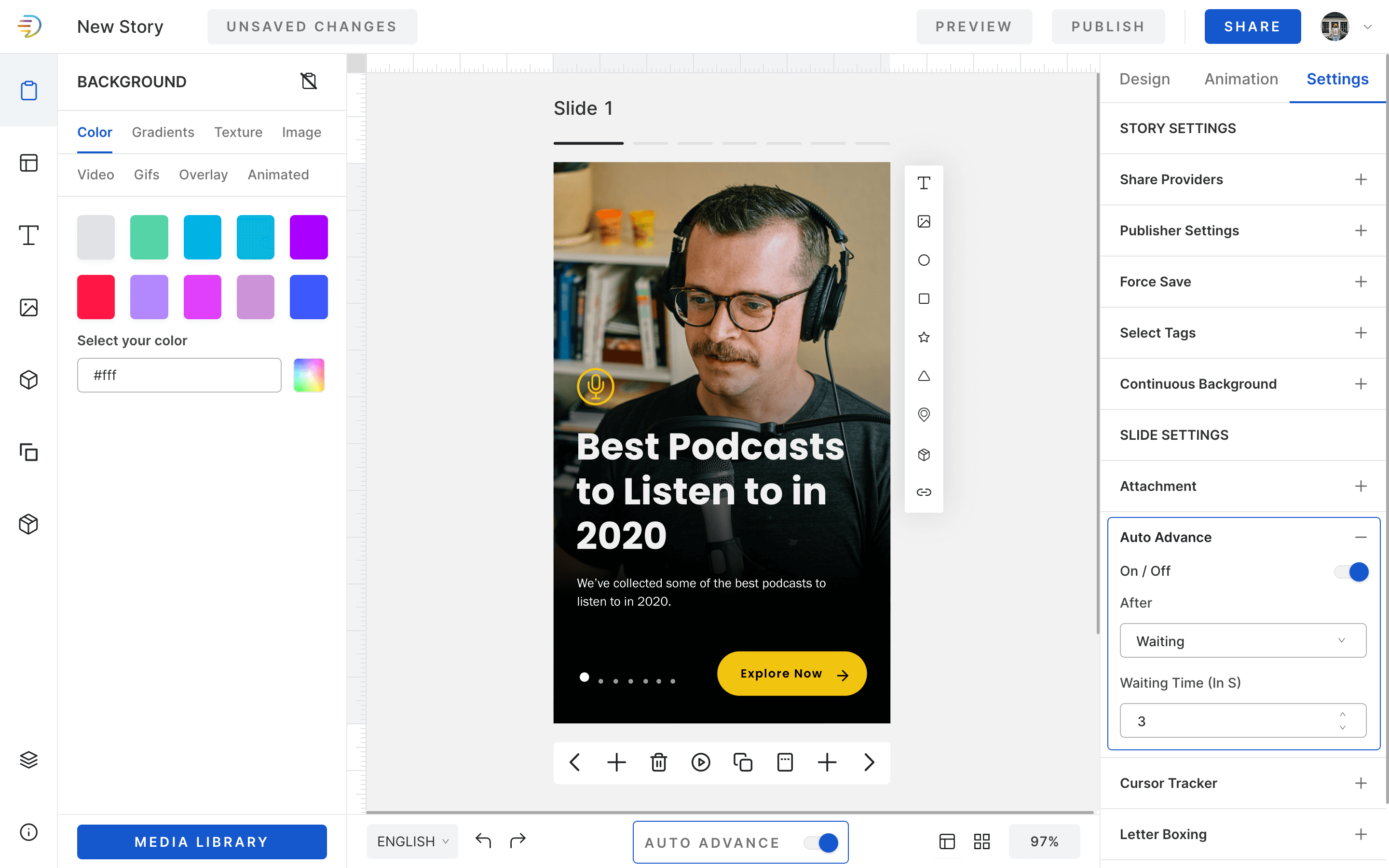
An average adult can read about 4.5 words per second. It is best to base the wait time on the number of words on each slide before it advances to the next one. It is not recommended to keep a standard wait time per slide as some may not take as long to read. Getting the wait time right could be the difference between your viewer staying on till the end versus a viewer dropping off half way through.
2. Send a viewer to the next slide after a video ends
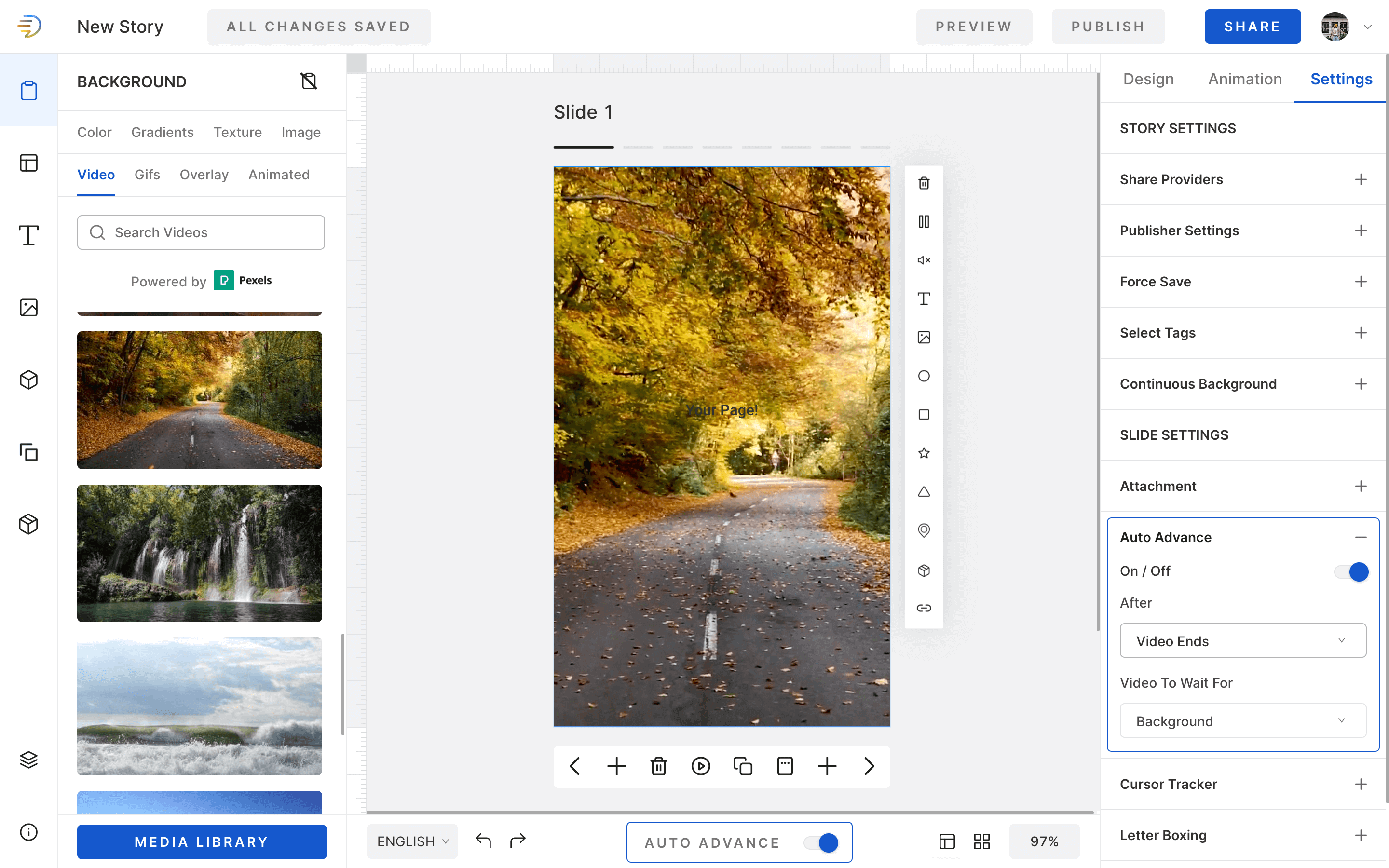
Web stories with video content in them can intuitively move on to the next slide when the video ends. MakeStories allows two videos on each slide. If videos are set to play consecutively, it is best to auto advance after the second video ends. This would avoid any discomfort to the viewer of switching slides in the middle of a video. If the video is set to play first and then text appears, you can add a further wait time.
For eg: 3 seconds after the video ends. Web stories are consumed in a very quick fashion, it’s always better to keep videos between 5-15 seconds, although web stories can handle videos upto 60 seconds too. Read more about how to optimize your videos for web stories here.
3. Send a viewer to the next slide after an animation completes
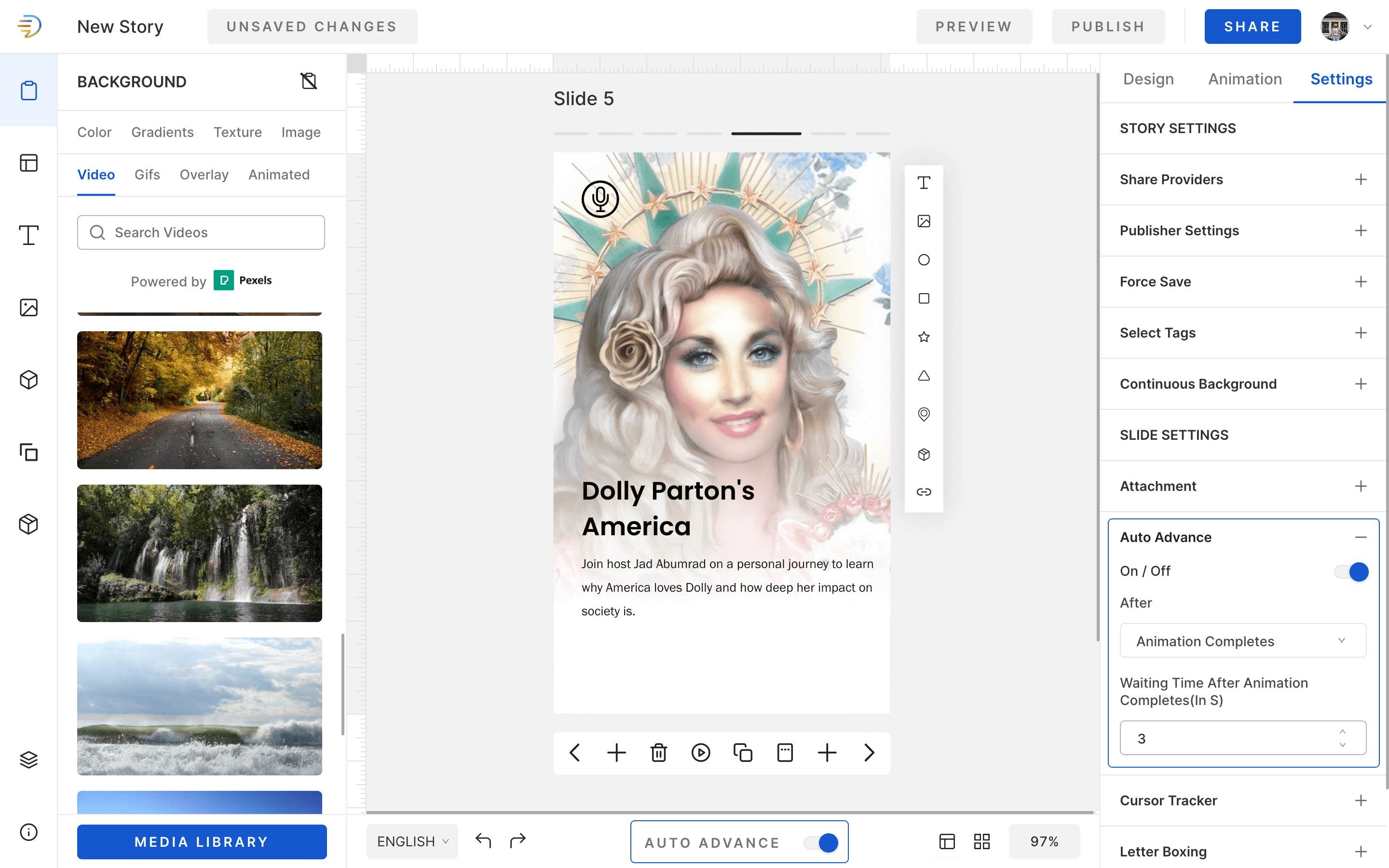
MakeStories has a plethora of animated elements and animation features. They help web stories stand out from the crowd. Generally, brands only have 1 second to grab a viewer’s attention and animation can certainly do so. On a web story, viewers can enjoy an intuitive, hands free experience if the slides are set up to advance after an animation completes. You can select which animated element is your trigger to start the waiting time.
For eg: 3 seconds after animation ends. This could be a text animation, animated image or an animated element.
Auto Advance is a very unique web story tool. The ability to switch between video slides, image slides, quote slides, and text slides during the story without tapping make your story much more unique.
2 Sep 2022, 9:22 am
How to Use Analytics to Boost Web Story Performance

“How do I know if my web stories work?” The most common question for anyone that’s new to web stories! If you’re a blogger or a marketer and you use web stories, you’d want to know exactly how they’re performing. How many people are viewing my story? How many slides are they staying for? How many are reaching the end?
If you’ve ventured into creation and publishing of Web Stories, you may already know that web stories are visual, tappable cards. Much like Instagram Stories but with a key difference – they are discoverable on the open web. Your web stories can show up on Google Discover, Google Images and Google Search, hosted on your own website the entire time.
Do Web Stories have analytics?
Yes, lots of it! Web Stories live in the vast Google Universe and it has 3 distinct ways of being tracked.
- Google Analytics
- Google Data Studio
- Web Story Creator Analytics – eg, MakeStories Analytics
What’s the difference between Website and Web Story Analytics?
You might wonder, the tools seem the same for websites and web stories analytics, so what’s new? Well, web story analytics need a twist in the way you approach them. User behaviour differs for each. On a web page a user may read the top and then scroll down to interact with your Call To Action and that would count as a view and a conversion, whereas in a Web Story, each slide is treated as a separate page because your message is not complete unless the viewer taps on to the next page.
So if your analysis approach for your Web Story is to combine all the page views for one story, it is an inflated view. It will block you from learning the true performance of your web story. Let’s get into how you can optimise your analysis approach to web stories using existing and new tools.
Google Analytics for Web Stories
First you need to set up your GA tracking. Most web story creators have an easy way of connecting Google Analytics. MakeStories, a popular web story creator, has a tab called “Setup Analytics” with a “GA Analytics” field. Simply copy-paste your tracking ID, example: UA-123456-2. That should set you up to track your web story end to end.
How to optimise Google Analytics metrics to Web Stories?
Typically, with web stories we recommend focussing on two levels – Behaviour > Overview and Behaviour > Events.

Behaviour > Overview is a good place to start on Google Analytics to get a zoomed out understanding of your web stories performance. Following are the metrics you will find available.
Please note: Always check the Date Range selection before reading the analytics report.
- Page Views: This will compile over all page views you have garnered. But do note, this number is not enough to give you feedback on the performance of a particular web story.
- Unique Page Views: This indicates unique users who have viewed your stories collectively.
- Average Time on Page: This is a good collective measure to learn how long your users are engaging with your content.
- Bounce Rate: This is a good metric to give you feedback on viewers lost after they landed on your web story.
- Exit %: An exit percentage, although a larger umbrella over Bounce Rate, is often preferred, because it is a percentage in context to how many page visits you get. For eg, if you get 4000 page views but 400 are existing before completing the story that’s a 20% exit rate.
The above analytics are generally something you already may be used to with your website or blogs, but here’s where the stream splits. If you only go by the overview data, you are most probably not getting the real picture of your web story performance.
You need to go deeper. Find out within each story, how many pages are users swiping through, how many users are reaching the end of the story, what is your most visited story, how many ads are being shown on my stories?
Here’s where you can start Story level analytics on Google Analytics events, Behaviour > Events > Overview
An event in Google Analytics are user interactions that do not fit into metrics like page views, exits or bounces. In the context of web stories, user interactions like starting a story, moving to slide 2, clicking on a link, landing at the end page are all unique interactions that need to be tracked by events. Here you can get an overview level idea of how your web story specific events are performing.
Please note: Always check the Date Range selection before reading the analytics report.

- Total Events: This compiles all your events across categories, story starts, story ends and link clicks. Once again, like Behaviour > Overview, this is also not the ideal metrics to get into the nitty gritty. This is good enough just to get an idea over all web story events.
- Unique Events: This will identify only events that occur once in a user session, whereas the above ‘Total Events’ accounts for the number of events across all sessions.
- Event Value: If your event is marked with a monetary value, for eg, a payment or purchase value, then this would indicate the total value of payments. Value x Number of events.
- Average Value: This shows the average value of an event.
- Session with Event: This number tells you the number of sessions with at least one event triggered. This is useful to understand the quality of the sessions.
- Event/Session with Event: The average number of events per session with event.
Now that you have a grasp on your events over all performance, let’s move on to individual stories. Start with Behaviour > Events > Top Events
Please note: Always check the Date Range selection before reading the analytics report.
Top Events is the section where you can really break down your analytics into story level and page level numbers. Here you will find three sections that must be analysed Event Category, Event Action and Event Label
1. Behaviour > Events > Top Events > Event Category
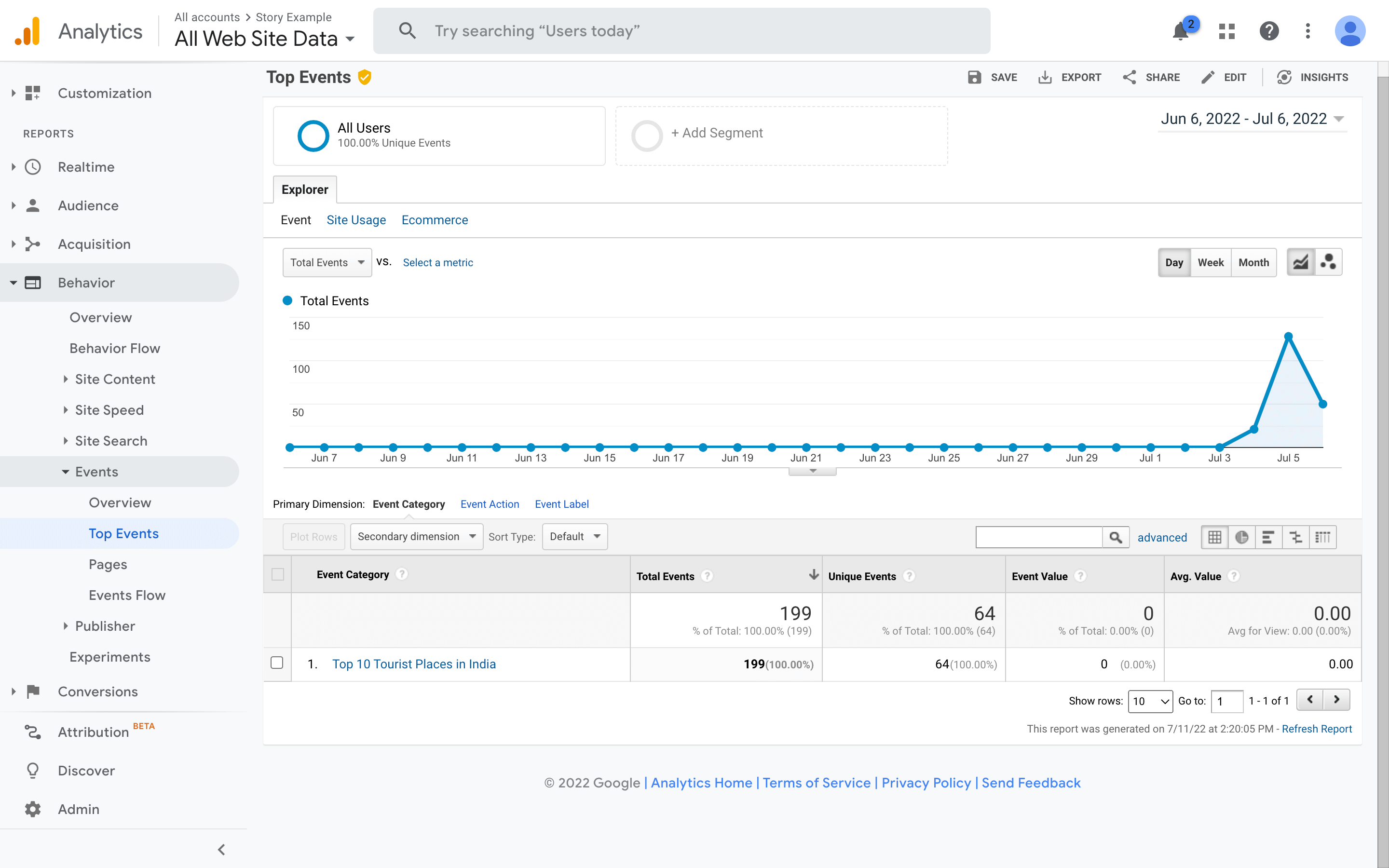
Event Category is the section where you will find all your stories listed by popularity of events. For each story you will find 4 metrics on this page, Total Events, Unique Events, Event Value and Average Value. As we learnt above, these metrics communicate event related triggers that you have set up for your web stories.
This section helps you find patterns between stories. It can give you answers to questions like, which web story had more events triggered? Which story had more unique events take place? Which story had higher event values? Marketers use these metrics to identify relationships between performance and story topics, story publishing dates. Are certain topics more popular? Are certain topics performing better on weekends? Are certain topics getting more events but lesser value?
2. Behaviour > Events > Top Events > Event Action

Event Action consolidates all the events taking place on one particular story. Story Starts and Story Completes are default metrics available to all. But we recommend adding in custom events for link clicks or CTA clicks.
- Story Starts: This metric tells you how many users have started a web story.
- Story Progress: This specifies the number of pages your viewers are viewing in your web story. If you’ve successfully brought in a viewer, how long are they staying? If they are dropping off too early, go back and analyse your narrative. Figure out if you’re using too many slides? Is your content not legible?
- Per Page Events: We recommend setting up events per page of the web story as well. Like the image below you should be able to view events on each web page to drill down into page performance, and not just story performance.
- Link Clicks: If you have links added to specific pages/slides on your web story, create an event for each link clicks. This can also give you great insight into which pages are more likely to get users to click.
- Story Completions: A distinct success rate of viewers who have finished viewing your web story and reached the end. If you have a call to action here or a Book End slide with your social, create an event for them too.
3. Behavior > Events > Top Events > Event Label

Event Label gives you a breakdown of all the events taking place on each page of one story. For each page you will find 4 metrics on this page, similar to Event Category: Total Events, Unique Events, Event Value and Average Value. These metrics tell you events triggered per page or per slide of each web story.
This section helps you find patterns between pages. It can help you understand which pages are performing best within one web story? Which page is getting more clicks? Which page seems to have viewers dropping off? Marketers use this data to find patterns of the average number of slides to use in a web story, the right slide to add links to drive clicks. T hey analyse text, design or layout of pages/slides that are performing well.
If you want to create more custom analytics, you can refer to this AMP analytics documentation to get started.
How to check if my Web Story is working on Google Analytics?
The easiest and fastest way to check this is to view the Real Time section on Google Analytics. If your events are getting triggered, you are in the clear. Your web story is being tracked!
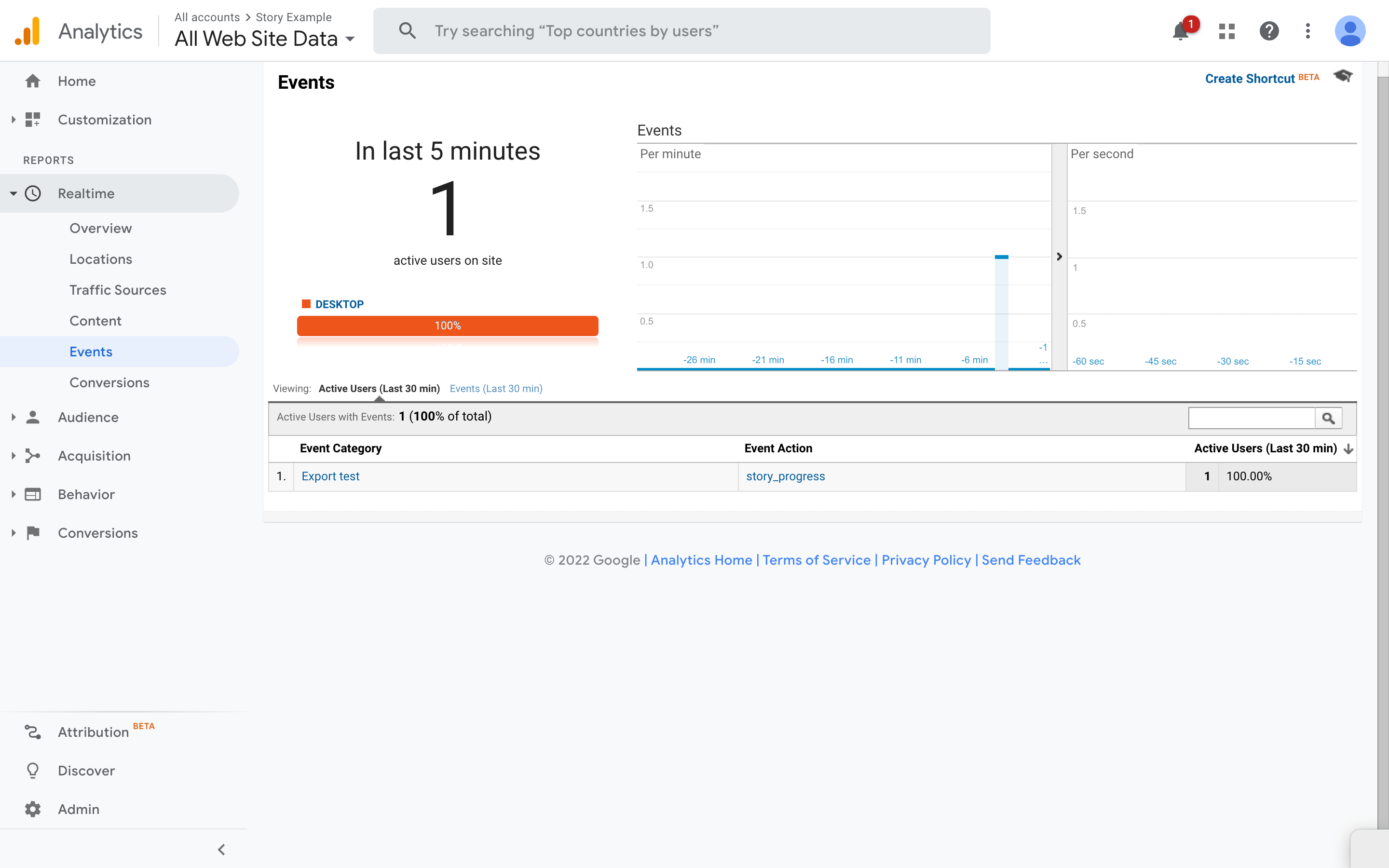
Google Data Studio for Web Stories
Some of you might be wondering, why use both Google Analytics and Google Data Studio to track your web stories? Both tools have similar roles but offer unique value to your analytics journey. While Google Analytics is numbers driven, Google Data Studio is visuals driven.
There is an overlap in the web story analytics that Google Data Studio presents because it links to your Google Analytics Account for data. But Google Data Studio can also go beyond Google Analytics and connect to other analytics from social, ads, CRM and more.
More importantly, Google Data Studio has introduced a ready-made dashboard for Web Stories.This dashboard is like a template customized to Web Stories. It will pull out all your information from the various connected sources and present your data to you. You can find the template here.
How to set up Google Data Studio with the Web Stories template?
Click the template log in with your Google account that has access to Google Analytics. Follow the verification steps and click on the Analytics icon.

Click ‘View’ in the drop down and ta -da! Google Data Studio will pull out all our web story data.
What Web Stories metrics can you track on Google Data Studio?
Because Google Data Studio has a dashboard for Web Stories, it already understands the two levels of metrics. This template will show you: Overview and Story Level.
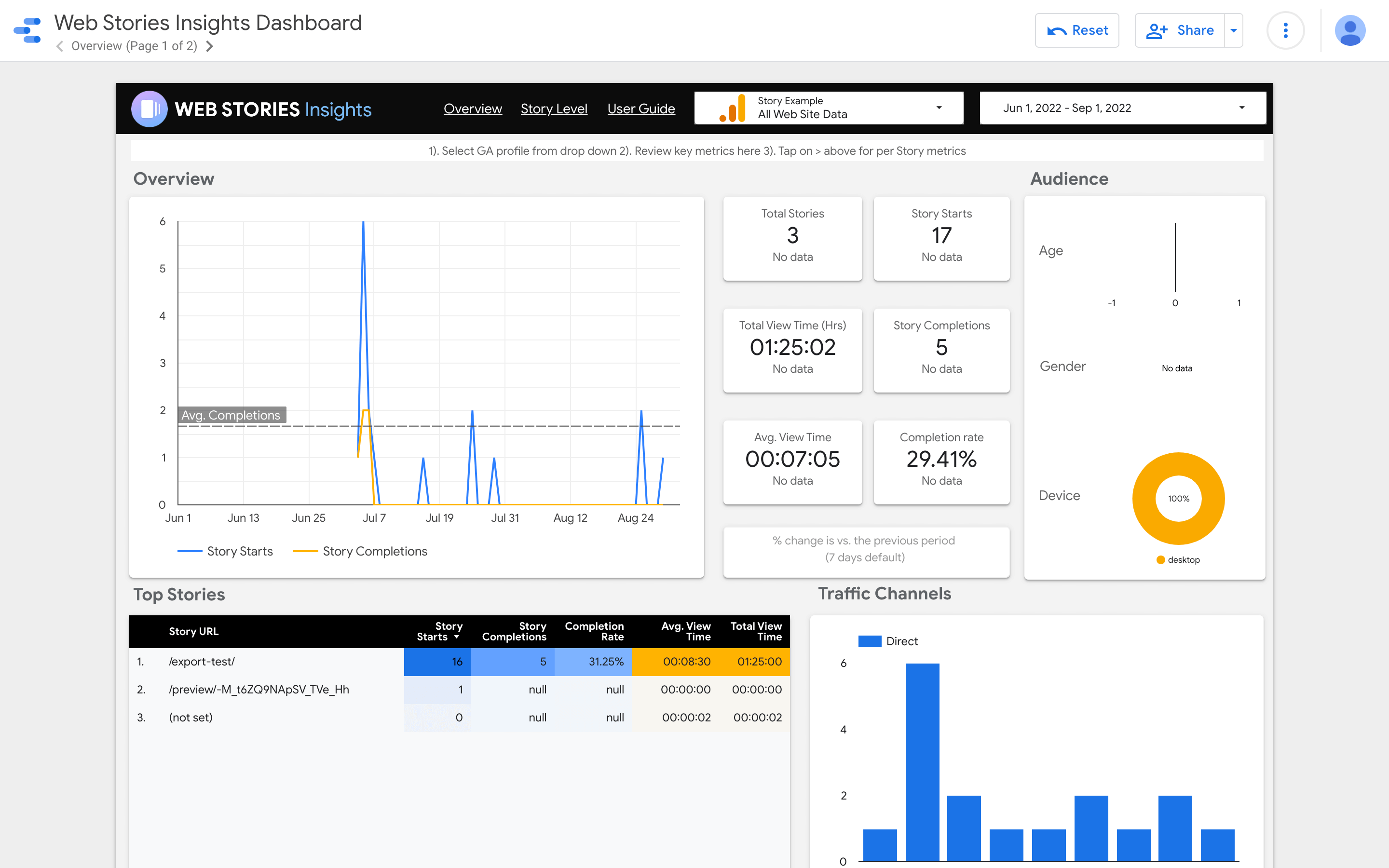
Please note: Always check the Date Range selection before reading the analytics report on Google Data Studio
‘Overview’ Level Web Story Analytics on Google Data Studio
-
Key Metrics:
- Story Starts: This metric shows you an average of how many users started your web stories
- Page Views: This metric measure average page views of all your web stories
- Time Spent: This metric reflects the average amount of time spent on all your web stories
- Completion Rate: This metric is an indicator of how many percent of users are completing your web stories.
-
Audience Metrics:
- Age: Get an insight into the age groups that your stories are resonating with. Sharpen content towards this age group for more views and conversions.
- Gender: Get a visual breakdown of the genders that are interacting with your all web stories.
- Device breakdown: View the break up of desktop, mobile and tablet device modes most popularly used to view your web stories. Although web stories are mobile-first, there are simple ways to make them desktop and tab friendly too.
- Top Stories: Google Data Studio also allows you to analyze your top stories within certain time periods.
- Traffic Channels: A crucial metric that reveals where the traffic to all your web stories are coming from. This insight once carried into further strategy can help maximize reach and clicks.
‘Story’ Level Web Story Analytics on Google Data Studio
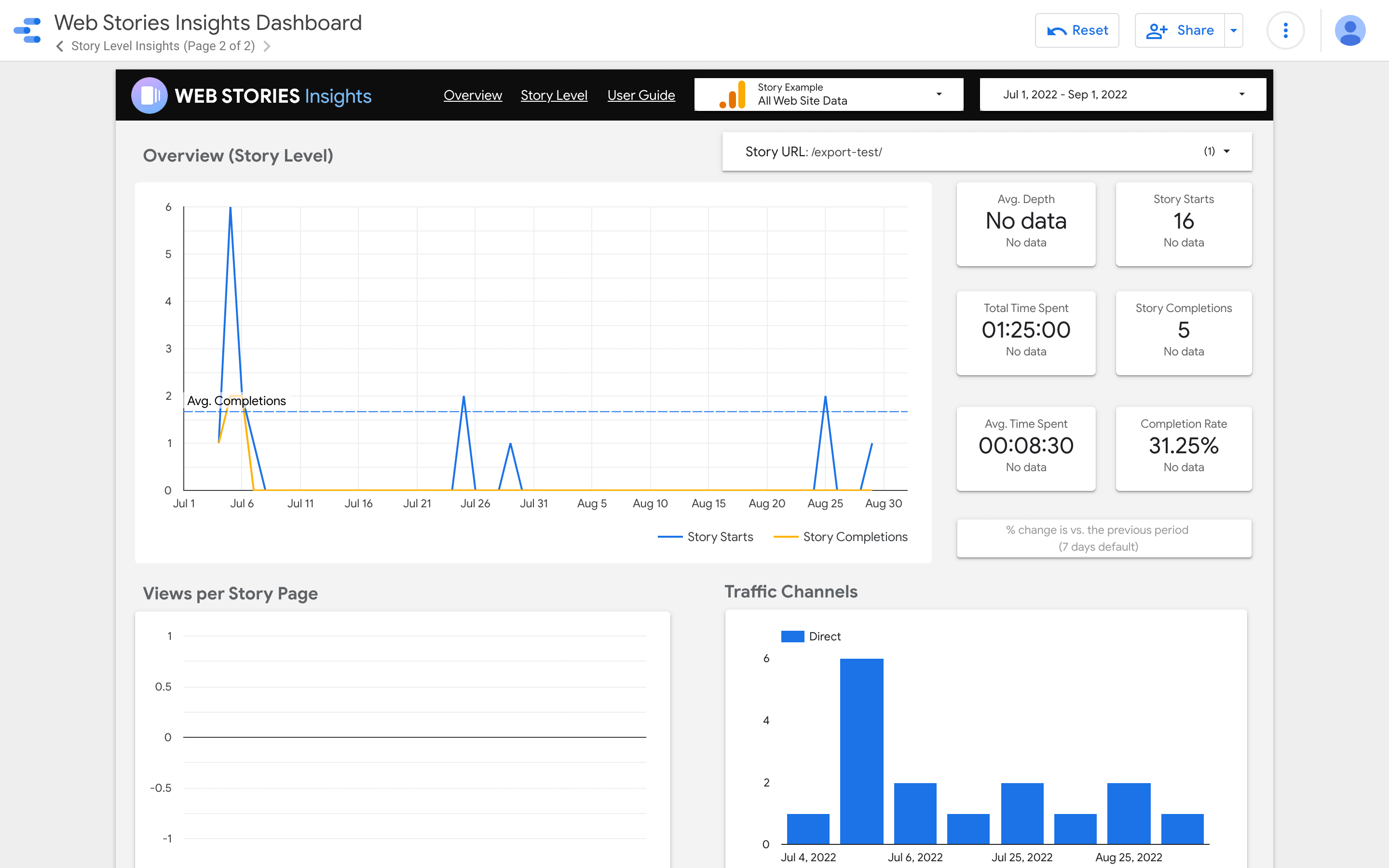
-
Key metrics:
- Story Starts: This metric shows you an average of how many users started a specific web story
- Page Views: This metric measure exact views per page in a specific web story.
- Time Spent: This metric reflects the average amount of time spent on a web story.
- Completion Rate: This metric is an indicator of how many percent of users have completed a web story.
MakeStories Analytics for Web Stories
Web Stories are best created and shared from web story specific builders as they already have many features inbuilt, including analytics. MakeStories is one such free web story builder. MakeStories, for instance, has it’s own story analytics but also allows you to connect tracking IDs for Google Analytics, Facebook Pixel or any other Custom Analytics tool.
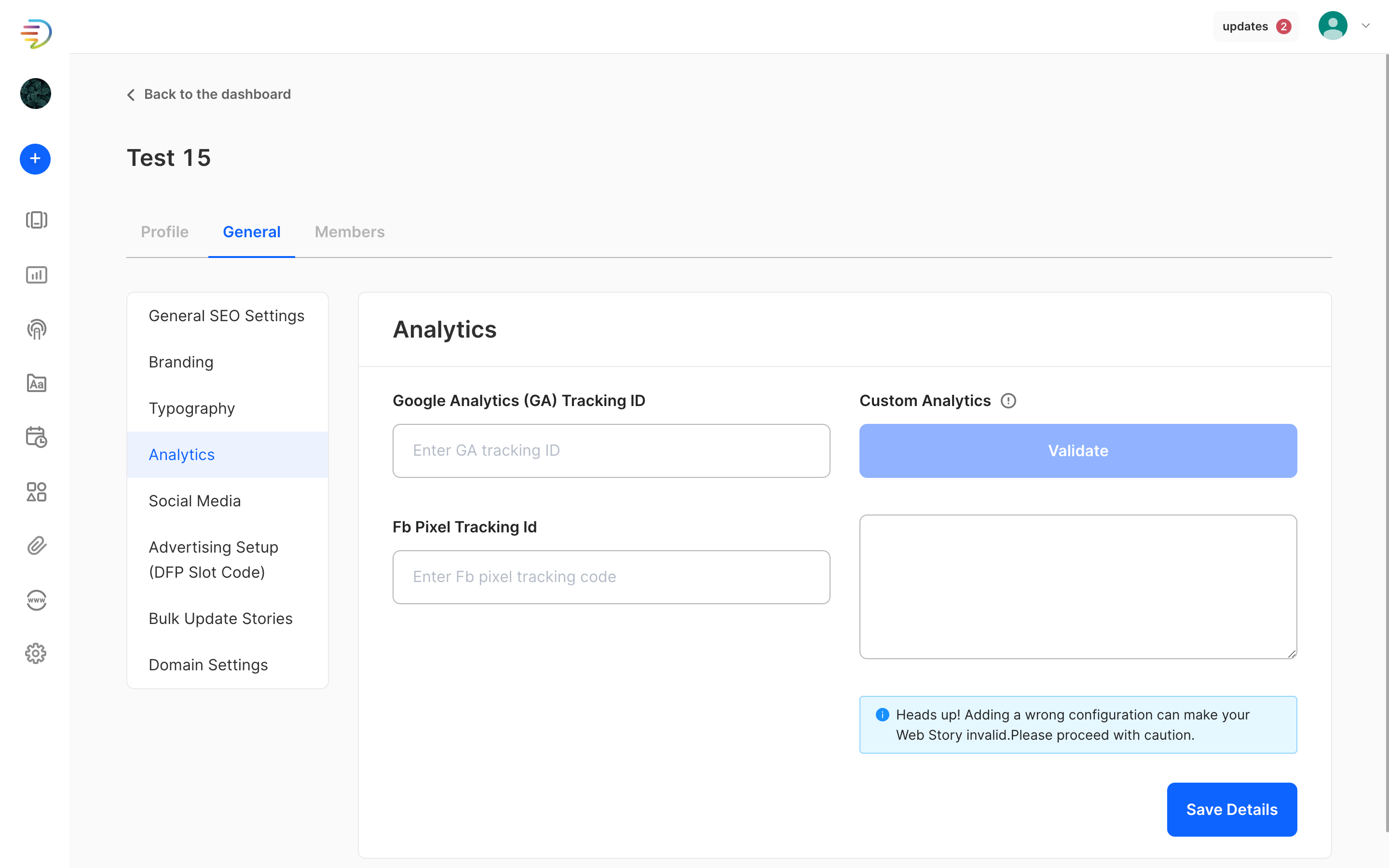
To set up your analytics on MakeStories go to the menu on the left and select General Settings. General Settings > Analytics is where you can simply paste your GA tracking ID and FB Pixel ID.

What Web Stories metrics can you track on MakeStories?
Since MakeStories is solely a Web Story builder it has inbuilt detailed analytics across Users, Sessions, Story and Page level analytics that help you stay on top of your story performance. To view your analytics go to the menu on the left and select Analytics.
Please note: Always check the Date Range selection before reading the analytics report on MakeStories.
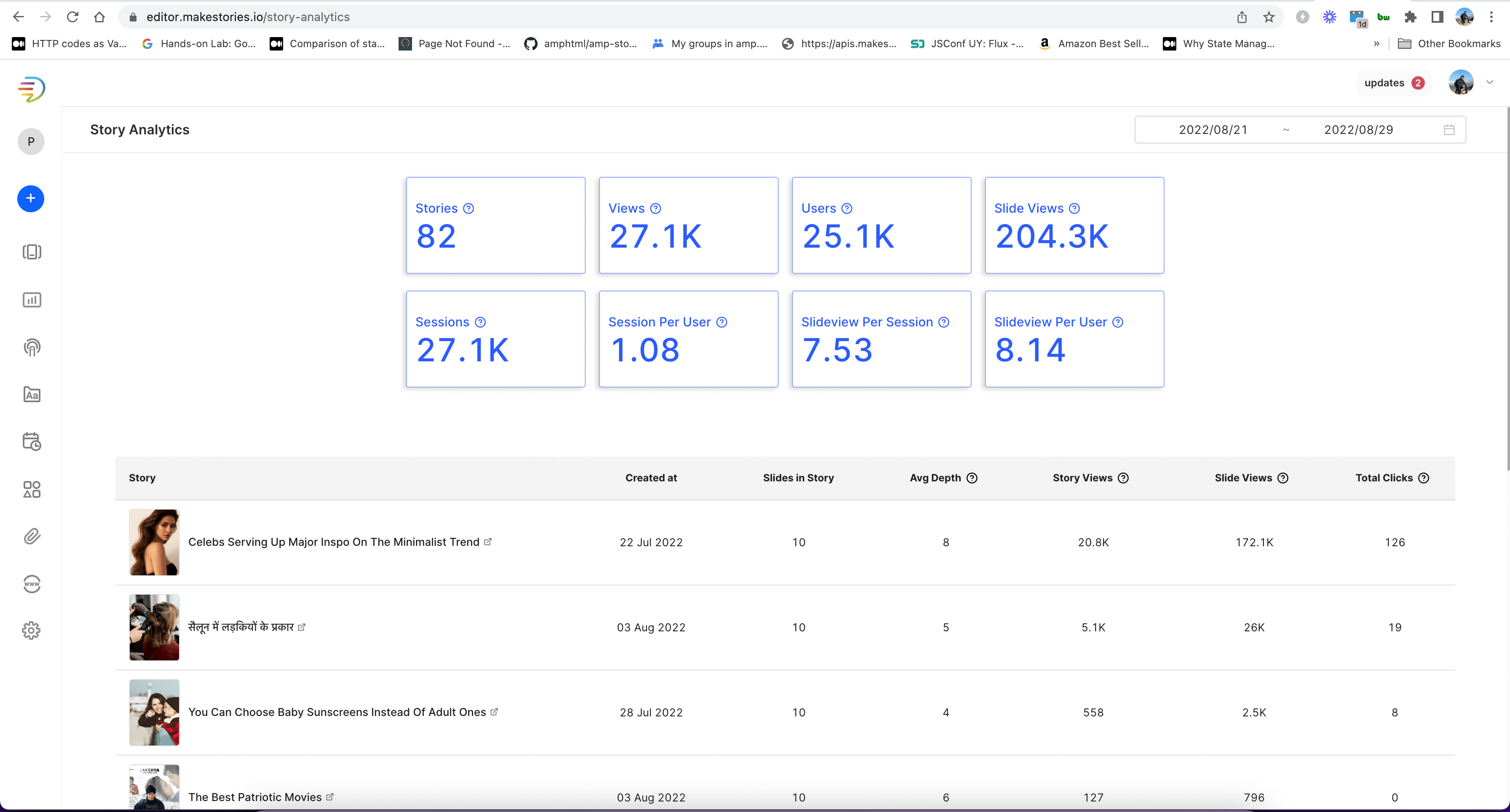
Their metrics include:
Total Story Metrics within a date range
- Stories: Find the unique number of stories you have published
- Views: Get the total number of unique views all your stories together have garnered
- Users: Find out unique number of users who have viewed your stories
- Slide Views: Get total number of slide views cumulatively for your stories
Total Sessions Metrics within a date range
- Sessions:Find the total number of unique sessions by users
- Session per User: Get the average number of sessions created by a user
- Slideview Per Session: Learn average number of slide views by per session
- Slide View per User: Get the average number of slide views per user.
Story Level Analytics
- Created At: This keeps you on track with your publishing schedule. Just like blogs or social media content, consistency is important even for Web Stories.
- Slides in Story: Track the number of slides on each story. This makes it easy to find patterns between number of slides and average depth, slide views and clicks.
- Average Depth: This metric allows you to analyse the average number of pages users are staying for in one web story. If Average Depth is low it means the content is not engaging enough to hold them to the end.
- Story Views: This tells you the average story views for the particular web story
- Slide Views: Slide Views gives you average views on each slide
- Total Clicks: Total clicks tracks your link or call to action button on your web story. Many publishers have found patterns between link clicks and number of slides in a story.
Each of these tools and their metrics give you more control over your web story performance. All that’s left to do is figure out what’s working and not working for your web stories. Sometimes, it only takes a few tweaks to catapult performance. Read between the lines with your analytics and most importantly, always think of your audience first.
18 Aug 2022, 9:16 am
Created a Google Web Story, but not getting any clicks? Here’s what to do

You were happy with your web story when you published it but now feel like you are not getting the user engagement you expected?
According to a Forrester survey published in July 2021, 89% of publishers of Web Stories have reportedly increased user engagement for their brands. Web Stories have risen to prominence as a new way for people to consume content. Customers are more engaged with web stories than text stories, according to the survey.
So, why aren’t your web stories getting enough views or clicks? It’s possible that one of the reasons is that your poster and cover images aren’t optimized.
Let us understand them individually and the difference between the two.
What is a Poster Image?
For a web story, a poster image serves as a thumbnail image. If you’re unfamiliar with the term “thumbnail image,” it’s the preview image that appears next to a link to an article or a web page. You can find it on Google Search or Google Discover Carousel. A compelling thumbnail image will always attract a viewer or buyer to click. It creates the first connection either through relevance of content or it may look too enticing to pass up on.
For Google Web Stories, an eye-catching poster image can be created using online editing tools such as MakeStories. This free platform is built specifically for the creation of web stories. You can design web stories and publish them directly to the web. There are a few simple things to remember with respect to creating a Poster Image:
- Only static image: A poster image is restricted to having only an image and no videos or interactive elements.
- High Quality: Ensure the image used is a high-quality image. In case you do not have your own images to upload, MakeStories provides a large library of HD images optimized for the mobile format.
- Format: Use .jpg, .png and .gif formats for poster images, vector files such as .svg and .eps are better avoided.
- Match the storyline: Select an image for the poster that sets the right expectation for the viewer from the get go. Match it well with the rest of the story to avoid disappointment.
- Vertical Orientation: Use images that are of portrait or vertical orientation, avoid landscape orientation images on the poster image. The recommended aspect ratio is 3×4 with a minimum size of 640px x 853px.
- Add a web story icon: Place a web story icon at the top or bottom, left or right corner of your web story so a viewer can instantly differentiate your content. The icon is symbolic of the tappable nature of the content, it is best to keep the icon location consistent.
- Colour Overlay: Adding a colour overlay on the poster image can make the text much more legible. The text can get lost in the image if the image is too busy in the background.
- Short Headlines: Viewers are used to scrolling through content very quickly. Keep your headlines concise enough for the right audience match to stop scrolling and click your web story. This messaging should be different from the title of your web story.
- Branding: The poster image showcases your brand logo and publisher details. With MakeStories, these details can be added prior to designing your poster image.
Learn to create your poster image using MakeStories here.
What is a Cover Image?
A cover image is the first slide or page you make for your web story. It is the introduction to your content. When a person clicks on your poster image, you’ve already succeeded at bringing the user into your content, now it is up to your cover image to ensure the user continues to read your web story. This is the first page of your web story. Unlike the poster image, a cover image can have interactive elements in the form of videos, animations, audio. Etc. MakeStories, a leading web story editor, can guide you in developing interactive web stories. If not done manually, MakeStories will pick the best cover image for your story based on the designs you’ve generated.
Here is a quick table to highlight the differences between a Poster Image and Cover Image
| Poster Image | Cover Image | |
|---|---|---|
| Design | Can add only Images. | Can add images, videos and animations. etc |
| Placement | Shows on Google Search or Google Discover Carousel. | First page of the web story. |
| Text | Add limited messaging on the bottom third of the page. | Can add title and text limiting it to 280 characters. |
| Branding | Will show brand logo, publisher details, text and image. | Can manually add logo, text and images. |
Optimizing these images can help improve the click rate and get users to engage with your web stories. Create your first cover image using MakeStories here.
Related Questions
Can we add videos to a poster image?
No, Poster images can only have images in a web story, whereas Cover images are allowed to have images, videos and animations as well.
11 Aug 2022, 11:49 am
How to optimize your Google Web Stories on Discover with MakeStories

This is a guide to optimize your Google Web Stories on Discover.
Getting your web page to rank on Google is a hard nut to crack. Google’s algorithms are constantly changing and brands have to keep up with fresh compliant content as well as optimize older content. The same strategy applies to Google Web Stories to rank your content higher in SERPs.
Web Stories appear on Google Discover carousel, Google Search or on Google Images. Understanding a user’s search intent is critical to getting your web story to rank high on Google.
Let’s dig deeper into how to make web stories rank higher on Google Discover.
An overview of Google Discover
Google Discover, formerly known as Google Feed, presents content curated for a user based on their search history. It is typically a mix of articles, images, videos and most recently, web stories. This curation is put together by Google’s automated systems and the user’s browsing history. Each person’s Google Discover page would be unique to their search behaviour, most often your Google Discover page will have ready curated content from your more recent query or search.
Google Web Stories on Discover
Web Stories are a tap through content format that many marketers are adopting. This is especially true given their incredible success on platforms like Instagram and YouTube, popularly known as Instagram Stories and Youtube Shorts. They are vertical slides with images or videos on them, optimized for mobile viewing.
On Google Discover, users can find content packaged in a similar format based on their prior search history. Web Stories can pop up about food, travel, and current events. They can simply click one and tap through the content. Web Stories are being used increasingly by a number of marketers as part of their overall marketing strategy.
Web Stories are not difficult to create. Third-party tools such as MakeStories make it very simple. MakeStories is an end to end solution to create, publish and share Web Stories directly. It is a free, drag and drop creator. It even lets you monetize your Web Stories. Learn more about how to use MakeStories here.
Optimize your Google Web Stories for Google Discover
With MakeStories, you can create immersive Web Stories optimized to appear on Google Discover carousel. This is how:
Comply with content policies for Google Discover
It’s vital to comply with content policies. The most important being copyright content. Copyright content in the form of images, videos or audio is not allowed, according to general policy standards. If Google discovers a copyright breach, they can remove your web stories from the search results. Here’s a link to the Discover content policies in detail.
With MakeStories, the compliance validation is built into the platform. Before publishing your web story on the web, MakeStories takes you through 4 steps to ensure you are compliant. The four steps are as follows:
Adding the publisher details – You have to fill in publisher and domain details.
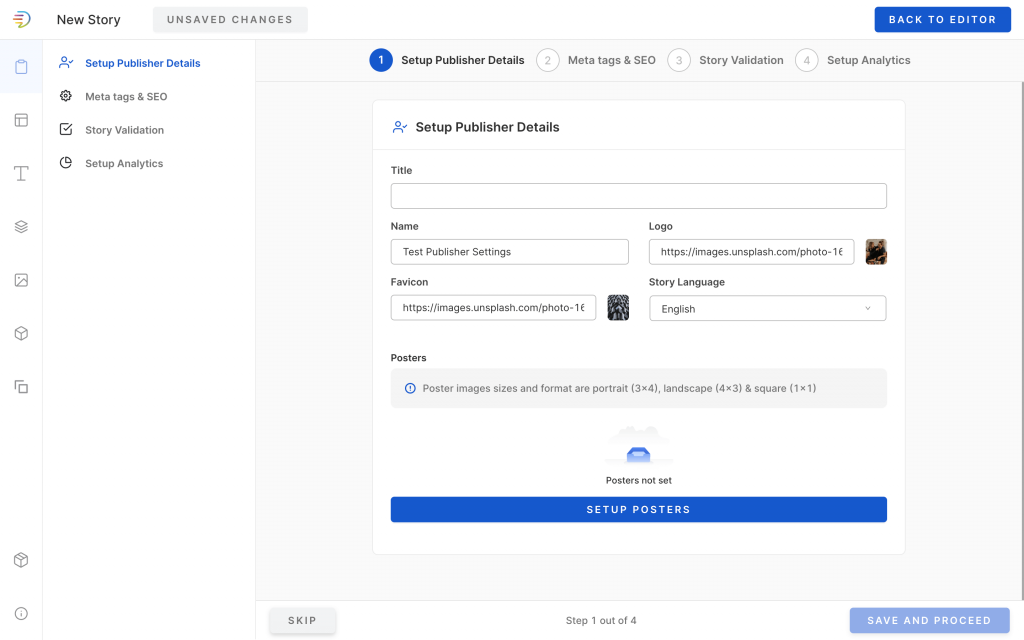
Adding Meta Tags & SEO – You have to add in your primary keywords and optimize your meta title & meta description to ensure visibility
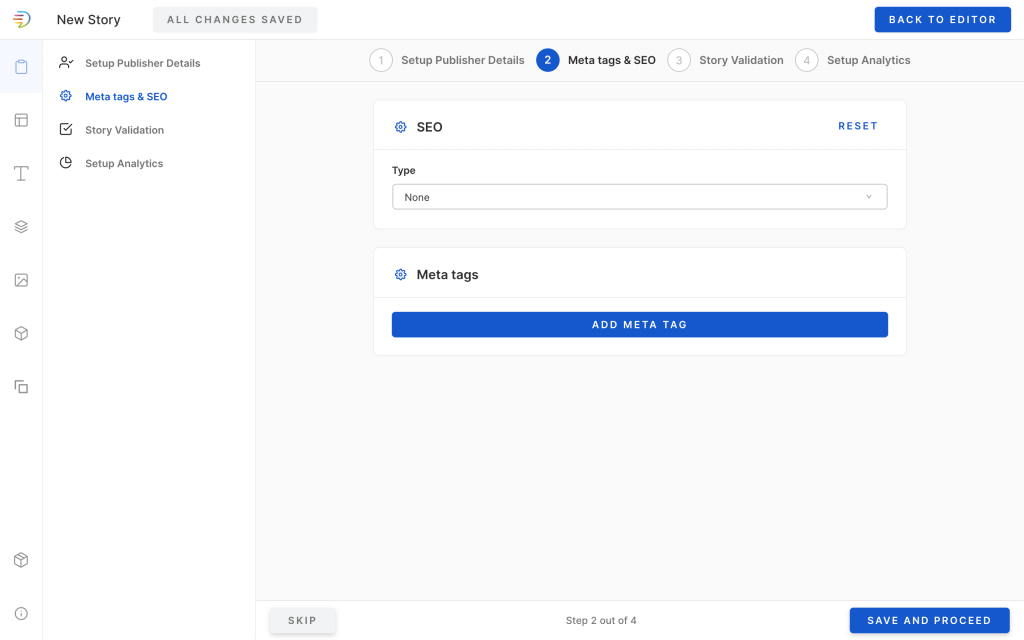
Validating your Story – You have to confirm you meet the basic criteria of text and character limit of over 500 characters
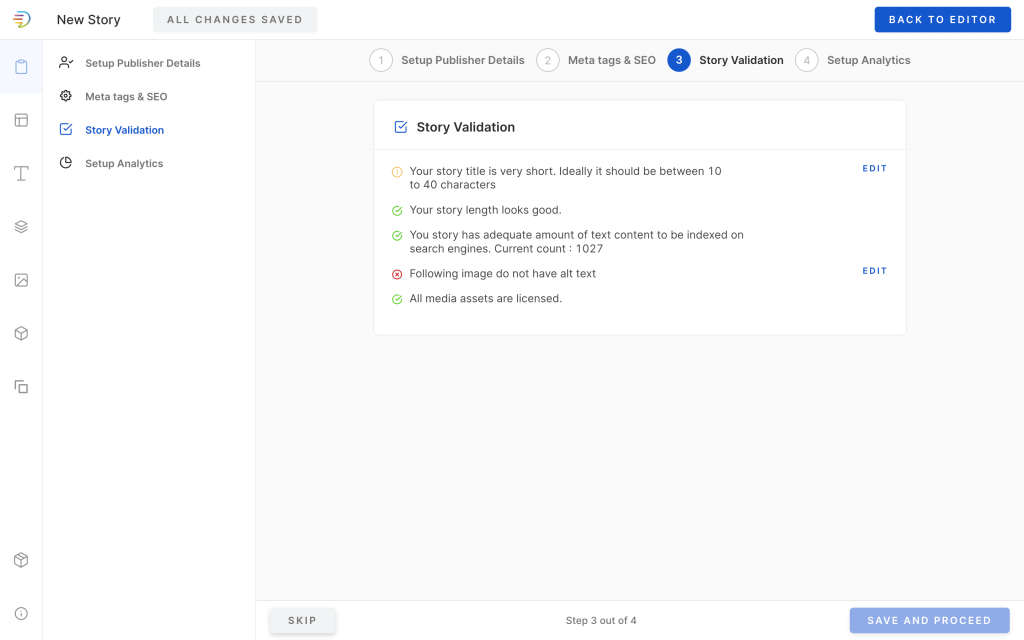
Setting up Analytics – You can connect your analytics to track how your web stories are performing.
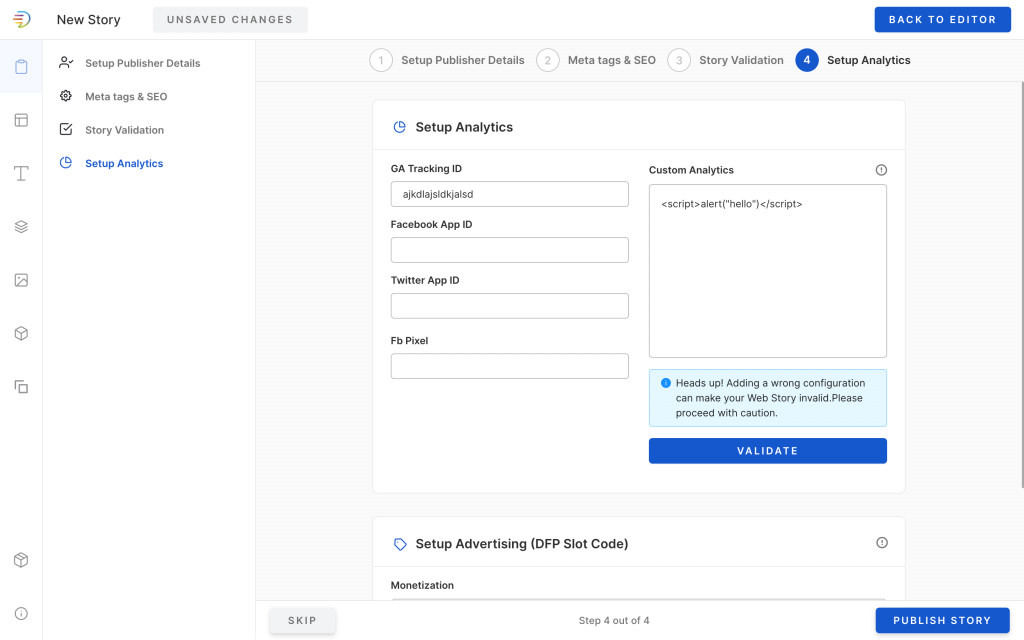
Without completing the steps above, MakeStories will not allow you to publish your Web Story. This ensures your Web Story is already pre-optimized and compliant. Click here for more information about using MakeStories to publish your Web Stories.
Create content that is both original and engaging
Your target customer profiles want to consume relevant content in a fun and interesting format. They will click on your content only if you provide relevant content with a unique viewing experience compared to the story next to yours. Keeping in mind web stories are mobile-first viewing, pick visually appealing content. MakeStories suggests the following tips on design and content selection:
- Keep it short: Web Stories are swipeable or tappable cards. Users are used to swiping and tapping through content fast. Design a clear narrative and break up the content journey seamlessly across the number of cards you choose.
- Title Characters: Web Story Titles have to be within or lesser than 90 characters
- Text per Card: Make sure your overall text per page does not exceed 200 characters
- Striking Layout: MakeStories has a variety of built-in elements like web story templates, fonts, images, and videos to make your stories more immersive.
- Be Interactive: Add quizzes and polls with MakeStories Add on feature to get users to connect with your stories
- Add CTA: Add a call to action, yes you can direct links to each page. MakeStories suggests one URL per page is best practice.
- Number of slides: A minimum of 5 slides for your web story and a maximum of 12 slides are ideal
- Duration: If your story is video based, limit it to 60 seconds
- Keep it casual: Let your content seem native to the discover page. Do not make your content sound too promotional.
Improve EAT signals
EAT stands for Expertise, Authoritativeness and Trustworthiness. It is a vital quality factor for a web page to demonstrate EAT to increase its credibility. This helps the web page rank higher on Google Discover. To understand this further, click here.
In the general settings, MakeStories provides a section to add your branding details. This includes adding your brand name, industry, logo, brand colours, brand fonts, etc. Adding in your branding details and completing the publishing with SEO details can help enhance your EAT.
Optimize your poster image
A poster image is like a thumbnail image that you add to YouTube videos or a cover that you add to your Instagram Reels. It’s the static image with a catchy title that entices your viewers to click on your Web Story. A good poster image can increase the number of clicks on your story.
- Dimensions: If it doesn’t fit, don’t force it. Create posters that fit the Web Story dimensions perfectly. Recommended aspect ratio is 3×4 with a minimum size of 640px x 853px.
- Vertical Orientation: Web Stories are optimized for mobile viewing, they work best with images that are of portrait or vertical orientation.
- Format: .jpg, .png and .gif are acceptable formats for poster images, vector files such as .svg and .eps are better to steer clear from.
- Match the storyline: Select an image for the poster that sets the expectation for the viewer from the get go. Match it well with the rest of your slides or video.
- Proportionate Rounded Corners: Round the corners of your poster image in proportion to the poster image width. If your image is < 100px round the corner to 8px, for an image that’s 100 px – 240px round it to 16px and for an image < 240px ideal corner should round to 24px
- Stack Lines: Stack Lines make your poster image pop! They also add a bit of depth to your swipeable stack of web stories. Stack colour selection should ideally move from dark to a lighter tint. For eg, your first stack line can be a dark blue and the second stack line should be a lighter blue for the right impact.
- Add a Web Story icon: Place a Web Story icon at the top or bottom, left or right corner of your web story so a viewer can instantly differentiate your content. The icon is symbolic of the tappable nature of the content, it is best to keep the icon location consistent.
- Colour Overlay: Adding a colour overlay on the poster image can make the text much more legible. Pick the colour thoughtfully so it makes your cover look more aesthetic.
- Short Headlines: Viewers are used to scrolling through content very quickly. Keep your headlines concise enough for the right audience match to stop scrolling and click your web story.
MakeStories has stylish, modern templates ready to use for poster images. You can pick templates and customize them in minutes to match your content or brand.
Related Questions
Do Web Stories only show on Google Discover?
Web Stories appear on Google Discover carousel, Google Search or on Google Images.
What is the poster size for Web Stories?
Recommended aspect ratio is 3×4 with a minimum size of 640px x 853px.
Why creating a Google Web Story with shorter videos can boost campaign performance?

More than ever, marketers are using the multi-channel marketing approach to carry out a successful campaign. The creation of creative content is a key component of any campaign’s success.
According to a study conducted by Havas, 84% of consumers expect brands to create unique content. People desire information that engages them through storytelling, offers practical solutions, and entertains them. They want to be able to digest this information as quickly as possible in addition to it being engaging. With higher levels of user engagement, improved SEO results and an increase in ROI, marketers are convinced that Short Form Videos are the future.
Short form videos are essentially creative videos made within a 60 second time frame. Aside from the duration of such short videos, the trend and culture are other factors that make them more appealing and cost-effective. Because of this, 87% of marketers are using and actively investing in short form video content when developing their campaigns.
Social media is used by 4.62 billion people daily and Google is used by 8.5 billion people daily. To expand your brand reach on Google, Web Stories are the way to go.
The best tool to produce and publish both Web Stories and short form videos is MakeStories, a well-known online web story editor. It is a free Web Story creator, built-in with templates, video libraries and SEO optimization.
In case you don’t know what a Web Story is, here is a quick reference for you.
What is a Google Web Story?
A web story is a relatively new content format available on Google. It is a series of tappable or swipeable cards that fit the mobile format. They are displayed on Google Search, Google Discover and Google Images. Web Stories can have a variety of visual elements, including texts, images, and videos. Click here to learn more about Google Web Stories and its advantages.
Best Practices for Web Story Video Content
- Size: Web Story video content should not be above 4MB in size. Web Stories are meant to be consumed quickly for which they must load quickly as well. Video sizes upto 4MB can comfortably be viewed on web stories.
- Duration: Web Story video duration is recommended between 30 to 60 seconds for captive viewing.
- Vertical Videos: Web Stories are made for mobile. Video content in the portrait or vertical orientation in the aspect ratio of 16:9 is ideal for viewer satisfaction and ease.
- Video Format: MP4 video format is compatible with all platforms and browsers that host Web Stories.
MakeStories for Short-Form Videos
MakeStories has all the required video editing tools to help you improve your videos for social media, whether it be a behind-the-scenes video, a product promotion, or a human first contact. The video tools available are:
- Adding your own Video file – Go to your MakeStories dashboard and select Create a New Story. Add all the information that is requested. On your left, click Media Library. Use the Add New Media option to accomplish this. You can do this to add a video URL or upload an existing video file.
- Access Pre Filmed Videos – MakeStories offers you a wide selection of free videos to pick from if you have a concept in mind but don’t yet have a ready-made video. These videos are powered by Pexels. If you have a registered account, you even have the choice of integrating Getty Media for videos.
- Select Frame – Once you have uploaded your video, you can use MakeStories’ multiple features to enhance your video. Before you publish, it also allows you to select a frame from your existing video as your cover image.
MakeStories for Web Stories
MakeStories is an online platform to create, edit and monetize Web Stories. With MakeStories you can directly publish your Web Stories to your website while ensuring they are SEO Optimized. Learn more about creating web stories with MakeStories here.
Related Questions
What is the maximum video file size for Web Stories?
Web Story video content should not be above 4MB in size so it can load fast.
What is the aspect ratio for Web Story videos?
Web Stories Video content in the portrait or vertical orientation in the aspect ratio of 16:9 is ideal for viewer satisfaction.
Top 5 Blogging Industries that must create Google Web Stories with MakeStories

What began as an online diary in 1994, eventually became a profession estimated to become a $417.85 billion global industry by 2025. That’s blogging for you.
According to Hosting Tribunal, there are over 600 million blogs across 1.9 billion websites on the web today. Blogging became an outlet for individuals of any age to have conversations and share opinions about their life, work or passion. The evolution of blogging made it a lucrative option for anyone to pursue it part-time or full-time. The more popular your blog, the more opportunities land at your doorstep.
But did you know that getting organic traffic to a blog is one of the major obstacles most bloggers face? 90.63% of pages receive no organic search traffic from Google, according to Ahrefs. To acquire high organic traffic, years may pass. We’ve all heard that a blogging journey will be successful only if you post frequently, create engaging content and build brand awareness. Majority of serious bloggers and brands with content marketing teams ensure they do their best to drive inbound traffic through various tools. But the latest tool, pleasantly surprising bloggers with high traffic is Google Web Stories. Here’s why
With Google Web Stories bloggers can:
- Reach a wider audience as the content shows up Google Discover, Search and Images
- Drive organic traffic to their blog/website
- Repurpose their existing written content and push it out to new audiences,
And so much more! Click on the link to read more about the benefits of Google Web Stories for bloggers. If you are a blogger looking to drive more organic traffic, get a new perspective on content creation or generally looking to explore Google Web Stories for your blog, you are at the right place!
Leading web story editor MakeStories is here to assist you in doing just that. No matter what industry you work in, MakeStories can help you create web stories for your brand, website or company. You can use the tool to edit and produce web stories using your photos and videos, as well as to publish them directly to your website. MakeStories offers you a great way to host your stories if you don’t have a website by letting you use their secure platform.
Here are the top 5 blogging industries that must consider creating Web Stories
1. Travel Blogs
MakeStories offers a simple Tag location tool that can be added to your photographs or web stories with just one click. This makes your story interactive and useful. The user can enjoy your travel web story and directly click to the location, hotel or restaurant you visited. By adding a location tag, your stories will also show up for users searching the location on Google, they may be planning a trip or looking for travel inspiration.
2. Food Blogs
Food Bloggers, web stories are perfect for you. Food Bloggers can easily take their audiences on a journey of cooking, tasting or reviewing food. With MakeStories’ simple image and video editing features, you can show off your food photography and videography. Utilizing MakeStories’ array of filters, you can alter your food photography. You must also add an image alt text to every image you use in your web stories.
3. News/Current Events Blogs
New Publications have been the proven early adopters of the Web Stories phenomenon. They have been able to increase their readership and traffic to websites in the double digits in just a few weeks. Sharing the news or information about current affairs in a bite-sized format has fit in very comfortably with online user behaviour. If you are a blogger in a similar field, if you do share news, current affairs, news analysis you must use Web Stories. There are audiences ready and waiting to find your content. MakeStories has very easy-to-use SEO settings built in to the platform too. Learn more about it here.
3. Health and Fitness
Users are constantly striving to improve their health and fitness. Fitness bloggers may already be creating content on other platforms, now you can repurpose the same content and open it out the world wide web. Bloggers can edit their content using the MakeStories health and fitness templates. MakeStories’s media library can offer you premium images or videos for free to make your web stories appear more professional.
4. Fashion and Beauty Blogs
Another popular blogging industry is the fashion and beauty industry. Users looking for fashion content, love flipping through latest trends, fashion tips and red carpet looks. If you have a fashion blog serving stylish looks, do’s and don’ts, reviews or you have your own fashion or beauty brand. Use Web Stories to reach larger audiences from across the globe. You can directly tag the link to purchase your product on each story slide. MakeStories provides an easy option to add a link. You can update the URL of the product page in the CTA settings. A CTA cannot be added to your cover page. To know more about what a cover page is in a web story, click here.
Why are Marketers including Google Web Stories in their Content Strategy?

Brands now depend heavily on visual storytelling to engage with modern consumers. Marketers are incorporating visual storytelling into their content strategies in a variety of ways. Be it through high-quality images, mesmerizing infographics or crafted videos. With storytelling, you can create relatable content that strengthens your brand’s ethos.
A study by IMPACT suggests that over 80% of internet users search the web on their mobile phones. This is one of the reasons why visual storytelling is essential in the mobile format. There are many forms of visual storytelling on mobile. One in particular is winning over marketers: Google Web Stories!
Google Web Stories – a quick introduction
Google Web Stories, formerly known as AMP Stories, are one of the best forms of storytelling on Google.
Like stories on Instagram and Facebook or YouTube Shorts, web stories are made with the intent of creating an immersive experience while having complete ownership of content
Publishers can increase readership while maintaining their brand identity and generating revenue via Web Stories. It gives you the advantage of reaching out to over 8 billion users accessing Google Search, Discover or Images.
MakeStories, a free web story editor, helps you create, monetize and publish web stories all on one platform. You can learn more about it here.
Why Google Web Stories should be a part of your marketing strategy in 2022?
Let’s take you through how Web Stories can help you in your marketing campaigns.
- Brands have received an added revenue of $132,000 with net-new website traffic driven by web stories
- Organizations have generated ad revenue worth $410,000 through web stories monetization
- Organizations have raised over $60,000 from affiliate links added to their web stories
- Brands have seen a 90% increase in customer engagement with web stories
- This resulted in a 17.2% increase in the click-through rate
- The cost to reward ratio is also encouraging
(Source: Forrester Research July 2021)
Impressed with these numbers? MakeStories has in built features that can help you achieve these numbers and more! Its step-by-step guide can help you navigate through building your creative narrative. With MakeStories, you can improve the performance of your stories on the web with its mandatory publishing setting.
This makes sure you meet all the necessary SEO criteria to help rank your web stories on Google. Vogue, one of MakeStories top publishers, has seen an 18% boost in organic traffic since they started publishing web stories!
MakeStories provides you with add-on features where you can add affiliate links with a click. Through MakeStories, you can also make money through your web stories. To learn how to monetize your web stories, click here.
AMP Stories SEO and Optimization – A Match Made in Heaven?

Have you been looking to update your SEO (Search Engine Optimization) strategy in 2022? Google released a new content format named Web Stories that are discoverable on Google Search, Discover and Images. This format was called AMP Stories.
From publishing food to wellness, brands across industries have begun to use AMP Stories SEO. If you are a brand that has a social media presence, Web Stories are for you. They are similar to stories on Instagram or Facebook. This format allows you to have a presence on Google Search, Images and Google Discover.
Google’s algorithm favors content formats owned by Google, making AMP Stories a must-add to your SEO strategy in 2022.
Table of Contents
What are AMP Stories?
AMP Stories is the former name for Google Web Stories. It is essentially the Stories format seen in social media apps like Instagram or Youtube Shorts. The pivotal difference here is ownership. Web Stories are hosted on your own website. This means that, unlike other apps, this content will not disappear in a day.
How to create AMP Stories?
AMP Stories or Google Web Stories can be created using third-party tools. You can create and publish your stories on your website using free tools like MakeStories. If you don’t have a website, MakeStories can host them for you on their platform. Find out more here.
Are Web Stories and AMP Different?
AMP is short for Accelerated Mobile Pages. This is a technology that Google introduced to make sure pages load faster. AMP pages should not, however, be confused for Web/AMP Stories. Normal web pages have AMP versions of the same page for mobile users. Web Stories on the other hand are independent HTML pages. Web Stories rely on AMP technology to deliver faster load speeds.
Why use AMP Stories for SEO?
Search Engines have become a staple for users to find solutions, more than ever. Of the available search engines, Google has dominated the market on a global scale for a long time. According to a Statista report, as of January 2021, Google had a whopping 85% market share. Bing from Microsoft was a lowly second with 7%. This makes optimizing content for Google the priority for brands vying for visibility.
SEO is short for Search Engine Optimization. This is the process of improving rankings so that you can get more visibility on search engines. Different search engines have different criteria for rankings. Google, being the market leader has a stringent yet ever-evolving algorithm for search optimization, the reason why it is also the most trusted. Keeping up with this includes consistent effort, time and patience. As we all know SEO is a marathon, not a sprint. The level of competition for most queries is so high today that ranking on the first page is harder than ever.
Adoption of any new content format on Google thus becomes critical for brands. Enter, AMP Stories/Google Web Stories to save the day. Below are the 3 locations where Web Stories appear on Google:
1. Google Search
Google has allocated a separate grid view in its search for Web Stories on mobile devices. This creates a new avenue for brands to get visibility on page 1. It currently only supports English and is visible only in the United States with more locations to come soon.
2. Google Discover
Google has allocated a carousel at the top of the feed for Web Stories. Users can view these stories with the latest version of the Google app. This carousel is currently available in the US, India and Brazil.
3. Google Images
Google Stories can also be seen in Google Images. A web story icon will appear in the lower right corner of the image, indicating that it is a web story.
How to Optimize for AMP Web Stories SEO or AMP Stories SEO?
The regions where Web Stories are present are currently limited. Following best practices, it is ideal to design AMP Stories already SEO optimized while creating them. As AMP Stories or Google Web Stories are HTML pages, standard SEO practices for web pages come into play. Below is a quick checklist:
1. Content Quality
Content for Web Stories has to include relevant keywords that users might search for. It should be written keeping good storytelling techniques in mind. If the content is not structured well, long-term rankings will suffer. If Google notices that users are not reading the content, it could result in grid position loss.
2. Metadata
Titles should include primary keywords. The total length should be between 70-90 characters. The description should be unique, catchy, and summarise the story to get users to click on them. AMP Metadata guidelines must be adhered to for Web Stories.
3. Technical SEO
Place a self-referencing canonical tag on the Web Story in the HTML. The meta robots have to be checked to ensure an index, follow attribute is present. Creation and timely updating of XML sitemaps can aid in faster indexing. You will need to provide support for landscape display to rank for desktop Google search results. For language publication of stories apart from English, href lang tags have to be placed.
Summary
As it becomes more difficult to rank on Google, it is important to create a strong AMP Stories SEO strategy. This should be well integrated with your marketing strategy. MakeStories has in built settings to ensure you optimize and validate your web story. Learn how this can help drive organic traffic to your website here.

AMP Stories – The New Age Visual Storyteller

Find out what AMP Stories are, how they are different from Google Web Stories and how to get started with creating them.
AMP Stories – A Quick Introduction
AMP Stories are a new age storytelling method introduced by Google in 2018. It is a series of immersive content cards created to keep your audience hooked. These tappable content cards are generally displayed as a carousel. As a brand, you can share stories using images, videos, animations or text. AMP stories use AMP technology optimized for mobile viewing. AMP Stories are also available to view with ease on a browser in portrait format.
Where can one find these stories? You can find AMP Stories on Google Search, Google Discover & Google Images. Find out how to get your web story to rank on Google here.
In May 2020, Google decided to rebrand AMP Stories to Google Web Stories. Many use these terms interchangeably, but there is a slight difference between the two
Difference Between AMP Stories & Google Web Stories
AMP Stories and Google Web Stories are both introduced by Google with the same goal. The goal is to create immersive viewing experiences for audiences on their mobile. They are both backed by AMP (Accelerated Mobile Pages) technology.
The major difference is that AMP Stories required basic coding knowledge. With Google Web Stories, you can create web stories without any coding knowledge with tools like MakeStories. The pages created use HTML so they link with ease to your website. This gives you complete ownership of the web stories created. MakeStories is one such tool you can use to create and publish Web Stories to your website.
So, why have web stories or AMP stories become an engaging way of storytelling today? Let’s rewind back in time and understand the evolution of visual storytelling.
Evolution of Visual Storytelling
Visual storytelling started back in 30,000 BC. Man carved a series of drawings to depict and communicate major events on rocks. This evolved into the first photograph in 1826 followed by Network TV in 1939. Interactive storytelling started with video games in 1972. The 20th century saw the advent of digital storytelling. Media platforms like Facebook and Instagram started taking over the world.
This evolution gave way to faster communication formats with striking visual appeal. Audiences continued to demand faster, shorter packaged content, forcing brands to adapt.
Web Stories are the ultimate short-form content. Whether on social media or the web, nothing says short and sweet like Web Stories.
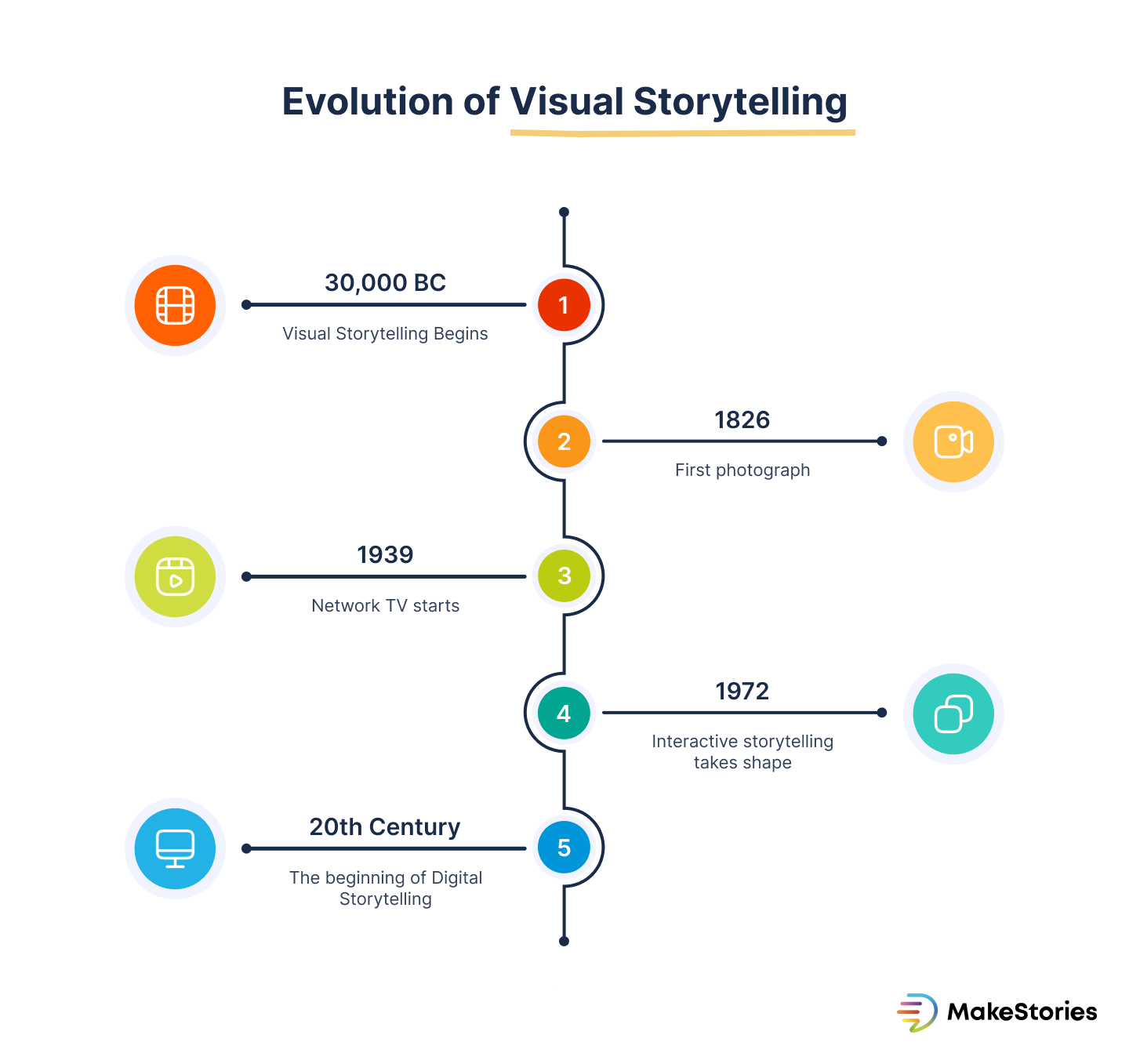
Benefits of Google Web Stories (AMP Stories)
There are several benefits of using Google Web Stories formerly known as AMP Stories.
- Fast Loading Time – AMP Technology enables Google Web Stories to load super fast on a user’s mobile. This keeps the user from leaving the page, often seen with slow page loads.
- Wider Audience Reach – Published Web Stories appear on the open web. This increases the reach of the audience as compared to the reach on social media. A lucrative option for any brand that wants to amplify its reach outside of social media.
- No Time Limit – AMP Stories stay published on the web for as long as you want. In comparison, Instagram or Facebook stories need a lot of effort and last only 24 hours.
- Improve SEO – Web Stories work like blog sections. They optimize for search engine results. They help your brand rank higher on Search Engine Result Pages (SERPs).
To learn more about how Google Web Stories can benefit you, click here.
How to create your first Web Story?
For someone who uses social media, creating Web Stories is very simple. Free tools like MakeStories make this marketing format accessible to all brands. MakeStories is a free online web stories creator that needs no design or coding experience. Its drag and drop UI makes it the perfect tool to create your first web story.
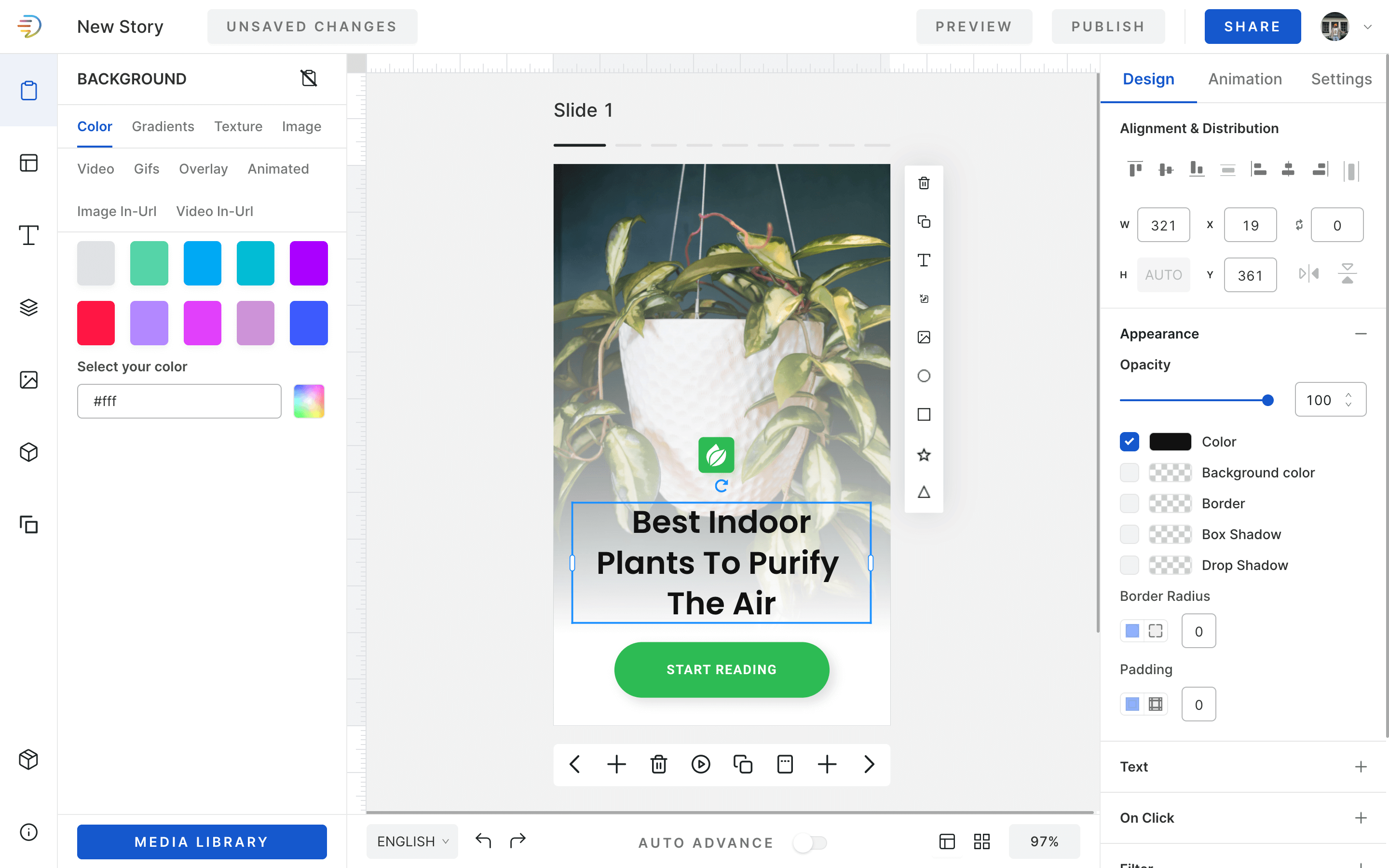
There are many templates that await you on MakeStories. Pick a template and start editing to make your first web story. Personalize your stories by uploading your logo, brand images or videos. Use the extensive free media library if you do not have professional images. Add text in catchy fonts and animate them to grab eyeballs.
Don’t forget, the main purpose of Google Web Stories is to market your brand. Drive in traffic to your website or convert sales by adding a call to action button. Get new subscribers, send customers to a product order form or poll a new design. MakeStories’ analytics tracked in real-time make this a very effective marketing tool.
Follow these simple steps to create your first web story here.
How to increase your organic traffic using Google Web Stories (AMP Stories)?
Google Web Stories is an excellent tool to increase organic traffic to your website. They follow similar principles to blogs for SEO. Investing time in optimizing web stories can help increase your brand’s visibility across the web. Learn how to increase organic traffic to your website. Read more about them here.
Conclusion
You now know what AMP Stories are, why they are useful to brands and how to get started. Google launched AMP Stories in 2018. They rebranded AMP Stories in May 2020, now known as Google Web Stories. It has quickly become a popular format of visual storytelling on the open web. Web Stories are like stories you find on social media with differences in duration, ownership and reach. Google Web Stories once published can be found on Google Search, Discover and Images. Easy tools like MakeStories can help you create and publish your web stories on the web. MakeStories has SEO capabilities and real time analytics features too.
Google AMP Stories: Are remarkable in 2022?

Table Of contents
Ever since 2020, there has been a lot of discussion around Google’s AMP & Stories Technology. Is it still required to achieve optimized mobile viewing? Is it the only way to get a faster loading time? Does it help with ranking higher on SERPs?
Let’s take you on a quick tour through Google AMP.
What is Google AMP?
Google first introduced AMP, which is, Accelerated Mobile Pages, back in 2015. It provided an enhanced user experience by creating fast-loading web pages. This is for mobile viewing.
AMP is an open source framework created by a network of software developers and is free for the public to use. It is known as Google AMP because Google is a large contributor and promoter of the technology.
How does AMP technology work?
When you use AMP, your mobile pages load within seconds. Design restrictions play an important role in making this happen. It has a smart rendering approach that starts loading your page even before it’s visited.
Google AMP from 2015 – 2022
AMP technology came about in 2015 by Google. It’s original purpose was to optimize mobile viewing for users. It also helped rank higher on SERPs (Search Engine Results Pages). Before this, Google had introduced mobile-friendly viewing in 2014. It informed users that the site they were about to visit was designed for small displays.
AMP pages were displayed on mobile search results. It appeared under the ‘Top Stories’ category. This was possible when SEO optimization was used to rank these pages on SERPs. In 2017, Google incorporated AMP technology to run ads as well.
Google introduced AMP stories and AMP emails in 2018. This was the beginning of a new visual format for fast consumption of content. In 2019, there were controversies revolving around AMP and its functions. In June 2021, Google announced that AMP’s main functionality of ranking pages higher on SERPs, was no longer valid. Both AMP and non-AMP pages could rank on Google.
Having said that, Google AMP has not disappeared. It is relevant and thriving today in the form of Google AMP Stories.
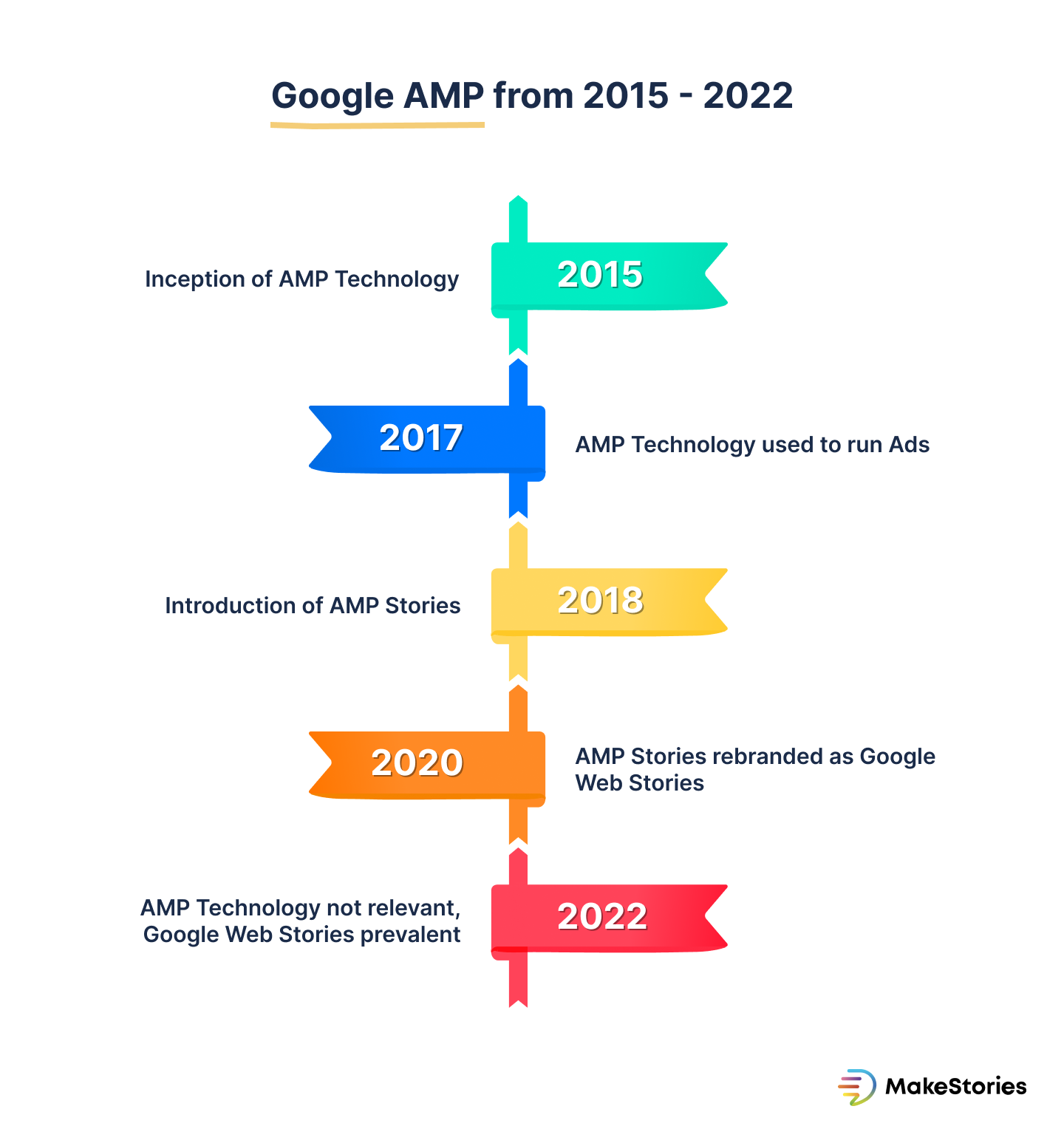
What are Google AMP Stories?
Google AMP Stories are a format of tappable, carousel content cards, similar to stories on social media platforms. It is discoverable on Google Search, Discover and Images. It helps generate traffic and increase brand visibility on the open web. These stories make use of AMP technology, which makes mobile viewing efficient. On the open web, AMP Stories are viewed in full-screen portrait mode.
In May 2020, Google decided to rebrand AMP Stories to Google Web Stories. Click the link to know everything about Google Web Stories here.
Difference between Google AMP Stories & Google Web Stories?
There isn’t much of a distinction between the two. Google has released them both with the same purpose in mind. That is, to provide audiences with immersive mobile watching experiences. AMP (Accelerated Mobile Pages) technology underpins both of them.
The most significant distinction between the two is who owns the Stories. The pages created using Google Web Stories are HTML, they can be hosted or linked to your website directly. D. This offers you full control over the online stories you generate. MakeStories is a tool that allows you to create and publish Web Stories on your website.
So are Google AMP Stories still relevant?
The answer is yes, in a way. Google Web Stories are powered by AMP technology and is what a brand should be focusing on. There are several reasons why one must explore Google Web Stories in 2022.
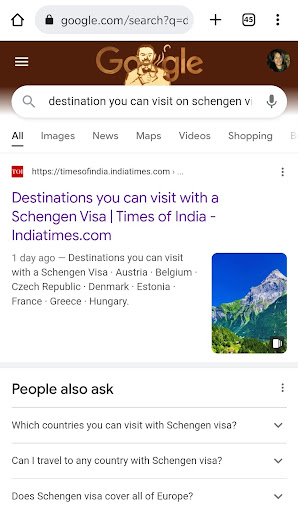
1. Reach a wider audience
Today’s content marketing landscape is fierce. Building a huge audience is one of the most important goals. When it comes to reach, there is no comparison between social media and the internet. Unlike social media, the internet can help you reach billions of people. Google Web Stories support inbound marketing activities. Web Stories appear to users who are looking for your unique product or service on Google. For example: Destinations you can visit with a Schengen Visa
2. Increase credibility
A study by comparehare.co.uk suggests that 97% of users look online for local products or services. A good internet presence makes it simple for ideal customers who are unaware of your existence to find you, whether or not they are looking for what you have to offer. By effect, when you are able to reach a wider audience, this will help build the credibility of your brand which leads to higher conversions.
3. Complete ownership
There are no limitations to how imaginative you can be when using Google Web Stories. You can design, edit and publish your Web Stories on your website. MakeStories is an easy-to-use web story editor making it possible to do so. You can even use these stories for different social media channels. If you don’t have your own website, MakeStories can host your stories on their platform. Find more information on how to publish your web stories through MakeStories here.
4. Monetize and receive 100% revenue
Visual storytelling is a fun way to communicate with your audience. It’s also a terrific way to generate income! You can keep 100% of the ad revenue generated by hosting ads on web content. Google released AdSense and Ad Manager, which include a programmatic ad solution. This aids in the tracking of your web story ads. Click here to discover more about how to monetize web stories.
5. Easy indexing
On MakeStories, Google Web Stories come with SEO benefits. If used in conjunction with your SEO plan, it will boost your company’s online visibility.
Indexing your stories is simple and requires little effort. This can help your story appear at the top of a Google search. To help them rank on Google, each Web Story has a unique URL that targets specific keywords. Click here to see where Google Web Stories appear on Google.
Conclusion
There is a difference between Google AMP and Google AMP stories. From 2018 onwards, AMP Stories got a new name i.e., Google Web Stories As a brand, you don’t need to focus on AMP technology, just Google Web Stories. Learn how to use Google Web Stories for your brand here.
5 Best Practices Web Stories on Google

Table of Contents
Creating Google Web Stories has become simple now with free online tools. But to stand out with a successful web story, it is important to follow some fundamental practices. These practices implemented in the right way can contribute to the performance of your Google Web Story.
Before we dive into best practices Web Stories on Google, let’s recap the basics of what Google Web Stories are.
What are Google Web Stories?
Google Web Stories is a tappable, content carousel format available on the open web. It is a visual format optimized for mobile viewing, much like Instagram Stories and Youtube Shorts.
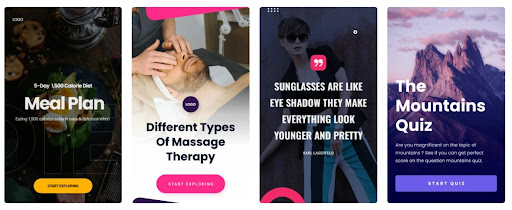
Since it’s launch, it is proven that Web Stories are very beneficial for brands. It can help brands reach a much wider audience than social media. Unlike stories on Instagram, Web Stories last for as long as you want them to. Web Stories can be hosted on your own website, providing you full ownership over them. This removes third-party constraints like time duration, layouts and audience.
Click the link to read a complete guide to understand Google Web Stories.
How to create a Google Web Story?
Designing a Web Story is an easy task. Especially easy if you use tools built for this specific purpose. Without any design or coding experience, free tools like MakeStories allow you to create, publish and monetize web stories. It has an intuitive drag and drop UI, ready to use templates and exhaustive media libraries. MakeStories is a fit for both beginners and professionals, if this is your first web story, it’s a good place to start.
Web Stories are a relatively new marketing tool but we have figured out 5 ways to optimize them. Follow these 5 best practices to make beautiful and effective Web Stories
5 Best Practices Web Stories on Google Standout
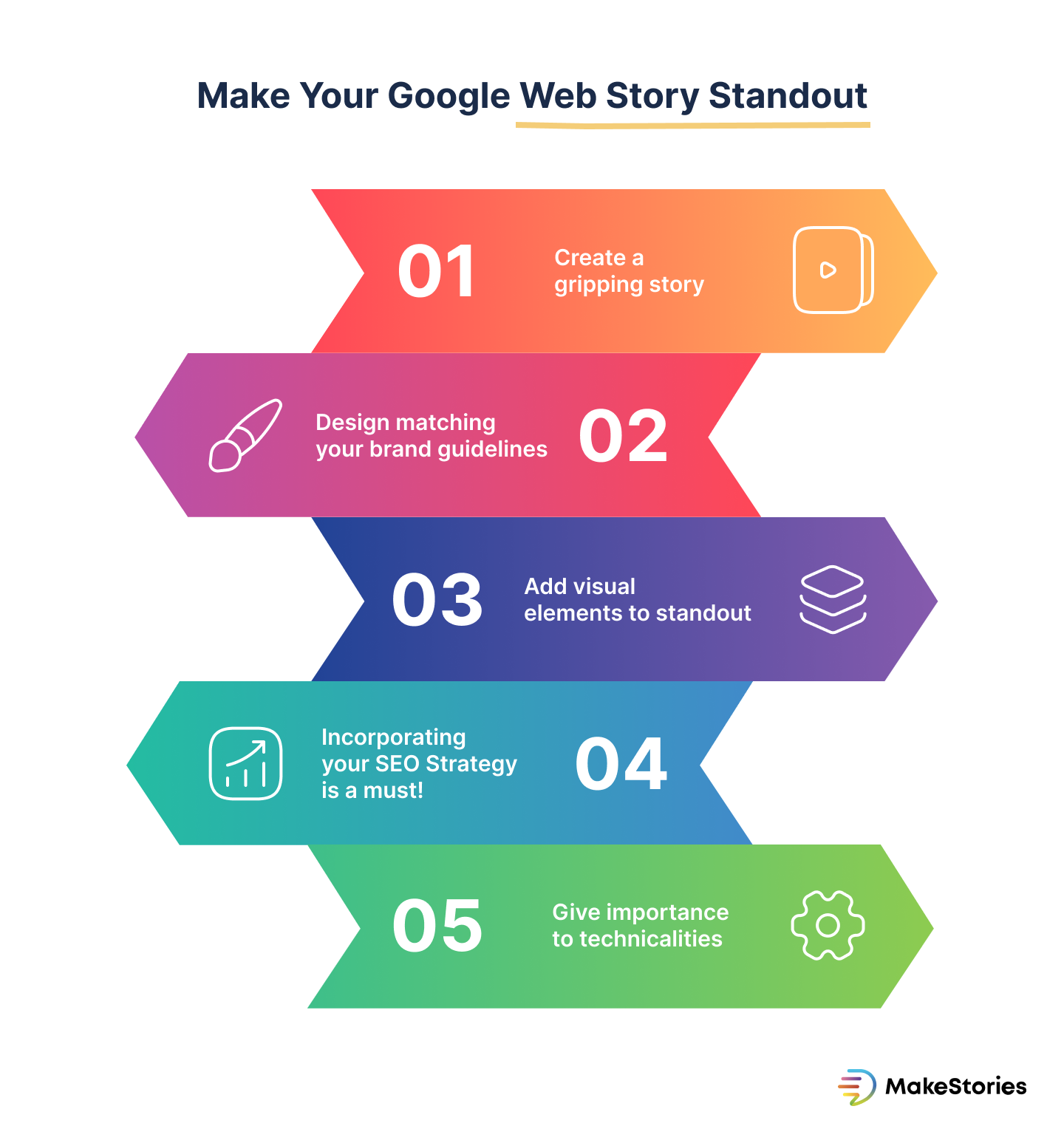
1. Create an engaging narrative
Web Stories are visual storytellers. Hook audiences in by designing a story. Create a detailed plan before starting the edit on a web stories creator. Here are a few things to keep in mind while planning your web stories:
- Zero in on your audience
- Find clarity on your messaging/story
- Pick a media format (Most recently, videos less than 60 seconds are receiving the highest engagement)
- Keep your text content ready for each page (Minimum content required is 280 characters per page, structure it into an introduction, main body & conclusion)
2. Design is crucial
A viewer taps on your story only if it has visual appeal. With MakeStories, you don’t need any previous design experience. It has in-built professional web story templates. Here are a few things to check off before you start designing:
- Keep your brand identity intact by implementing your brand guidelines. Adding your branding details is a one time process on MakeStories.
- Minimalistic designs go a long way
- Keep your text within 280 characters per page for increased readability
- Use a legible font size. It should not look too small to fit a lot of text but should not be very big either. 16px is a good font size to use.
3. Enhance your web story with Visual Elements

Adding visual elements to your web story can make it enticing for a viewer. MakeStories offers a plethora of options to choose from. They provide a media library with high-quality images and videos. Along with a variety of animations and font styles. They have beautiful backgrounds to elevate your web story design. A few things to remember while adding visual elements:
- Use high-quality, portrait-style images and videos for the best mobile viewing experience.
- Add your brand logo to all pages on your web story
- Audios are a great addition to making a compelling web story
- Maintain a theme to increase relatability
- Add a definitive Call-To-Action
Learn more about visual elements for Google Web Stories here.
4. Incorporate SEO Strategy

To rank high on Google, it is essential to work in tangent with your SEO Strategy :
- Your primary keywords should appear in your Meta Title and Meta Description
- Limit your text to 280 characters per page for easy indexing
- Analyze competitor keyword research using online tools to produce unique content
- All your Web Stories must be self-canonical. This means telling Google that this version of the page is the main version, regardless of other pages having similar content. The canonical tag will need to be placed in the section of the HTML. For example, if the URL of your created Web Story is https://example.com/sample-page/, and it is the primary page you want to rank, then the canonical to be placed in the HTML will be as such:
<link rel=“canonical” href=“https://example.com/sample-page/” />
5. Fulfil Story Validation Checklist

MakeStories has a story validation checklist. You can proceed to publish your Web Story only when you meet all the requirements on the checklist. These include:
- Ensure your Web Stories have a valid AMP code to optimize mobile viewing
- Use licensed image and video assets
- Images should have Alt Text mentioned
- Adhere to image dimensions. They should have an aspect ratio of 3:4
- Make sure the logo image connected to your web story is 96×96 pixels with a 1:1 aspect ratio.
Conclusion
Follow these basic practices and make your best Web Stories. Create your first Google Web Story using MakeStories here.
How to convert a Google Web Story to a Video

Convert Google Web Stories into Creative Videos Using MakeStories
Most third-party platforms help to convert your videos into Google Web Stories. But with MakeStories, the reverse is possible too!
Convert Google Web Stories into Videos and Vice Versa
The video format has been at the forefront of content consumption by users. Google introduced a new content format 4 years ago in the form of Google Web Stories. Since then, brands have been hurrying to adapt to this new method of inbound marketing.
A study by Wyzowl suggests that 86% of people want more videos from brands. This format continues to dominate content strategies. Many third-party platforms allow you to convert videos into Google Web Stories. But what if you already have a great web story that would bring great success as a video? MakeStories provides you with an easy solution to do this!
Video content in demand – 93% of marketers claim increased brand awareness
In 2022, the need for custom content formats to match audience profiles is greater than ever. Your ideal customer profile could be spread across different mediums depending on the industry. For example, with Google Web Stories, only audiences that are present on Google will be able to consume the content. The same content could be repurposed for different social media platforms, in a video format.
The greatest advantage of creating Web Stories using MakeStories is that with the click of a button, you can convert them into a shareable video.
Advantages of creating Web Stories using MakeStories
Several other advantages of using MakeStories include:
1. Workspace Collaboration
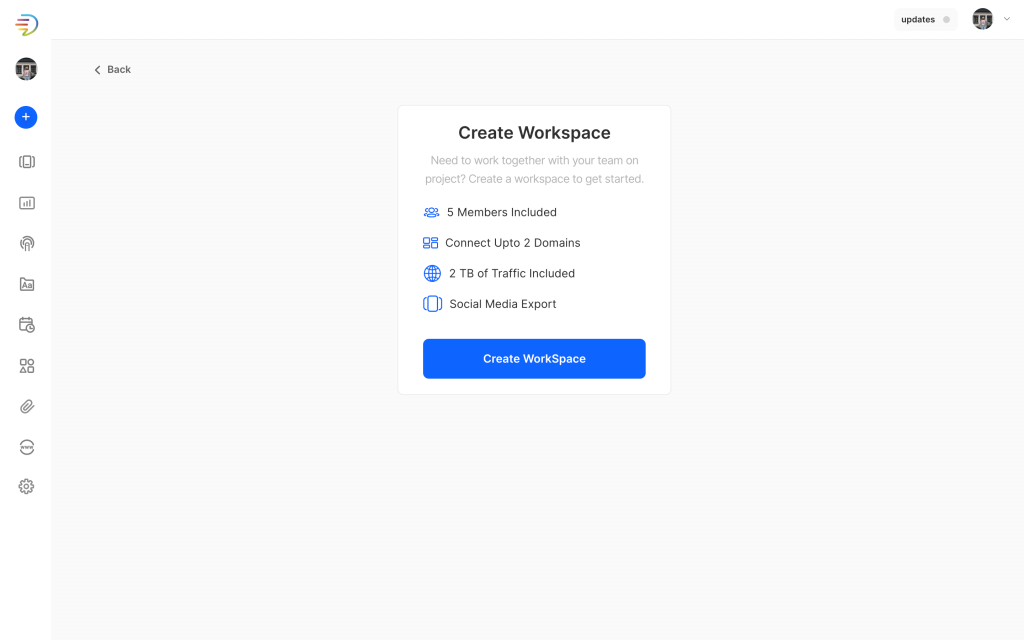
Teamwork plays a crucial role in creative output. With this feature, each team member has access to the same file. This space helps the team eliminate long feedback chains and approval times. This makes the process faster of producing the final file.
2. Extensive Media Library
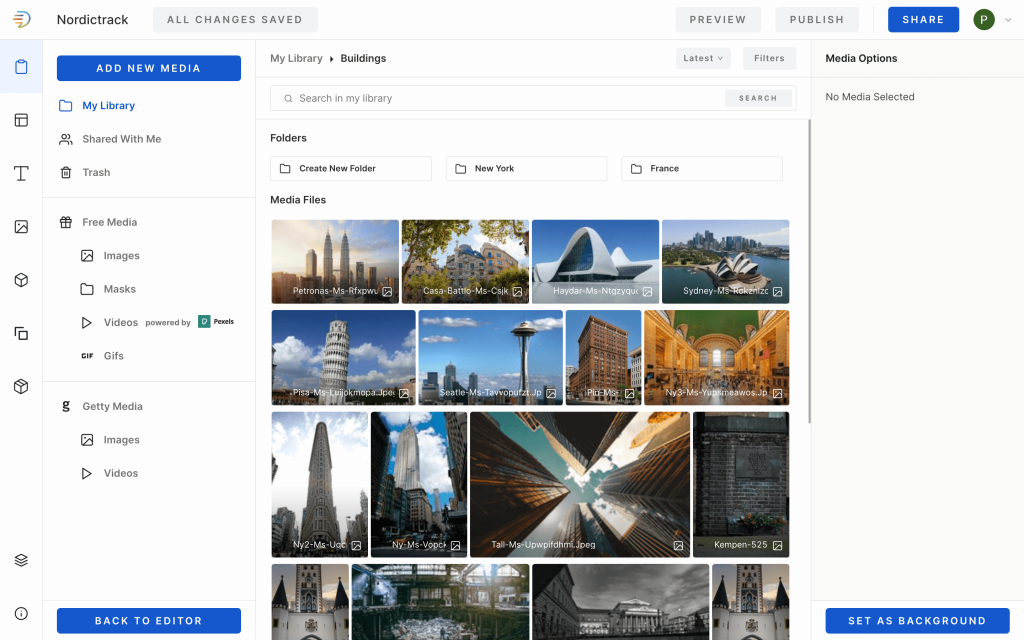
MakeStories provides you with exhaustive options of images and videos to choose from. This can help make your Web Stories stand out. You can choose an image or video for each slide to make it appealing on its own or you can collate them into a single video. We’ll talk more about how to do so soon.
3. Abundant Templates
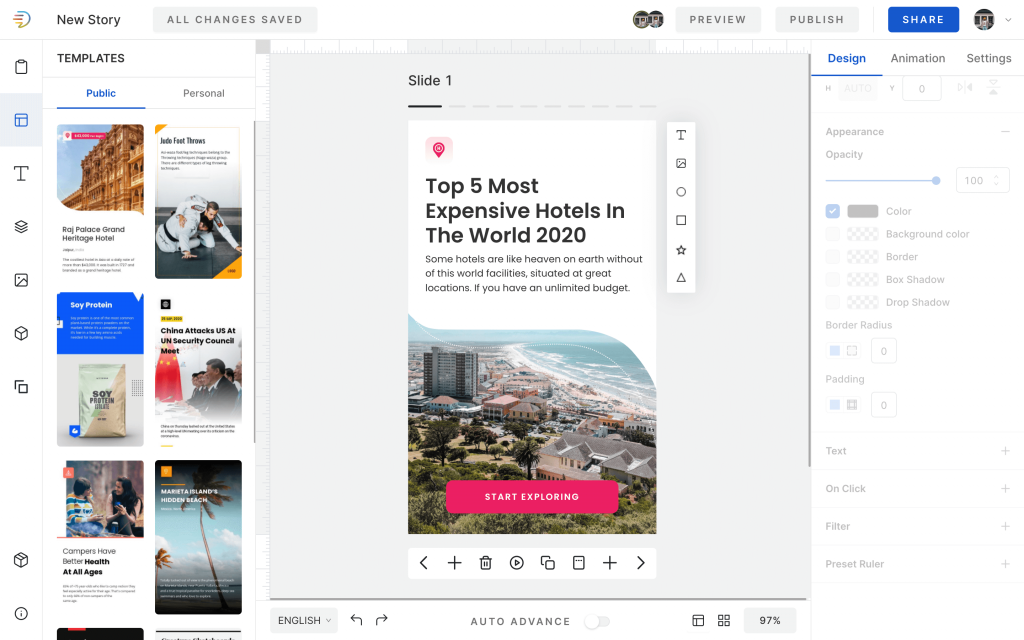
This is a great feature for non-designers or beginners to use. There are many creative templates available and these get updated very often.
4. Publish Anywhere
These videos can be published directly on your website. They can even be used to publish on different social media platforms. MakeStories downloads the stories into a compiled video in an mp4 format.
Stepwise Guide to Convert Web Stories into Videos Using MakeStories
These simple steps can guide you to convert your Google Web Stories into eye-catching videos.
1. Create your Web Story
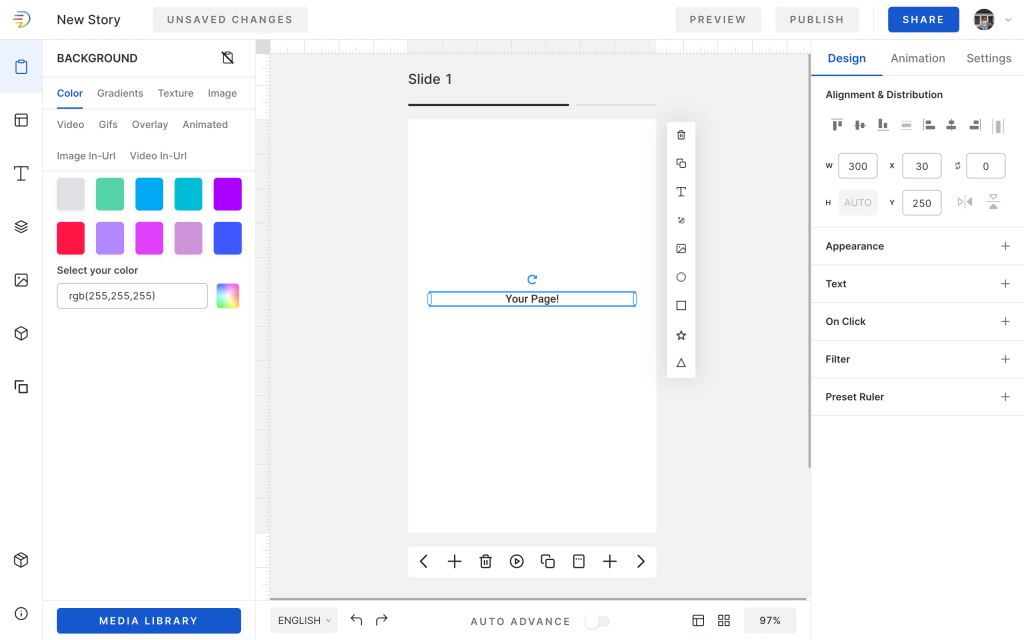
MakeStories is everything you need to create stunning, effective Web Stories. They bring together function and design in an easy to use free online editor. Unlike other Web Story Editors, MakeStories provides you with additional add ons besides fonts, animations, graphics etc. It gives you the option to add interactive elements like quizzes, polls, CTAs. The latest addition is the Tag Location feature. Here is a quick link to learn how to create web stories on MakeStories.
2. Publish Your Story

It’s time to publish your Web Stories now that you’ve finalised the visual elements. There are two ways of doing so. MakeStories makes it simple to publish your Web Stories straight to your website. The second option allows you to export your stories for use on other social media networks.
3. Export for Social Media
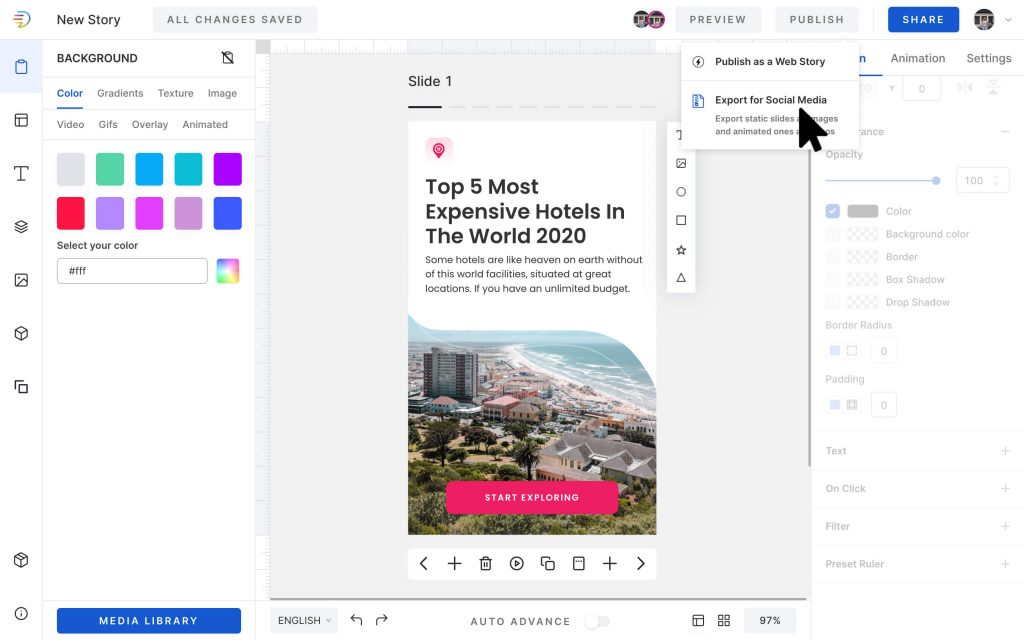
The next step is to select Export for Social Media from the drop-down menu. This will direct you to your collection of Web Stories in the form of an assembled video. Once chosen, your download will be queued for export. You may check the status of the download in the bottom right corner to see when it’s finished. You will also receive an email confirming the completion of your download.
4. Download Zip Folder
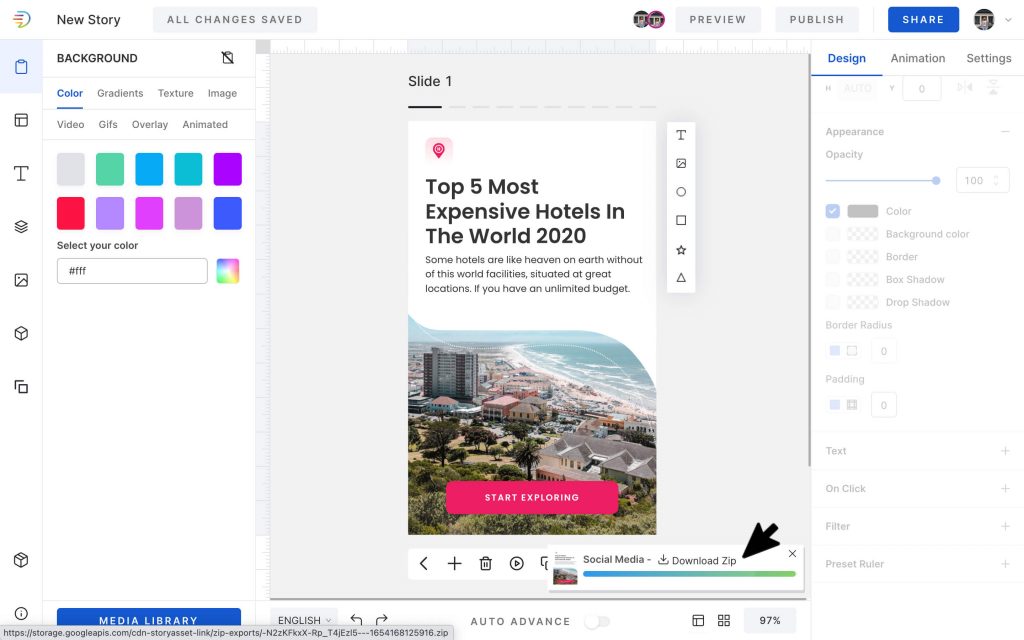
You should see a zip folder loaded at the bottom of your screen after the export process is finished. It’s the same as downloading a zip file.
5. Access the Zip Folder
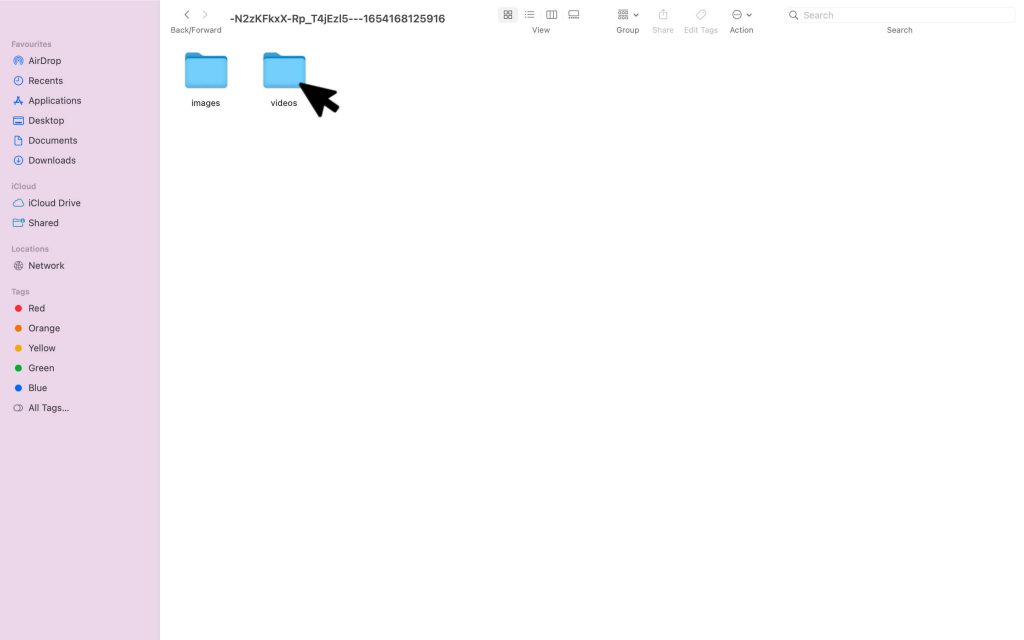
The zip folder downloads your stories into two separate folders – images and videos. This allows the user to pick and select according to their needs. To get to your video, go to the video folder and click on it.
6. Your Video Is Ready!
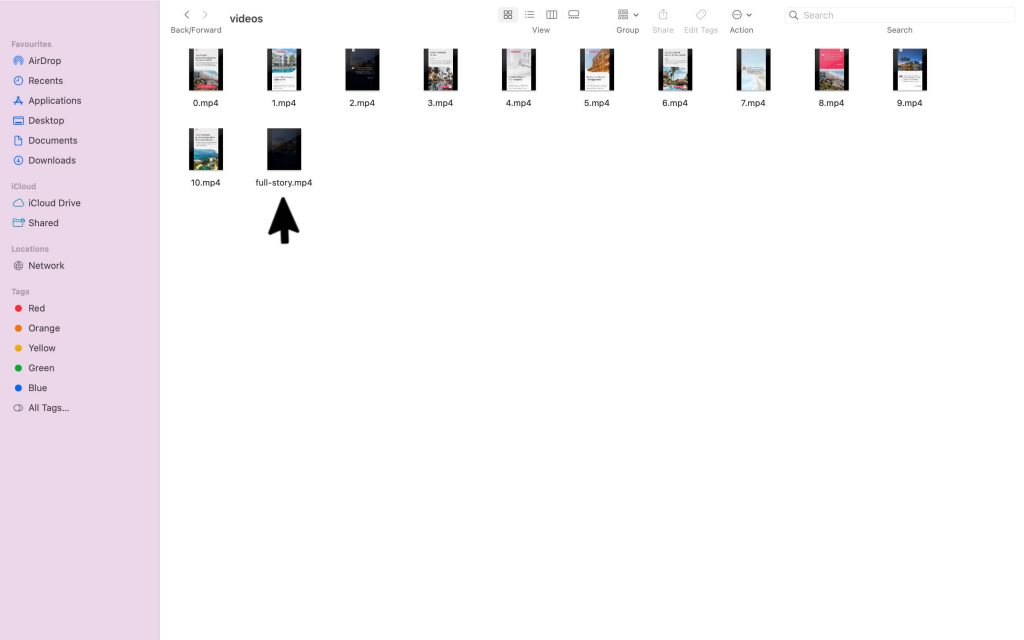
You can choose individual slides and utilise them as a single video. You have the option of choosing the full story which is the assembled video.
It is that simple!
Here’s where you may try making your first video using MakeStories.

How to make money with Google Web Stories in 2022?

Table Of contents
One of the most recent means of revenue generation is monetizing Google Web Stories. Understand Web Story Ads and how to make money with Google Web Stories in this article.
Introduction to Web Stories on Google
Web Stories are a series of tappable, mobile-optimized, interactive images or videos. They are like stories on social media. The intention of creating web stories is to provide concise information fast.
A brand has complete ownership to conceptualize and execute Web stories. There are no restrictions unlike on social media platforms like Instagram and Facebook.
Google introduced Web Stories in 2015, then known as AMP stories. It did not gain momentum and did not continue. In recent times, social media stories being a game-changer in user behavior. Google made the decision to relaunch AMP stories as Google Web Stories in October 2020. They did so in India, Brazil, and the United States. Learn more about Google Web Stories here.
Benefits of Web Stories on Google
Apart from having full ownership of the stories, hosting them on your website is an advantage! They are not bound by a 24-hour time limit, unlike Instagram and Facebook. It helps you reach a wider audience. You can also boost your SEO with easy indexing. Another benefit is you can track the performance of your web stories on Google Analytics. You can also send real-time notifications to your users using the Live Story feature.
But what a lot of brands and marketers don’t know is that Google Web Stories are also a source of revenue! Dive deeper to understand the benefits of Google Web Stories.
How do Web Stories Ads work and where do they appear?
There are 500 million people viewing Instagram stories daily. If you are one of them, you must have come across sponsored ads. A study by Hootsuite revealed that 50% of users visit the website of a product or service they saw in ads. This makes it important for marketers to capitalize on advertising on Instagram stories.
Web Stories Ads are full-length, engaging ad creatives. The user can view it while browsing through a Web Story. These ads appear based on the number of pages viewed on the story and the time spent on the site. Hence, the longer a Web Story, the higher the ad impressions will be. The biggest advantage of Web Stories Ads is that 100% of revenue generated goes to you.
Types of Story Ads
Currently, there are different types of story ads that a brand can publish on web stories.
- Display Ads – These are ads used to drive traffic to the advertiser’s website. They can be in the form of images, videos, text, or audio.
- Affiliate Links – These are ads with either a call-to-action like ‘swipe up’. You can add this using the page attachment option on the Web Story. Another way is to add definite links to direct the user to the affiliate sites. It is advisable not to use affiliate links in every story instead keep them limited.
- Brand Deals – Create an individual story that appears like an ad. Do so by highlighting your product or service
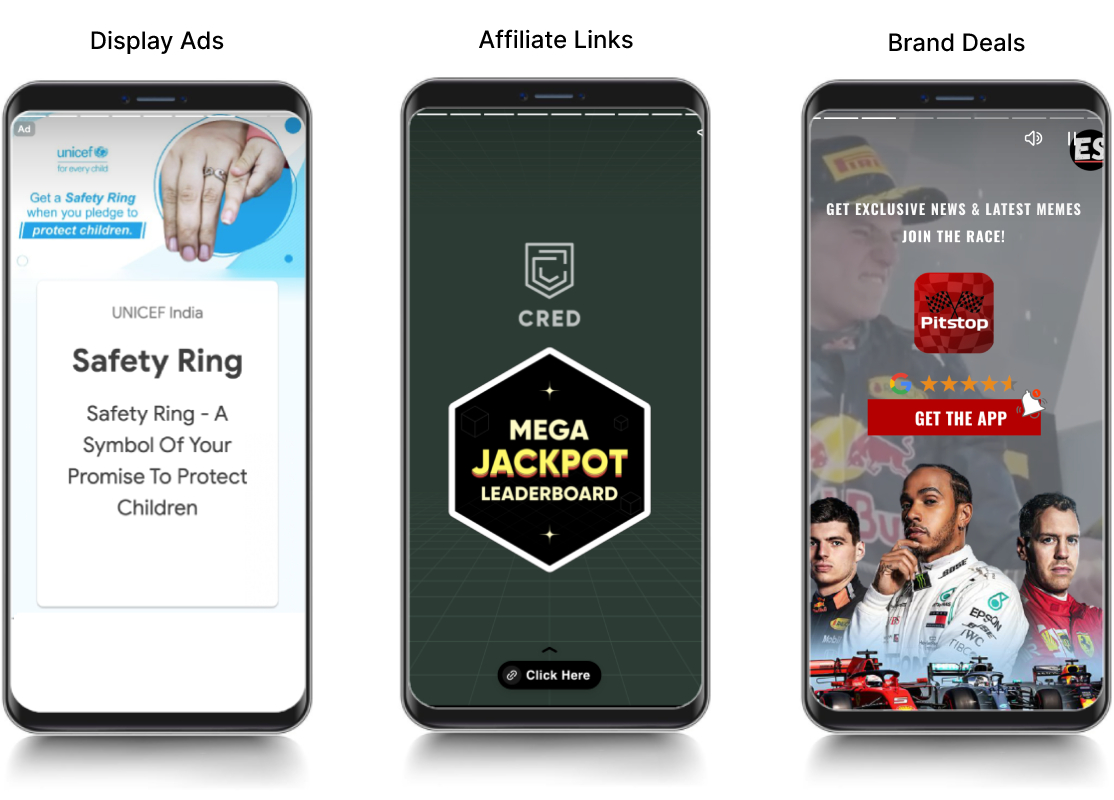
How to monetize Google Web Stories?
You can use any type of ad story mentioned above to make money with Google Web Stories. An ad story with an AMP (Accelerated Mobile Pages) framework is an open-source HTML. It aims at aiding faster mobile loading to enhance user experience. There are many supporting ad networks. Google AdSense or Google Ad Manager are some that help creates Web Story Ads.
Google recommends using third-party tools like MakeStories. Besides creating and publishing, it helps with monetizing Google Web Stories.
You can do so in 3 simple steps:
-
Sign in to your MakeStories account
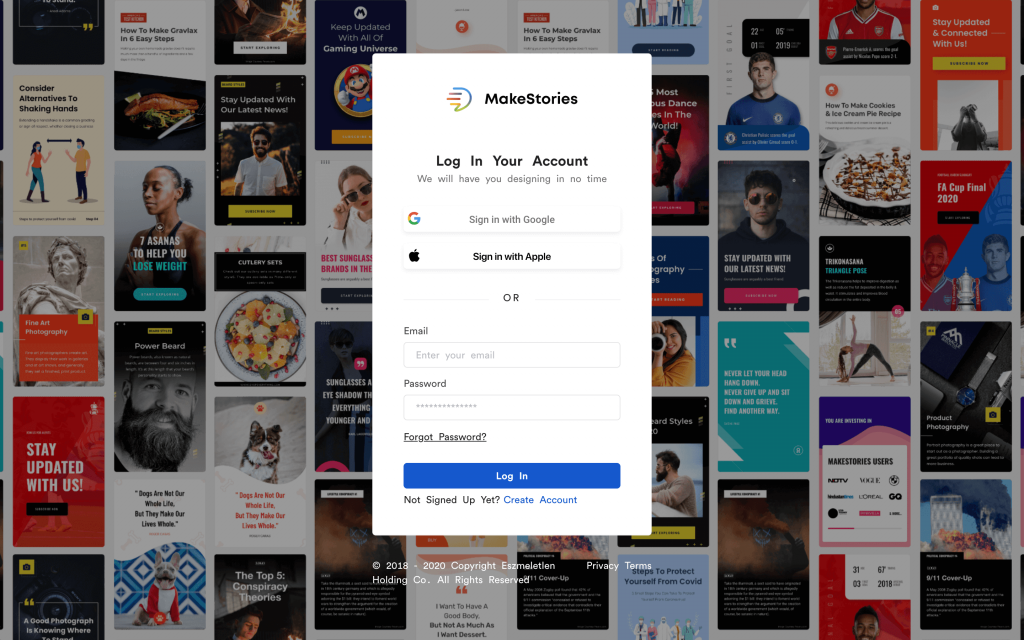
-
Go to General Settings

-
Advertising Set Up – which gives you the option of monetization. It can be through Google Adsense, Google Ad Manager, or creating a Custom ad.
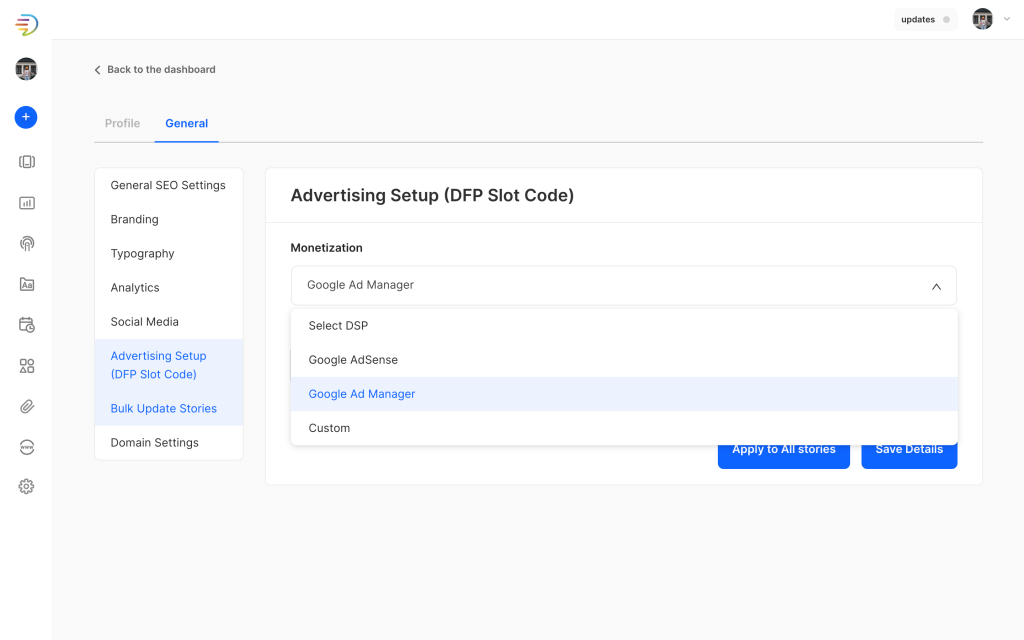
How to create a Web Story Ad
Before you learn how to create a Web Story Ad, it is important to keep a few things in mind Web Story Ads use AMP technology and are created for a mobile-optimized, full-page experience.
- Web Story Ads use AMP technology. This helps for a mobile-optimized, full-page experience
- Meet the dimensions of the vertical format of stories
- Focus on engaging and creative content. Make your ad design stand out!
- Ensure AMPHTML specifications are mentioned accurately
- Ensure a clear Call-To-Action is mentioned in your ad story
Creating your first Web Story is very simple, especially if you have had the experience of creating stories for social media. Mentioned below are simple steps to create a Web Story Ad:
- Find the right tool for creating web stories
- Outline your story
- Add visual elements
- Create the story
- Publish the story
MakeStories is a recommended option for both beginners as well as professionals. Its simple features help in creating web stories easily. Learn how to create your first web story on MakeStories here.
How to track your Story Ad performance
Tracking your ad story performance depends on the ad network you use. It is like tracking Google Ads on Google Analytics. On Google AdSense, you can view the visual ad report to analyze how your ad story is performing.
You can track the performance of a Web Story Ad based on the following criteria:
- Estimated Earnings
- Page Views
- Page RPM
- Impressions
- Impressions RPM
- Clicks
- Total earnings
Summary
Web Stories Ads is a revenue generation route that brands should definitely explore. Like Instagram ads, ad stories appear while a user is browsing through Web Stories on Google. There are a few Ad network tools such as Google AdSense and Google Ad Manager. They help with monetizing and tracking your ad stories. Google recommends using third-party tools like MakeStories. They provide you with a platform for anything Web Stories related.

How to Use a Web Story Creator? – Guide for Beginners

A Google Web Story is an engaging series of quick tappable images or videos. It is mobile-optimized. It provides concise information to users. It’s evolved into a cutting-edge storytelling technique that helps form meaningful connections.
Creating Web Stories for your brand can help you reach a wider audience. Indexing and linking to a web page hosted on your website is an easy process. There are many benefits of Google Web Stories.
Creating a web story is the same as creating stories for Instagram and Facebook. But, if you have no prior experience, this step-by-step guide is all you need to create your first Web Story.
Table Of contents
Step 1: Find a Web Story Creator

There are a few online SAAS products available in the market that can help create Web Stories. MakeStories is one of the end to end solutions for web story creation. You can design, optimize and publish Web Stories. Its features help both beginners and professionals. These include:
- Drag and Drop Functionality – to create beautiful stories hassle-free
- Workspace for Team Collaboration – to coordinate and produce stories with your team
- WordPress Plug-In – to produce stories directly on your WordPress website
- Fast & Secure Web Hosting – made especially for creators who do not own a website
- Story Player – to design carousels, like Instagram, that can be embedded in your website
Step 2: Outline the Story

MakeStories recommends chalking out a draft like you would create a storyboard. This helps you visualize how you want the narrative communicated to the user. Once finalized, this can aid in the speedy execution of the stories. The aim is to convey your message in a story format. Remember to structure it with an eye-catching introduction, main body, and conclusion.
Google has created a simple template to get you started which you can access here.
Step 3: Add Visual Elements
To capture your user’s attention, designing high-quality content is the key! We understand design can be daunting for beginners or non-designers.
MakeStories provides you access to its extensive media library. This includes HD images, videos, and GIFs. You can also personalize brand visuals by uploading your images and videos.
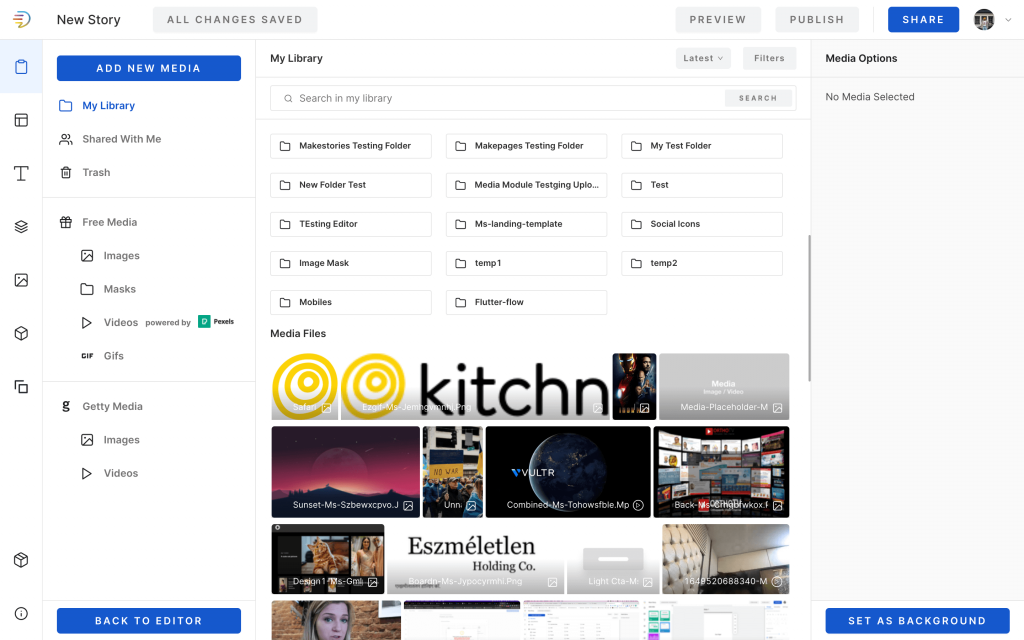
Web Stories show in a vertical, full-page format. Remember to choose images or videos that fit the canvas style as it can affect page load time. The right images use lesser bandwidth. This helps in faster loading which enhances the user experience.
Step 4: Create the Story
This is where using a Web Story creator gets exciting! MakeStories provides you with many features to make your stories attractive and interactive. This makes them efficient conversion tools.
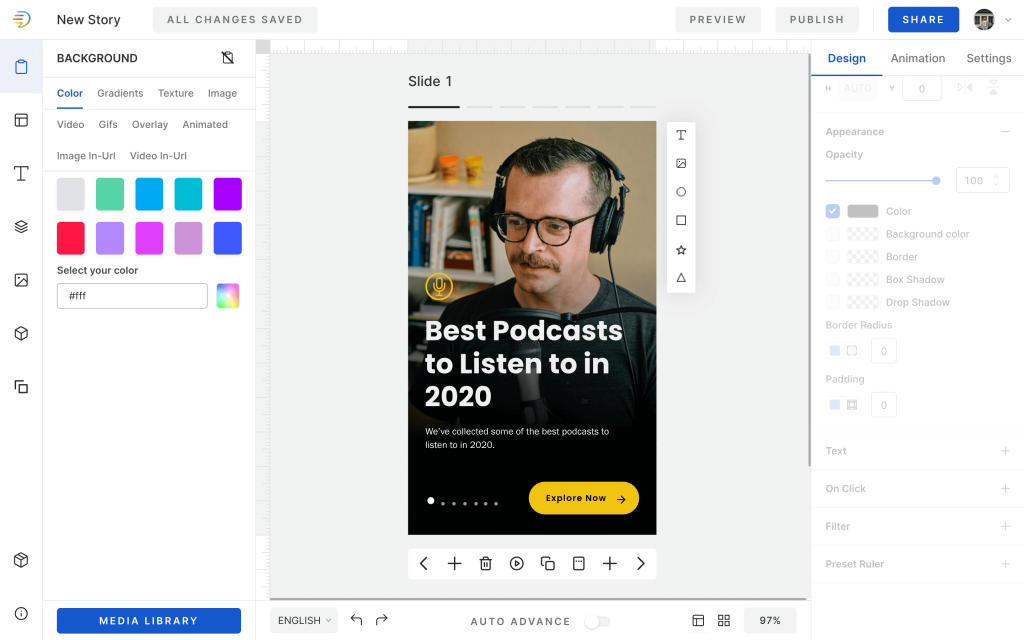
Before you start, make sure you match the requirements listed below; else, you won’t be able to post your story.
- The title of your Web Story should be between 10 – 40 characters
- Create atleast 5 pages for an optimal user experience
- The total text mentioned in your story should be 500 characters or more for easy indexing
- Ensure your image has an Alt Text mentioned
- All media assets used should be licensed
1. Background
It is not necessary to add an image or video in the background of your Web Story. There are several options for adding a beautiful background. Bold colors, gradients, eye-catching textures, GIFs, and even animated backgrounds are all available!
2. Templates
This is a great option for beginners who need direction in making stories. Choose any template and customize them to match your requirements and brand style.
3. Text
Add text to your stories according to typography. This helps you segregate your content into H1, H2, H3, paragraph and supporting text. There are many varied font combinations and animations to make your content appealing.
4. Layers
This feature is like professional graphic design editors like Photoshop & Illustrator. Different layers one over the other help create depth in the design layout. The tool also allows you to add a Call-To-Action (CTA) button. You can add it on any page except the first.
5. Elements
You can choose from many visual elements. These include masks, shapes, illustrations, gradients, and stickers. This helps to amplify the effect of your Web Stories.
6. Auto Animate
Use the auto animate feature to switch static images into transitioning videos.
7. Add Ons
According to a study by Outgrow, 81% of marketers believe that interactive content engages readers. By allowing users to react to your web story with a single click, you can make your content interactive. This is achievable by creating quizzes, polls or an enticing CTA. MakeStories gives you the add on option of audio as well.
Step 5: Publish the Story
Once your stories tie in together, use your web stories creator to publish them. MakeStories gives you the option to publish it on your website or export the files for social media.
You can proceed to publish your Web Story. There are important steps to complete to ensure that the Web Story appears across Google.
1. SetUp Publisher Details
These are basic details required of the website owner

2. Meta Tags & SEO
The necessary details need to be filled out in conjunction with your SEO strategy

3. Story Validation
Meet the requirements mentioned above before you start creating your web story

4. SetUp Analytics
Track your performance by mentioning the tracking IDs. Each channel will have a unique ID.

Once completed, add your domain if you have one or create your web stories only site on stories.site.
It’s that simple! As a beginner, these steps can guide you. Once you get the hang of it, with meticulous planning, you can create Google Web Stories within 5 minutes! Here’s a link to use MakeStories editor to create your first Web Story.
Now that the story has been created you can now use our widgets to get your Web Stories appear on your webpage or use iframe embed within your own article page example below.

Repurpose Your Content Using Google Web Stories Editor

Here’s the fastest way to repurpose existing content into Google Web Stories!
Repurposing Content – A Necessity?

The year 2020 forced marketers to find innovative ways to manage content marketing. Limited resources for businesses forced them to become creative with their content. For this reason, global companies more than ever started repurposing content.
Brands increase their visibility by creating a strong presence on social media platforms. Your content would need to cater to each of the platforms in a unique manner.
Often, the same piece of content will have high engagement on one platform. It could be very low on the other. This occurs because the brand’s target audience may not be present on these platforms.
As a marketer, you must understand how to create versatility in content. You must communicate a singular message across platforms. Twitter, for example, is an online platform for users to express their opinions.
They can do so only within a limited number of characters. Instagram is a visual online platform where users share content in the form of images and videos. A brand needs to navigate its content to match these requirements.
Most industries are switching from static posts to mobile-optimized visuals. Instagram stories started the trend to view an image or video on the entire screen of your mobile. Soon after, YouTube started video shorts, where a similar format followed. The latest addition, gaining popularity is Google Web Stories.
What are Google Web Stories?
Google Web Stories are a set of tappable images or videos made to view on the mobile. They can appear on Google Search, Google Discover and Google Images.
You can host these stories on your website. This gives the publisher complete ownership of them. An added advantage is that stories on the web last for as long as you want them published.
Click here to learn more about Google Web Stories and how they can help your brand’s organic traffic. MakeStories is an easy-to-use tool for creating and publishing web stories. It caters to both beginners and professionals.
Benefits of Repurposing Content
There are several reasons why one should consider reusing their content and here are a few of them:
1. Dodge Writer’s Block
You aren’t creating content from scratch. You only need to think about new ways to present your existing content. Remember to customize them to the needs of specific platforms.
2. Widen Your Audience
You can reach a wider audience through different channels. Alter your content to match the needs of your ideal customer profiles. It can increase engagement and create shorter customer acquisition routes.
3. Save Time and Effort!
Give yourself and your team the gift of time. Repurpose old content for new platforms like Google Web Stories.
4. Make Non-Engaging Highly-Engaging
Some posts do not perform well on one platform. Presenting the same post in a different format on a different channel can change that.
What are the types of content that can be reused for Google Web Stories?
- The first and most evident are social media posts. Whether they are static posts or videos, these can be converted into Web Stories. Resize static 1080×1080 px posts to fit the dimensions of the web story. Present them in a vertical format.
- Blogs are textual. Convert them into interactive stories on the web. By shortening the text, you can convey the same message fast. This can change from a 3- 5 minute read into a 30 – 60 second web story.
- MakeStories is also one of the only tools to convert a blog post into Google Web Stories with a click! It is currently in BETA testing and will be launching very soon.
- Convert newsletter campaigns aimed at lead generation into engaging story ads. This can direct consumers to relevant web pages.
- Web Stories are also a great way to present FAQs or commonly asked questions. Users can get answers in a quick, concise manner.
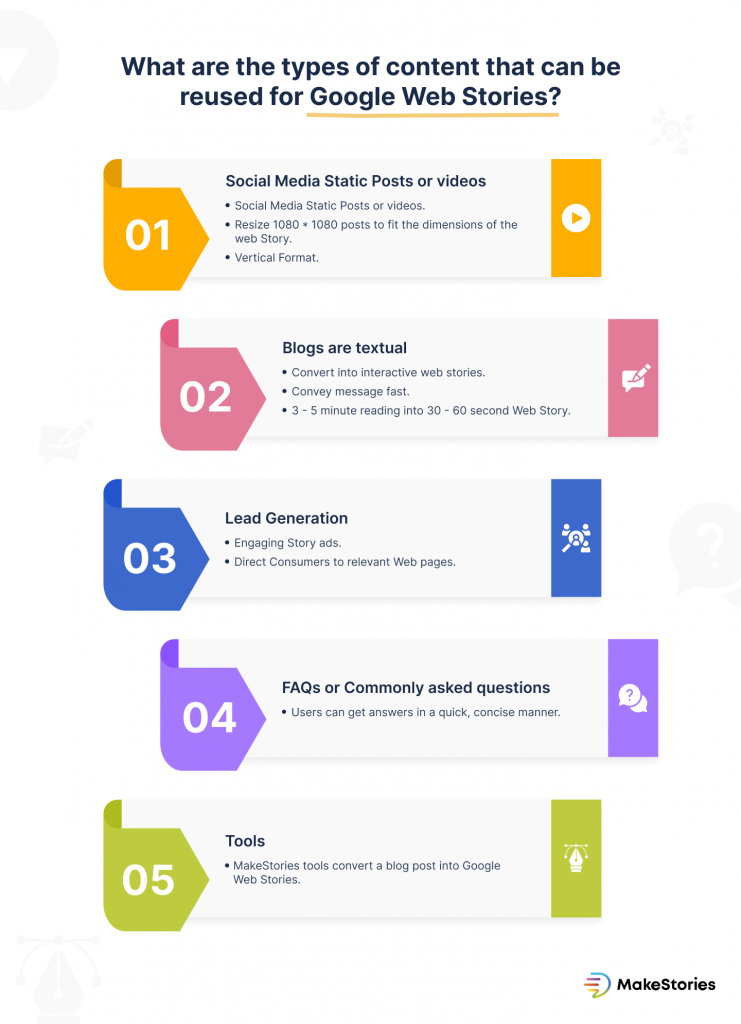
How can you repurpose content using Google Web Stories Editor?
There are a few ways you can use a web story editor to reuse your existing content into a Google Web Story. Whether it is a blog, article, email campaign, or social media post. It is as simple as strategizing existing content in a series of stories.

MakeStories is one such Google Web Story editor that is very simple to use. It has a drag and drop UI. It also provides many flexible templates. It’s premium image gallery helps you create story designs matching your brand. Its integration tools allow you to publish to the web or your website. There are 4 simple steps to follow to repurpose content into web story on MakeStories:
- Outline your repurposed story
- Upload visual elements from previous content
- Use the drag and drop editor to place the content
- Publish directly to the web
If you have a website created on WordPress, explore how you can integrate WordPress with MakeStories here.
How to increase organic traffic with Google Web Stories?

Driving traffic to your website is important for any business. Traffic equals the number of people visiting your website.
You may also be aware that there are two ways of doing this – organic and paid. Organic traffic is visitors who come to your website. They come with the specific intention to look for your product or service. This usually appears on Search Engine Results Pages (SERPs) using SEO. This can be even directed through Google Ads, which are paid.
An increase in website visitors results in increased revenue generation. This is possible with a strong SEO strategy, consistent execution, and patience.
Ways to increase organic traffic to your website:

You need a strong SEO (Search Engine Optimization) strategy to increase organic traffic. Here are some of the basic principles to grow your website traffic organically:
- Writing SEO rich blogs and articles
- Indulging in partnerships and influencer collaborations
- Publishing interactive and concise video content
- Engaging with your ideal customer profiles on social media platforms
- Responding to queries on Google’s People Also Ask
The most recent trend is the use of Google Web Stories. They help to direct more visitors to your website.
What are Google Web Stories?
Web Stories are a series of immersive images and videos created in a vertical format. They are like Instagram or Facebook stories. They appear on Google Discover and Google Search Engine based on the user’s browsing purpose. These were known as AMP stories. Google recently rebranded AMP stories to Web Stories. To learn more about how Google Web Stories work, click here.
Why should you use Google Web Stories?
Online brands want to drive organic traffic to their website. One way is to adopt publishing stories on the web. Unlike Instagram, you can host a Web Story on your own website, giving you complete ownership of it.
There are no restrictions on availability, creativity, engagement, and type of call-to-actions. Stories on the web use AMP (Accelerated Mobile Pages) technology. This enables them to load fast.
This helps keep users engaged with your content. Web Stories are tappable content that you can scroll through on Google. It has the added advantage of not being time-bound! It won’t disappear in 24 hours. You can unpublish the story when you choose to do so or when your website is not live anymore.

How to increase organic traffic with Google Web Stories?
You may wonder where and how Web Stories appear. They can appear on Google Search Engine, Google Discover or across Google Images. This in itself reaches a much wider audience. Especially those intending to find your product or service compared to social media.
As a marketer, it is important to include Web Stories as a part of your SEO strategy. This is can help increase your visibility and credibility. Read to learn about the principles to follow to rank your stories high on Google.
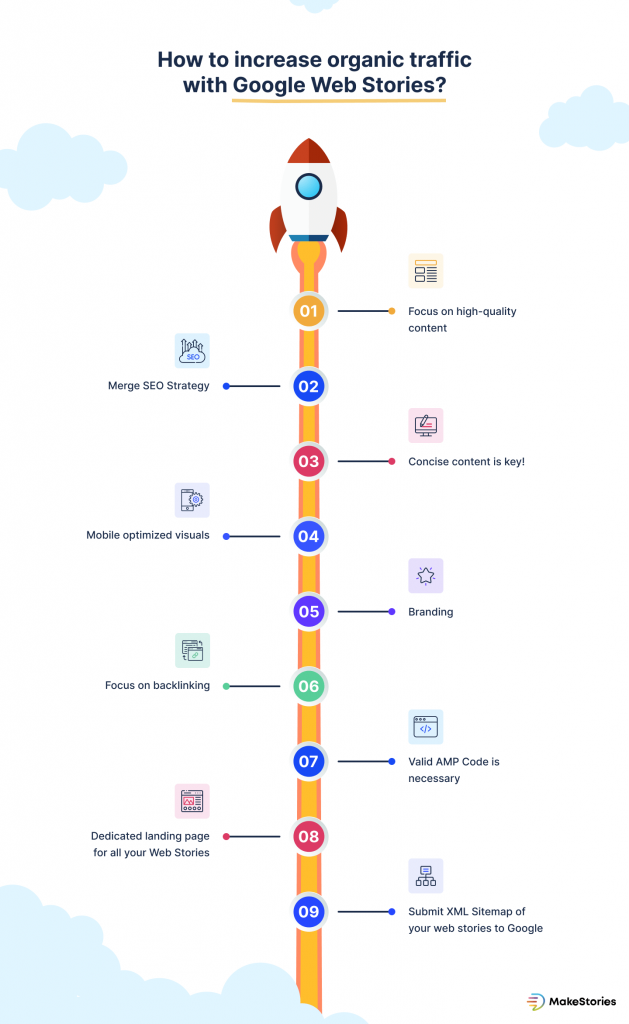
-
Focus on high-quality content – You may have a large social media following. You may be consistent with posting. If the content produced does not resonate with your users, you will lose them. Hence, the content should be your top priority. It could be the design layout, text, image quality, or videos. Ensure you work on creating appealing Web Stories.
MakeStories is an end-to-end Web Story editor perfect for producing innovative Web Stories. Its simple drag and drop UI is worth exploring. Learn more here.
- Merge SEO Strategy – Interlace your Web Story with the necessary SEO keywords. Your meta title, meta description, and images/videos must include the primary SEO keyword. There are specific SEO keywords for each topic. This will play a key role in ranking your web story on SERPs (Search Engine Result Pages). Keep your meta title within 90 characters and meta description within 280 characters.
- Concise content is key! – Users consume content via stories because their attention spans have shrunk. Hence, keeping your content concise will ensure users absorb your content with ease. Remember each story lasts only 15 seconds.
- Mobile optimized visuals – Ensure that your stories match the vertical format dimensions. They should meet 640 x 853 pixels with an aspect ratio 3:4. Ensure your images and videos have Alt Text and Alt Tagging. These are crucial for indexing and ranking on search engines.
- Branding – Maintain your brand identity. Incorporate your brand style, colors, fonts, and logo with MakeStories web story editor.
- Focus on backlinking – Add enticing Call-to-actions in your story. Insert important URLs directing the user back to your website if you’re running an ad. Link your Web Stories from your home page or other relevant category pages.
- Valid AMP Code is necessary – To get your Web Stories to rank on Google, it is important to add a valid AMP code. Learn how to add an AMP code to your web story here.
- Dedicated landing page for all your Web Stories – Avoid adding your story to blogs and articles. This could hamper the loading time. Instead, create a landing page on your website to host all your stories with unique URLs. MakeStories provides you with the option to host your web stories on their platform. This is great in case you don’t have your website.
- Submit XML Sitemap of your web stories to Google – Ensure you submit an XML sitemap containing all the created URLs. Submit this to the Google Search Console. There are simple steps you can follow. First, sign in to your Google Search Console account. Select your website, then go to Index and then Sitemaps, add a new sitemap, and submit!
Ready to take first-mover advantage of a new format?
Google gives preference to content created in a format it is endorsing or pushing. Take advantage of this now rather than later. It can help increase your visibility to potential customers. Learn more about creating web stories with MakeStories.

8 Benefits of Google Web Stories – MakeStories.com

Google Web Stories has created a big impact in the organic marketing world. A large number of businesses have begun experimenting with Web Stories. This is due to compelling storytelling becoming the order of the day. Many publications are using it in their marketing strategy to keep audiences hooked. They include the likes of USA Today, ELLE, People Magazine etc.
A brand consistent on Instagram and Facebook might see high engagement from users. We would recommend exploring Web Stories to multiply the effect.
There are several benefits that Google Web Stories can add to your brand.
1. Your Web Stories are YOURS!
On adopting Google Web Stories there are no constraints on how creative you can be. Customizing content and design to target ideal consumer profiles is key. The use of interactive fonts, images, videos and illustrations is important. This helps to create an immersive experience for your user. You can even add tailored Call-To-Action buttons to help with conversions.
You can create, edit, and publish your stories to your website. You can even publish them to your social accounts using tools like MakeStories. If you don’t own a website, MakeStories provides you with a solution to host Stories on their platform. Learn more here.

2. Not Time-Bound
Stories posted on Instagram and Facebook are visible only for 24 hours. Web stories last as long as your web page exists. You get to decide the duration. Another simple feature that comes with Web Stories is its manual scrollability. Users can tap to the next card when they’re ready or as the creator, you can set an automated time for it too.
Content creation is very competitive today and one of the key objectives is to have a large reach. There is no comparison between social media and the web when it comes to reach. Unlike social media, the web can help you generate brand awareness by the billions. Google Web Stories aids inbound marketing efforts. Google shows Web Stories to users looking for your specific product/service.
4. Faster Page Loading
Two important factors keep your user engaged – quality content and page load time. Stories on the web use AMP technology which helps in faster page loading. This allows your content to reach the customer faster, resulting in more conversions. When website pages load faster, Google accounts for this in its algorithm. This aids in ranking your page higher on search engine results.
5. Boost Your SEO with easy indexing
Google Web Stories on MakeStories come with SEO privileges. If implemented well with your SEO strategy it can give your brand an upper hand in online visibility. Without any effort, indexing your stories is easy. This can help rank your story on top of the Google search. Every Web Story has a unique URL targeting specific keywords to help them rank on Google. To know where Web Stories appear on Google, click here.
6. Monetize Web Stories
Creating stories for the web is an engaging way to interact with your users. It is also a great source of revenue generation. You are can receive all the ad income generated by hosting adverts on web stories. Google recently introduced a programmatic ads solution via AdSense and Ad Manager. This helps to track your story adverts. To learn more about how to monetize web stories, click here.
7. Track with Google Analytics
Using Google Analytics is an integral part of building your marketing strategy. Connecting every web page with Google Analytics helps in tracking each page’s performance. The integration of Google Web Stories with Google Analytics is easy with one click. Web Stories can serve as a designated web page to track their performance. MakeStories provides a secure solution for businesses without a website. They can host Web Stories on their platform. Integrating Google Analytics through your MakeStories account is an easy process.
8. Real-Time Notification to Users
There is a ‘live story’ attribute on a Web Story. Adding a new page sends out real-time notifications to users. This feature is particularly useful for brands announcing new developments and breaking news.
Summary
Using Google Web Stories for your brand can offer many benefits. As a brand, you have complete ownership of the content and creativity. There are no restrictions posed by third parties. Stories on the web have a longer shelf life than stories on social media. They also help you reach a wider audience on the web.
AMP technology is behind creating these stories. This makes them load faster on mobile enhancing the user experience. You can even generate revenue from stories and every penny earned is 100% yours. Easy indexing and ranking on Google search add yet another advantage. You can also track the performance of your stories with Google Analytics.
MakeStories helps creators use its simple features to build immersive content. It also makes it easy to publish on the publisher’s website or social media platforms. To create your first web story, click here.
What are Google Web Stories?

This is a comprehensive guide for What are Google Web Stories and how you can achieve them for your brand.
Table Of contents
Google Web Stories in a nutshell
Reach customers 5x times faster than on social media
What are Google Web Stories?
A Google Web Story is a mobile-first, visually engaging, tappable content format. They provide users with quick concise information. Google Web Story, like social media stories, is a visual format with engaging content. Designing and publishing these stories directly on the web is easy. You can use simple online tools such as MakeStories.
Web Stories give the brand complete control over the conceptualization and execution. There are no content restrictions from third-party platforms. A strong SEO strategy can ensure Web Stories reach their users 5x times faster than social media.
Web Stories was launched in 2015 by Google, then known as AMP stories. It did not gain traction and was soon discontinued. In October 2020, Google relaunched AMP stories as Google Web Stories. Their primary markets are in India, Brazil, and the United States.
Benefits of Google Web Stories
Vogue increased it’s organic traffic by 18%
Creative visuals are the medium that converts a user from a viewer to a customer. Vogue India is a long-time client of MakeStories. It increased its organic traffic by 18% using Web Stories. An advantage of Web Stories is that they live on the web as long as you want them to. This is not the case with social media stories. They do not expire or disappear once published. MakeStories has built-in features to direct Web Stories onto platforms. This can be your social media page, website, email and more. Learn more about the benefits of using Google Web Stories for your brand here.
How to use Google Web Stories for your brand?

Online news publications and portals have come out on top as early adopters. Following massive traffic increases, they have incorporated Web Stories into their marketing strategy. Google Web Stories has become an easy way to broadcast current events to users in a concise manner. Many e-commerce websites are integrating Web Stories to expand brand awareness.
Statista recently did a study. It showed an increase in revenue generated by retail e-commerce mobile websites. This increase was 14% between 2016 and 2021. Many studies found an increase in mobile device users accessing apps and information. To sustain, brands must understand their user behavior and become mobile optimized!
We recommend you analyze the insights of stories on different platforms. May attention to the audience engagement. This can help you determine whether the use of stories can help your business. These metrics help you make informed decisions about viewers consuming interactive content.
How to create a Google Web Story?
Creating a Web Story is simple if you have the right tools. If you have explored posting stories on social media, this should be a cakewalk. MakeStories is a tool designed for beginners and professionals. They can be marketers, publishers and designers.

MakeStories can help create engaging stories for the web. Producing these stories does not need any coding knowledge. The availability of many easy features makes the process of designing exciting. Follow these simple steps to create your first Google Web Story.
Where do Google Web Stories appear?
You may be wondering where these stories appear once published. Web Stories appear on several platforms across Google and other platforms.
Across Google
Google has many places where web stories can appear.
- Google Search – One way is when you search for information on Google. It directs you to visual stories from various publishers. This can be either in a grid or a single view. A brand can index these stories as a web page that appears when a user searches for the content.
- Google Images – Stories in Google can also appear in Google Images. You will be able to identify them with an icon on the bottom right corner of the images suggesting it is a web story.
- Google Discover – You can find stories on Google Discover in a carousel format. This would be visible to you if you are in India, Brazil or the USA. You can scroll through the carousel or tap on a single carousel to learn more about a specific topic.
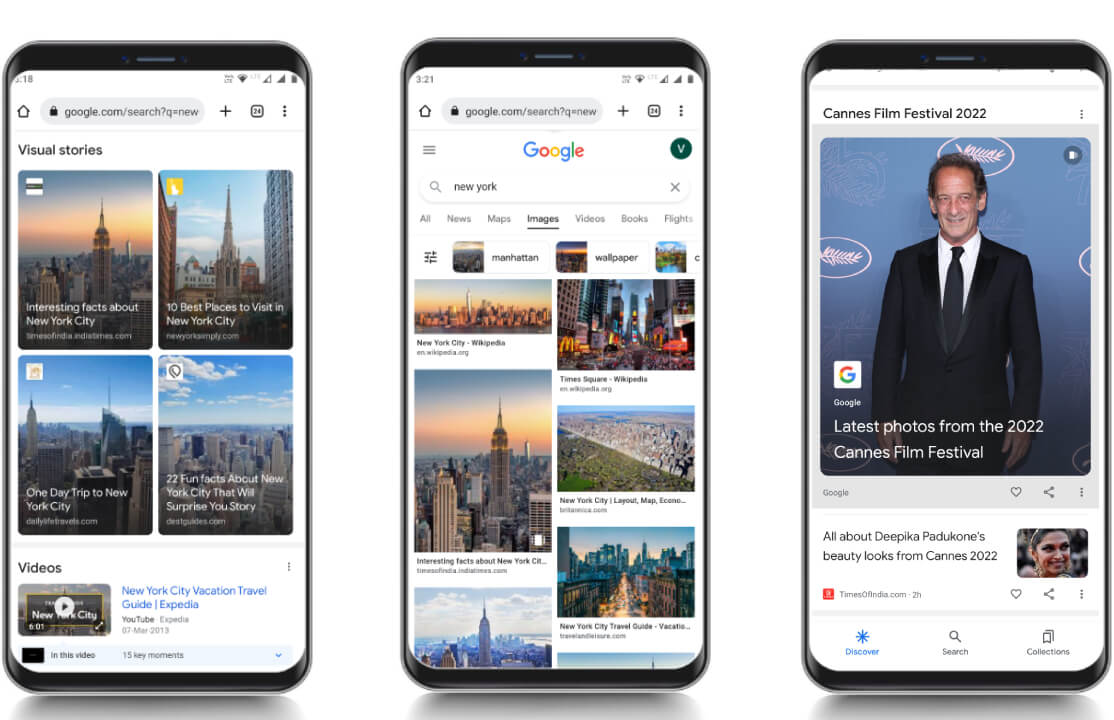
Your Website
According to a survey conducted by Top Design Firms, 71% of small businesses have a website. They want to increase traffic and Google Web Stories is a great way to do so. MakeStories allows you to create, edit, and publish your story to your website. It provides a plug-in with WordPress as well.
Other Communication Mediums
There are several advantages of hosting stories on your website. One is that you can share your content to any of your existing communication channels. These can be emails, blogs, social media and more.
Access on Non-Mobile Devices
Google Web Stories are for users to view on their mobiles. They are accessible on other technological devices. For eg: laptops, tablets, iPads. etc.
Story Ads
Web Stories can appear as ads while users browse. You can learn more on how to monetize Google Web Stories here.
Summary
Google Web Stories are a series of quick tappable images or videos that a user can flip through. You can share your Google Web Stories without restriction to a single ecosystem. Their benefits can help take your brand to the next level. It helps in increasing website traffic and enhancing brand recall.
MakeStories is an easy-to-use tool that helps create interactive stories for the web. It has direct website integration features. Web Stories can appear across Google and many channels if used the right way. Create your first web story here.

Complete guide to create and host Google Web Stories on your Website

The Google Web Stories format is widely available on the Discover tab of the native Google mobile app. It was used by 800 million people each month exclusively.
The Google Stories concept is developing rapidly and increasingly across Google’s search platforms.
Because Google is the first place where audiences learn about a product and meet their needs, most serious websites will undoubtedly implement Web Stories.
The Discover Stories carousel is presently available in the US, India, and Brazil. Web Stories expanded to new nations and Google products in the future.
That is big news for SEO experts, marketers, and content writers.
It moves to satisfy the demand for the most up-to-date consumption, as evidenced by the immersive story format is powered by AMP technology.
What are Google Web Stories?
Google web stories are a full-screen, immersive story concept developed by Google in response to the need to bring stories to the open Web.
It’s incredible to interact with stories. Easily tap on the stories in Google search, and it will open to a full-screen, immersive experience.
You have the option of clicking on a link in the story or swiping left or right to travel to the next page and Stories from other sources that are relevant to the topic you searched for in Google.
The good part is that Google Stories appear in Google results and placements.
This Web Stories tap-through format will give users a more engaging space for involvement, despite the quick tappable pattern that will increase your search engine presence. It provides viral distribution and monetisation analytics and bookend capabilities.
Yes, a web story resembles an Instagram story, but they are vastly different from other platform stories.
The benefits you get from practicing Google Web Stories are ultimately at the next level.
- Control and host Your own Google web Stories.
- Google stories reach a wider audience.
- Completely customised.
Benefits and features you get using MakeStories are:
- Zero coding
- Exceptionally adaptable
- Images, GIFs, and videos abound in this extensive stock resource
- Templates that have been customised and are ready to use
- Total command on the online story
- You can put them on whatever server you like
- Can be readily indexed and linked
- Supports Google Analytics is a tool that allows you to track
- resolutions are resizable and adaptable to any screen size
- By adding interactive elements to web stories, they can become live stories
- Support for different platforms’ integration
- Bookend settings and a variety of publication options
- Component and background setup of the highest quality
- Support Auto-Ads on the Internet
- Support Attachments to the page
- Buttons with CTAs
- Build bookends using the built-in bookend maker
- Configuration of simple elements
- Allows you to make your customised template set
It’s easy to create web stories using MakeStories!
MakeStories, a robust Web Stories builder with a drag-and-drop editor, is another way to create Google Web Stories for various web pages.
There are a lot of customisation choices in the Stories editor. You can animate any part of your Stories to enhance the overall experience. It also allows you to build Story Ads. (which are supported by Google Ad Manager and Google DV360) (Public Beta).
Follow these steps to get started with MakeStories:
- Make a MakeStories account by registering.
- Build the stories slides by clicking Create Story and using the settings.
- To see or share your stories, click View or Publish after you’re finished.
If you need more information on how to publish and create Google Web Stories for your WordPress Website remarkably, You can click here to see the official step-by-step tutorial.
MakeStories provides the following publishing options: export to zipping, publish through FTP, or to an onl. st short link, widget embedding, WordPress plugin, and HTML iFrame embeds.
Apart from this, MakeStories has its hosting services for Google Web Stories such as we all know. Your Google Web Stories require a home. MakeStories offers the most powerful, secure, and lightning-fast hosting service.
MakeStories hosting services control and spin up your web stories in your chosen server as soon as you click deploy.
It’s just a matter of seconds!
You can sign up for free and book a free demo on a call of 15 mins. With this, you can get your story carousel for your website.
How does it work?
You have to follow two simple steps to make it work for your site!
Create a Custom Domain
Once your server is up and running, you may point any dedicated subdomain or URL at it; the choice is yours.
Start uploading your Web Stories
Now all you have to do is press the publish button, and your content will appear on your domain! It’s that simple!
Below are the benefits of hosting you get from MakeStories hosting services!
1. Simple setup
Once your server is up and running, you may point your dedicated subdomain or URL at it; the choice is yours.
2. Scalable infrastructure
Choose from a variety of page templates tailored to specific industries.
3. Automated sitemaps for SEO
We rebuild your sitemap and transmit it to Google for indexing with each Google Web Story you post
4. Pay as you Go
All premium plans offer 1 TB of bandwidth. You just have to pay if you go beyond 1TB
5. Multiple publishing Channels
As and when needed, you can establish multiple folder structures.
6. Inbuilt CDN for faster delivery
The inbuilt CDN for quicker delivery offers good availability and performance by dynamically distributing service concerning end-users.
A worldwide network of 17 data centers backs up Stackpath’s powerful CDN.
Very soon, the whole process is functioning to be automated, where you can point your subdomain or reverse proxy from your account only.
Conclusion
It would be ideal if you explored this visual narrative technique at the very least using MakeStories.
So, develop your first Web Stories as soon as possible to see an increase in traffic, customer interaction, and improve your revenue capabilities in a flash.
Google Web Stories a new way for Advertising

Google Web Stories are a brilliant opportunity to communicate heartwarming stories when the world needs good information.
The possibility for Google Web Stories to appear in Google search results or Google image is a compelling argument to consider developing them.
You may also include links or CTAs that drive visitors to your site because Google Web Stories are configurable.
Brands can leverage the opportunity to create meaningful and inspiring web stories.
Consider your brand as an image before creating your first Google Web Story.
What kind of stories should you tell?
Use the power of stories to engage people in your brand, and what you have to say maybe a fun method to get them interested in what you have to say.
It is another way to improve your SEO performance.
One of the best features of Web Stories over their social equivalents is that you, the creator, can monetize stories.
That is why like blog articles or videos, we consider stories to be primary content for your website.
Although the Google Web Stories ads ecosystem is still in its early stages, it already supports AdSense and programmatic demand via Ad Manager.
Without any coding requirement, you can now enable these integrations for your Web Stories in the plugin’s settings.
Google Web Story advertising implements seamless and unobtrusive integration into the user’s experience, ensuring they remain engaged and satisfied with the platform.
How do ads placements process in Google Web Stories?
Ads number and placement are controlled by a single an amp-story-auto-ads component in Web Stories.
The amp-story-auto-ads component is nested in an amp-story-auto-ads wrapper. While the user’s reading the story, it dynamically inserts one or more ads. To provide the excellent possible user experience:
Before inserting ads, the Web Stories runtime processes them. It ensures to users that never displayed an advertisement that blanks or unloads.
Ad density is optimized with content ratio to avoid overcrowding.
The amp-story-auto-ads component calculates when and where to place adverts as the user proceeds.
The first ads in a Web Story appear after the first two pages to maximize monetization revenue and increase excellent user experience.
How to start Google Web Story ads
Streaming advertising via a supported ads server is the fundamental approach to adding ads to your Web Story.
Currently, the following ad platforms support Web Story Advertising.
Google Ad Manager
In which you can create,
Google Adsense
In your Adsense account, you can create
- Programmatic Ads
If you are a publisher and looking forward to creating ads in Google Web Stories, click here where you can place custom ads on your ads server.
You need to set up the configuration for adding ads to your Web Stories. To do so,
An amp-ad cannot be placed directly on the page in Web Stories. Instead, the amp-story-auto-ads component fetches and displays all advertising.
The amp-story-auto-ads component must combine with amp-story as a direct child element.
Web Story Advertisements do not require a fallback or a placeholder, unlike standard amp-ads, because they advertised once fully drawn.
<amp-story>
<amp-story-auto-ads>
<script type="application/json">
{
"ad-attributes": {
// ad server configuration
}
}
</script>
</amp-story-auto-ads>
<amp-story-page>
...
</amp-story>
Conclusion:
Google Web Stories are great tools for any business to use. It can be helpful in many ways, but the most common one would be that you share content on your website and then share it with other people through Social Networks like Facebook or Twitter.
That allows more exposure than just having an ad on TV or radio. You can reach out to millions of potential customers at once!
All you have to do now is create high-quality content and encourage others to share it. If done correctly, you will see results within weeks.
There has never been a better time to start creating content online. With so much information available all over the internet, you should try to find something unique that nobody else is talking about this topic.
Start exploring this modern way of advertising and rock on the web!
Why vertical is the future of the content

Video is more popular than it has ever been!
And a large portion of the young population watches videos on their phones. The emergence of cell phones ushered in a new era of vertical visual phenomena.
Vertical content has evolved as a result of shifting user patterns.
Because of the widespread use of smartphones and the resulting changes in how people browse the internet, communicate with friends, and consume content, anything mobile-friendly seems to have become the supreme ruler.
People spend more of their surfing time on their phones and prefer not to alter their handset to view the material.
Indeed, vertical content and cell phones are inextricably linked. Vertical content helps you to succeed with your digital marketing efforts.
The term vertical content does not require any explanation.
The name tells you everything you need to know about it. “Visual content that noticed in a vertical posture is known as vertical content.”
Vertical video is a thing right now, and it will be till the end of time because such incidents occur daily in various story formats.
The story format was the first original video format on the internet. In just five years, it surged to 1.5 billion users. It is also one of the most necessary occurrences that Nostradamus failed to foresee.
Let us begin with some helpful information on why the world is engaging more on vertical format!
- Vertical videos watched on full screen on YouTube.
- Instagram continuously urges people to leave their news feeds for stories.
- Facebook Stories are now accessible from desktop.
- Snapchat has added a slew of new features to its app.
- Google is come up with new vertical Web Stories content.
Let deep dive into the other factors that help you understand the importance of why vertical is the future of content.
The vertical smartphone nature
Vertical content has evolved as a result of shifting user patterns. Because of the growing use of smartphones and the resulting changes in how people browse the internet, communicate with friends, and consume content, anything mobile-friendly is becoming the supreme ruler.
94% of the time, we hold our phones vertically and rarely put them down. People use them to pay their bills while waiting in line at the store.
People do not like to change their handset to read content information because they spend most of their surfing time on their phones.
Vertical content gets increasingly popular on social media networks as more people consume it. Giving people what they want is a wise decision.
Vertical content stomps on horizontal competitors like they’re not even there. According to statistics, Vertical content is the most effective for sales.
Social media platforms are highly attracted to Vertical Content
Mobile devices are well-used to watch more than half of the videos on the internet. 70% of the time, we utilize social media on mobile apps.
According to most social media networks, vertically-oriented content isn’t going away anytime soon. As a result, rather than rejecting change, they accepted it.
Instagram, for example, has been encouraging users to use their ‘Stories’ feature. Stories are 24-hour videos that are brief and vertically organized (unless they get pinned). They also added a similar tool to Facebook with the same name.
Instagram and Facebook are social media networks that cater to mobile users. That means the stories with a vertical format are more immersive because they play full-screen without requiring users to flip their phones sideways.
This vertical format does align with YouTube same as Facebook and Instagram. As YouTube is the largest vertical video format social media platform.
Performance results between Vertical and Horizontal
Vertical video is fascinating once it begins to play. It is difficult to stop it.
Furthermore, it frequently begins to play on its own. Advertisers are well aware of the situation.
That is why they’ve been experimenting with vertical videos for a long time, and the results have been impressive.
Vertical videos have a 9x times greater completion rate than horizontal videos, according to MediaBrix’s research.
Wibbitz discovered that vertical content on Facebook resulted in a 130 percent increase in views and a fourfold increase in engagement.
They also demonstrated that when it comes to clicks and swipes. Vertical content reigns supreme.
Which social media platforms should you choose to showcase your content vertically?
Instagram Stories overtook Snapchat in terms of daily active users within a year of its inception, topping 250 million. That equates to nearly half of Instagram’s total daily active users.
Nine out of ten social media influencers used Instagram to share their stories rather than Snapchat.
On Instagram, more than half of all businesses have created a story.
One in every five business articles will result from direct communication from a follower, potential client, or customer.
Stories are primarily about shorter, on-the-go vertical videos, whereas Instagram IGTV is adapted to give a long-form vertical video format.
On Facebook, vertical video advertising offers a 3x higher CPM rate than horizontal videos.
Facebook also includes stories features that can access from the mobile app with the desktop site.
Vertical videos on Facebook will not have black bars surrounding them on their desktop site, which can be unpleasant at times.
Snapchat
Snapchat pioneered the vertical story format.
Snapchat is also popular among teenagers in the United States, but Instagram has a global appeal.
On Snapchat, over 7 billion video snippets are present every day, the bulk of which are vertically filmed. On Snapchat, vertical video ads are nine times popular than horizontal video ads.
YouTube
YouTube is obedient to horizontal videos for its long history and accumulated content.
There are, however, hundreds of vertical videos, primarily music videos, that appeal to mobile users and earn millions of views.
They unveiled vertical video advertisements for a captivating mobile video experience for ($).
Youtube is used by 62% of businesses, while 90% of customers use it to find new products.
Because mobile phones account for 70% of YouTube traffic, the company began to offer vertical videos without black bars.
About a third of all mobile internet traffic is a credit to YouTube.
Twitter is well-used as a brilliant Newspaper. Politicians utilize it to their advantage. And the majority of brands use Twitter to manage their communities.
You have to be present when others gossip about you.
Vertical content, like other mediums, takes up all of the real estates and works effectively on Twitter.
Videos receive 6X the number of retweets as photographs and 3X the number of retweets as GIFs.
After seeing a product on Twitter, 40% of users purchase it.
It is used as a digital marketing tool by 67 percent of B2B Companies.
The vertical format is supported by LinkedIn, along it is even promoted.
Yes, it is a real business platform, and vertical content can make you skeptical. However, whether a 13-year-old adolescent or a 45-year-old executive, your attention ratio remains the same.
Google Web Stories
That is the chance you have been looking forward to being.
Google is attempting to turn the internet into a massive Instagram feed. Google will enhance your traffic if you use Web Stories (once known as AMP Stories).
Web Stories resemble the traditional story format that is probably aware of how addictive stories can be, right?
Web Stories allow you to uplift your content and increase your page load speed. That will initially impact your website speed and your Google ranking. So be a groundbreaker of experimenting with Google Web Stories.
To summarise. These things will happen if you start building Web Stories by using MakeStories.
Yes, you heard right! MakeStories is a leading web stories builder or web story creation tool approved by Google.
You can start with tons of features, multi-purpose functionality, 100+ ready-to-use templates, audio-video support, and uncountable customizations.
Conclusion:
Although Snapchat invented the Stories format, Twitter, Facebook, and Instagram, now Google Web Stories, all offer vertical content-sharing features. Furthermore, statistics reveal that mobile devices account for more than 75% of global video viewing. That shows how social media sites and Google itself are joining the structure, so if you don’t, you’ll be at a significant disadvantage.
Consider where your work will be viewed, consider mobile, consider vertical, and try to use what you have learned whenever possible!
Hold your smartphone upright before pressing the record button from now on!
So, why not you are upgrading to vertical content?
How to easily optimize and compress images for Google Web Stories

Users expect to load a story within a fraction of seconds or less. If it takes more than 3 seconds to load, 40% of visitors tend to leave your story page.
The only way to fix this problem is to optimize the images. There are additional resources available that may assist you in increasing your loading speed.
But if you have already done, the rest then image optimization is the best solution to increase your page load speed. You can fix this, and it is easy to do that.
Unoptimized images are the image that restricts image to have a file size of no more than a specified ratio of the image size on the open web space.
You know what, the number one reason why your web story load so slowly are unoptimized images.
According to HTTP Archive, photos make up about 65 percent of the weight of a website. If you do not optimize your website images, your page may load slowly, which will give your visitors a negative impression of your site.
Image optimization is critical for e-commerce, blog, portfolio, travel, and media websites.
What does Image Optimization mean?
Image optimization is a technique for reducing the size of website photos without sacrificing their quality.
It entails delivering the highest-quality photographs in the correct dimension and format while limiting the image size to a minimum.
Benefits of image optimization
- Improves website load speed is one of the main advantages of image optimization.
- It is possible to preserve server memory and minimize server load.
- Increase the number of conversations.
- It will Improve the user experience on the site.
- Aids in the improvement of an SEO rating.
These benefits will make you understand why it is necessary to optimize your unoptimized images before uploading them on the open web.
Now let talk about how you can optimize and compress images for Google Web Stories. As you all know, web stories are an emerging trend followed on open web space by Google.
Many other platforms like Instagram, Facebook, Youtube are already using this feature, but Google Web Stories are offering is a little different and exciting.
These online stores do not live on Google; instead, they live on your website, just like a typical web page. As a result, it is your responsibility to ensure that all of your on-site consents load quickly.
One of the main drawbacks of image optimization and compression is that it appears to be a very complex subject.
If you Google the issue, you will discover a slew of long essays that make it seem like you will need to become a coder to do it.
But, do not worry, there is nothing like that you do not need to do anything.
Just follow the few tips of Image optimization and see the wonders right away.
- Should not leave them on a resolution that captured.
- Discard anything that is not visible on your story page.
- Choose the suitable image file format that fits your story page.
Pro Tip: If your image is animated, replace it with a video!
Your source image is most likely a GIF if it is animated. GIF files are poor for everything you do on the internet.
So, for a far richer color palette and a much smaller file size, do yourself and your reader a favor and use a video for looping animations.
Continue with a follow-up query if your image is not animated.
Is it a photograph or a painting?
If it is a photo, JPEG or WebP are the best options.
PNG or WebP are the best possibilities if it is not a photo.
All current file formats, like.zip files, use some form of compression to make them smaller.
When you present a digital image of a wall painting, it is composed of pixels. Of course, you could record the color information for each pixel, but there is a good possibility that many of them are the same shade.As a result, saying that the following 15 pixels are all the same is much more efficient.
The basic principle of image compression is this. The actual compression method is far more advanced currently, and it has vastly improved over time.
Each one of today modern picture formats has its own set of benefits and disadvantages, and the more you learn, the better you understand.
But the formats I am going to talk about right now, WebP and AVIF, are two that you may not have heard of before.
WebP
A relatively new file format that is versatile and may use in several circumstances but is not suitable for all applications.
WebP is not even appropriate for other browsers.
AVIF
That is the latest cool kid on the block, and it is even more adaptable than a WebP. Support a wide range of scenarios and reduce photos to a fraction of their original size.
Chrome and Opera are the only browsers that support it right now.
You may wish to leave a portion of an image transparent on occasion. That can be overlaid on top of any other background if the background is transparent.
However, not all file formats offer this feature known as an alpha channel. JPEG does not, which is why it is solely helpful for photos. However, transparency is allowed by PNG, WebP, and AVIF.
To the rescue: Tools that may help you optimize images
If you are using a content management system (CMS) like WordPress or Drupal, there are plenty of free and commercial plugins that can automatically do this process. You never have to bother about it again.
Directly type image optimization followed by the name of your preferred CMS.
If that is not an option for you and You should manually optimize. There are plenty of high-quality free apps available.
TinyPNG, JPEG Optimizer, Optimizilla, Kraken.io, CompressNow, Compressor.io, and many more other image optimization tools are available out there for you to compress or optimize images.
These are free tools that you can use without buying a subscription.
There are Paid tools like EWWW Image Optimizer, Squoosh.app, Imagify, ImageRecycle, and more are also available for image optimization.
Conclusion:
It’s up to you guys, what you’re looking for, and your requirements. Make sure these optimization tools can fit in the chart of your necessity.
To ensure that your websites load quickly and deliver a better user experience, you should optimize your images. Although many image optimization programs are accessible, I tried to condense the list and provide you with the best of them.
Image optimization can help you improve your SEO and drive more traffic to your website.
Best ecommerce trends to follow in 2021

It would be an understatement to say that the previous year was frantic. Nobody knew how long COVID-19 would last or how it would affect us once it arrived.
More than ever before, merchants are establishing and-or improving their eCommerce businesses to meet customers where they are.
While it looks like everything in eCommerce is changing, we’ve narrowed it down to the most critical trends that will affect businesses in the coming months and years.
Tourism, live entertainment, hotels, and sports are just a few industries that have suffered significant losses.
However, some people saw not just progress but an exponential increase. One of these is eCommerce, in all of its various forms.
As a result, if you want to stay current with modern eCommerce, you must be aware of the latest eCommerce trends in 2021. If you are not, we are here to assist you.
Exclusive Delivery Methods
Customers came to anticipate a certain level of practicality as more stores turned to e-shopping to earn a profit during COVID-19.
It used to be routine for retailers to ship their merchandise in a week or two. Customers, on the other hand, have come to anticipate same-day delivery.
Due to the increased demand, stores have grown rather inventive with delivery methods and have discovered new ways to improve their efficiency.
Some establishments use electronic scooters to distribute their wares, while others use bikers. Drones are also under-investigated, but this technology is still in its early stages.
You should maintain how efficient your delivery is for marketing purposes. Positive customer feedback is always a good idea.
However, it is critical to clarify your shipping method to your clients and ensure that their shipments are always on time.
Consider giving a brief presentation based on a storyline as an entertaining method to explain how efficient your shipping is.
Ease of use
Ease of use is one of the most popular e-commerce trends that has quickly made its way into marketing.
In particular, shop owners have realized in recent years that simply offering things at reasonable rates is not enough. Instead, go out of your way to get to know your customer. You may target your customers directly and make the correct offers at the right time once you know who they are.
Ease of use is the term for this practice, which has become a standard in good marketing.
When you grasp the current state of web marketing, you’ll realize that ease of use is the only method to engage your audience.
Regardless of who your target audience is, they are continuously flooded with marketing information, the majority of which they are uninterested in now.
As a result, for your content to stand out, it must be created in such a way that it draws the viewer’s attention organically.
To do so, you’ll need to customize your marketing content and determine what works best for your target demographic.
The better your marketing content performs, the more you have to tailor and categorize your audience into more specific categories.
Recyclable
Being environmentally conscious isn’t a new concept in marketing or e-commerce. But it’s a concept that’ll be around for a long time.
Climate change is still a problem, no matter what is occurs in the world.
As a result, whenever you can make your firm more environmentally friendly, you should do it first and later advertise it.
More and more people are attempting to contribute to environmental protection. And a sizable portion of them is even willing to spend extra if it means their money is going toward more environmentally friendly corporate operations.
As a result, the more you can match your business with environmental sensitivity, the better off you’ll be.
Story Formation
The average customer’s attention span has shrunk as marketing and eCommerce technology evolved.
While specific measurements are problematic to establish, it is safe to assume that clients will not pay attention to extended material, no matter how engaging.
Because of this lack of attention, Google began promoting Web Stories as an emerging format for marketing content.
People are familiar with story content because it can easily share on social media.
However, if you use tools like MakeStories to create stories, you can effortlessly attract the interest of your audience.
People nowadays prefer to view content in a story format, whether in photos, text, or video.
You can Consider the recent success of TikTok, Instagram reels, and other video Apps.
Ecommerce Marketing Future
When you consider developing transportation technologies, the total convenience of online purchasing is hard to top.
Personalization is likely to become more common in marketing in the future.
Companies are becoming increasingly adept at tracking client internet behavior and anticipating their demands.
We wouldn’t be surprised if, after a while, practically every marketing content you view is custom-fit to your preferences.
If you’re wondering what your next marketing move should be, we recommend using online stories and VR(Virtual Reality) content.
Web stories are a cost-effective approach to providing new and entertaining material because they capitalize on the familiarity of story content (as seen on social media).
In terms of virtual reality, We believe that widespread adoption is still a long way off. However, given how difficult it is to develop effective VR content, we recommend that you begin your research right away.
Conclusion:
Given the effects of COVID, the year 2020 will be a watershed moment for eCommerce. The pandemic has accelerated developments in various fields, and this tendency is conventional to continue until 2021 and beyond.
Nobody will ever forget the year 2020. Opportunities were there to be grasped, at least in the eCommerce space, and with these few trends already gathering steam, 2021 might be a year to remember—hopefully for the better.
Which eCommerce trend are you going to capitalize on top?
Tips to Become a Better Visual Storyteller

Storytelling is the art of communicating information through pictures, words, and sounds. That can be helpful for education or entertainment purposes.
We all want to make something that will catch public attention, transmit the message we want to go out into the world as well as if at all possible, trigger a strong emotional response.
When it comes to our online presence, we want to be understood, accepted, and appreciated. Visual storytelling is one of the best ways to achieve such objectives.
An excellent visual storyteller should have an eye-catching presentation that will capture your attention. The best way to become a better visual storyteller is by practicing storytelling techniques on everyday objects to improve their skills.
Here is not all that unexpected. Visual storytelling, when done correctly, may capture your audience’s attention and help you generate outstanding outcomes from your content.
Readers of interactive visual stories stay on the page longer, bounce limit, and are more likely to click any calls-to-action.
Creating an intelligent interactive visual story is easier than ever recognition of the rise of no-code platforms!
We will go through some practical visual storytelling tips in this article that benefit you to become a better visual storyteller.
1. Should be aware of when and how to use words!
The combination of text and images is the true powerhouse of any marketing campaign. The combination of these can and can assist you in getting your message across to your intended audience.
While pictures have their advantages, excellent visual storytellers will never eliminate words. Through, a little context is advisable when your storified ads need direct CTA.
The quality of your text data will help you rank higher in search results, making your website and articles more popular and transparent to find in the ever-growing sea of web content.
Spec sheets, e-books, and testimonials, for example, can be tedious at times, but they provide a wealth of data and precision when developing and implementing any marketing strategy.
All other stuff is significant and trustworthy because of them.
2. Must keep reasons for everything you do.
With all of the essential information from the top of your head, you should know what kinds of visual content you have to create.
Then formulate a plan for bringing your ideas to life and presenting them in the best possible way, which means carefully selecting your social media weapon.
The nature of the content determines the channel via which it will communicate and vice versa.
Every social media site has advantages and disadvantages. On YouTube, an infographic would not help you much though it will be a great addition to any storified content.
3. Story should be captivating.
Visual storytelling is more than just a beautiful image or a stock video stirred up on your company’s Facebook page now and then.
Even if you are the best storyteller on the planet, without an overall theme, a defined purpose for your story, and without this viable plan directing your every action, your outcomes will be less than ideal.
It is crucial to build an appealing web presence that is consistent throughout all the web channels or at least those that your target audience considers most significant, but before you do so, make sure you have something worth communicating or sharing.
4. Maintain a proper structural Story.
It is always a good idea to keep the tried-and-true fundamentals in mind. People have discovered that these narrative elements can withstand the test of time, therefore always include one in your story.
Use Your imagination when telling stories. It is essential to use your imagination. You do not need to add every separate detail but try to make sure there are enough details. So people know what they are looking for in this story.
For example, if you want to show someone how to cook spaghetti, then instead of drawing each strand of pasta, truly focus on exhibiting how to cut up the ingredients into small pieces. That makes it easier for others to understand because they would not get confused with all different shapes.
Be Creative you want to impress your audience, then you must think outside the box. Do not stick to only using one type of style when creating visuals.
There are many ways to create great images, so keep trying until you find something that works well for you.
Appropriate timing! Give your story narrative drive or a set speed that makes it enjoyable to watch and follow.
As much as possible, keep your story simple. You are golden if you can sum everything up in one sentence. Complicated visual and textual features are too distracting, so keep things simple.
The combination of contrast and proportion is quite effective. When you are aiming to highlight the distinctions, and importance of the main components of your story, use these pillars of visual storytelling language to your advantage.
5. Keep learning new things.
Find what works best for you, and in which form of people, their vibing, their creative productivity, etc.
Learn everything you can about your target customer, including what inspires them and how your brand may help them solve their problems.
Keep in mind the distinction between the storyline you want to tell and the story they want to hear or see.
Fantastic storytellers will figure out how to do both at once!
Belief these incredible and practical tips to become a better visual storyteller will help you become a successful storyteller.
How to enable Web Stories on Google?

There are a few simple steps, how to enable Web Stories on Google.
While Creating Web Stories, one of the most important steps is to enable Web Stories on Google.
Now you may be aware of what Web Stories are and how to create them?
Let me explain to you in brief here.
Google Web Stories are web-based versions of visually tappable storytelling format that combines video, audio, graphics, animation, and text to create a dynamic viewing experience.
By tapping through the content or sliding from one piece of content to the next, you can explore it at your leisure.
To learn more about Web Stories, go here. What are the benefits of using Web Stories? This article transpires here, as well as another related article on the MakeStories blogs.
Did you know that there are fundamental steps to take to enable Google Web Stories? If not, then follow these steps one by one and set up your web stories on Google.
Enabling stories gives you an excellent platform to promote your business to your target audience while also allowing your brand to appear on Google.
- Create a story
- Make your Story AMP Validated
- Verify Metadata Property
- Make sure the Web Stories is indexed
- Follow the Content Policies
All the above points must follow while enabling Google Web Stories. Let is go through all these steps one by one to complete the procedure outlined below.
- How to create a web story
- Under the hood, Web Stories are web pages, and they must adhere to the same principles and best practices as conventional web pages.
- You can begin in one of two ways.
Choose from several Story editor tools to get started making stories without having to know how to code
You can get started with AMP if you have engineering resources. We recommend using Chrome Developer Tools to simulate multiple device sizes and formats to guarantee your Web Story renders correctly.
Review the Best Practices for Creating Web Stories to guarantee a seamless experience.
- AMP validation
- Ensure that the Web Story is genuine AMP when you have finished developing it.
- A legitimate AMP story follows all of the AMP guidelines.
- Here you enable the Google Web Stories via the AMP cache, which will be improved the performance and give your users the greatest possible experience.
- To check that your Web Story is genuine AMP, you can use the following tools.
- Google web stories test tool: Check that the Web Story is valid using the Google Test Tool.
- URL Inspection Tool: Verify the Web Story is thoroughly AMP and that the URL is indexed correctly by Google.
- AMP Linter: Use the command line to validate Web Stories during development.
- Metadata Verification.
- Provide the appropriate metadata to surface the Web Story in the preview for your Web Stories to appear on Google Search or Google Discover experiences.
- See the whole list of metadata.
- In the Web Stories Google Test Tool, double-check that your Web Story preview is correct.
- Every Web Story must include the following fields publisher-logo-src, poster-portrait-src, title, and publisher.
The above things have to be satisfied while verifying the metadata of each Web Story.
- Indexing
- Check to discover if your Web Story is indexed correctly by Google Search.
- Submit individual URLs using the URL Inspection Tool or review status using the Index Coverage Report or Sitemaps Report.
- If your Web Story is not indexed, here is what you should do.
- Check to discover if your Web Story has been indexed correctly by Google Search.
- Submit individual URLs using the URL Inspection Tool or review status using the Index Coverage Report or Sitemaps Report.
- Every Web Story has to be canonical. Ascertain that each Web Story has a rel=”canonical” link to it.
- P.S.: If you have many versions of the same Web Story in other languages, make sure Google is aware of them.
- Make sure the Web Story URL is allowed by robot.txt or the index tag from Googlebot.
- Link your Web Stories from your site or add your Web Story URL to your sitemap to make it easier for Google to find them.
That is all you can do to enable your Web Stories for Google. Set Up Web Stories on Google is as important as you do SEO of your site.
There is no value in your Web Story if it is not on Google. Use above mentioned steps and start to implement your Google Web Stories now.
Interactive content ideas to engage your audience
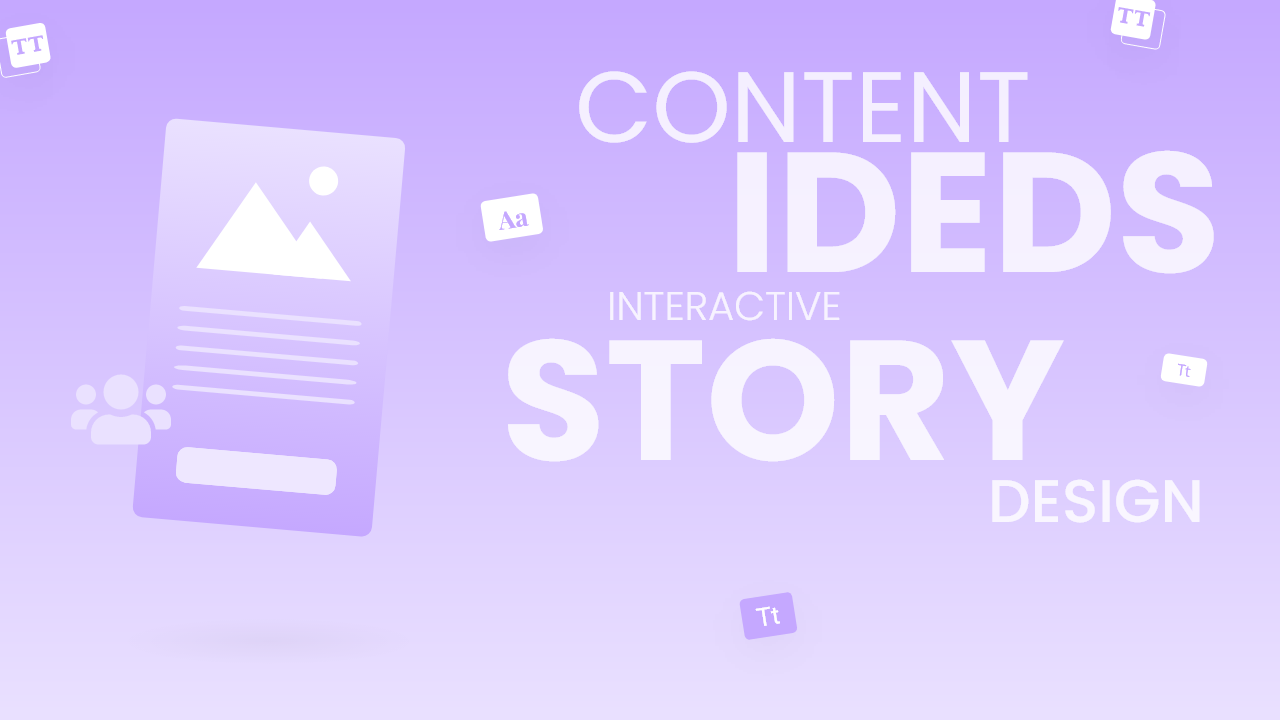
Looking for a way to make your website more interactive. You might have been thinking about using some sort of quiz, but not sure if that is the best approach or even possible?
Of course, content should be both creative and interactive!
Well, first off you need a good idea!
That’s right, it doesn’t matter how great your design or layout skills maybe if there isn’t an interesting concept behind your website or digital marketing campaign.
If you don’t have a unique angle on something then chances are people won’t want to read about it. You can use social media sites like Facebook and Twitter to get feedback from friends and family before creating any new content.
This will help ensure that your audience has enough interest in whatever topic you’re writing about so they’ll actually stick around long enough to see more.
Using interactive stuff to drive interaction and mix up your standard posting approach is a fantastic way to do both.
Interactive content engages your audience, boosts click-throughs, and gives you more possibilities to educate and entertain your audience.
Why is it important to be interactive?
Based on user experience studies and our findings from previous engagements, we discovered that consumers are more inclined to engage with and consume content when it is presented in a pleasant and engaging way.
Interactive content is not only more visually appealing, but it also minimizes the quantity of information your viewers must comprehend at one time.
So we use these tactics to promote more interactions and content engagement in the audience! Let’s discuss them in detail below!
1. Quizzes / Polls
Quizzes can be entertaining or useful in determining where your audience stands, which can lead to an opportunity for you to sell your product or service.
They can assist you in delving into the minds of your target audience and producing twice as much data.
Examine your text for a statistic, a key takeaway, or a data-filled chart that you can incorporate into an engaging quiz.
An essential remark can simply be turned into a true or false quiz. And if there’s any long chart of information, divide the information into different questions.
Another advantage of polls and quizzes is that they demonstrate to your audience that the conversation is two-way and that you value their input.
2. Image transitions
Transitions are animated changes between two slides or more. The image transitions component can make smooth and immersive transitions between the slides in your web story.
You can pan and zoom across the background images by using this transition component. Even, possibilities are high to build beautiful parallax effects by using transitions.
This interaction with the audience is so immersive and engaging that a viewer cannot resist leaving a story in between.
3. Immersive 360 video
360 video allows you to include 360-degree immersive photographs or video in your Stories. With the gyroscope sensor in your mobile device, you can either guide the user’s perspective through crucial locations or allow them to control to explore.
4. Multiple choice posts
Web stories allow you to provide multiple choices of posts by providing multiple slides for an individual story.
Multiple choice posts can be entertaining when you get an opportunity to represent your business in all different aspects of marketing.
Every visual represent a distinct option for your audience to choose from; you can use this strategy to allow them to assist you in selecting your next product or service. Because you’ll effectively be giving people what they want, you’ll engage them, gain their feedback, and generate more sales.
5. Appealing infographics
These are a little expensive to make, but they can be a lot of fun for your audience to connect with.
Hover pop-ups or click-throughs to other landing pages, quizzes, supplemental content, and more can be included in interactive infographics.
They can be a wonderful way to educate your audience about your business or product. An infographic with calls to action or amusing pop-up facts fits a lot of information into a small space. You can utilize snippets from the infographic or develop fresh user-generated content using the data in the infographic to promote them on social media, with a call to action to direct traffic.
Conclusion:
These are some of the best ways to interact with your audience by using web stories and interactively representing your product or service to boost engagement.
When it comes to establishing social media exposure, engagement is becoming increasingly vital. Hopefully, these interactive content ideas have inspired you to consider how you may implement similar ideas into your workflow by using Google web stories.
Best practices for creating Google Web Stories

Google Web Stories is a feature of Google Search that allows users to create and share short animated videos in the form of Web Stories.
The user can add text, images, or video clips into the story before publishing it on their website in order to make it more interesting for other people who might be searching for similar topics.
Users are able to publish multiple versions of each story with different titles, descriptions, and tags. The first time I heard about this was when my friend told me he had created one and shared it on his Facebook account.
He said it got over 100 shares within just 24 hours! That’s pretty impressive, isn’t it? if you ask me because most of them were complete strangers, and it’s incredible to get unexpected viewers on your page and website.
That does not only help you to reach your target audience but also speed up the process of creating awareness about your product.
So basically, Web Stories are a good way to boost traffic on your website. But while creating those web stories, you should follow these best practices for creating web stories!
What are the best practices of creating Web Stories?
Let’s have a look on each of them in detail.
1. Design
- When creating online storytelling, the first thing to remember is that the design should be unique and appealing to both the content and the audience.
- Reduce the amount of text you use and avoid using too many text walls, which might fade your design skills.
- Animate your stories to bring them to life. Avoid animations that are distracting or repetitive because they can create weariness.
- Incorporate full bleed visuals into your stories to give readers a more immersive user experience.
- We advise video clips that are fewer than 15 seconds long each page, with a maximum of 60 seconds.
- Make sure speech is audible by using high-quality audio clips that are at least 5 seconds long along with a moderate pitch.
- Avoid using disorted and low resolution visuals and please be careful while resizing them
2. SEO
- The most important thing you can do is provide high-quality content material that is informative and engaging to your viewers.
- To keep your readers engaged, include a whole storyline and follow storytelling best
- In your story content, don’t use the noindex property, which prohibits Google from indexing the page and preventing it from displaying on Google.
- Add your Web Stories to your sitemap as well. The Index Coverage Report and Sitemaps Report in Search Console can be used to see if Google can discover your Web Stories.
- Make sure your Web Stories adhere to the AMP story metadata standards. Include meta tags, title, descriptions, structured data, OGP, Twitter card, and another markup that would ordinarily be seen on a web page.
- To optimize your story’s discoverability, we suggest adding alt text to your photographs.
- Web Stories should be integrated into your website by connecting to them from your home page or category pages, as appropriate.
- To assist viewers to comprehend your story, include captions in your video.
- To avoid overlapping with other information or flowing off the screen, avoid captions that are burned into the video.
- To create your Web Story, we recommend using semantic HTML.
- Additional material can be presented with your Web Story using AMP story page attachments.
- This might be handy for providing further information, deep dives, or forward excursions for the content in your Web Story.
3. Technical
- Web Stories must be AMP-compliant. Test your Story using the AMP Validator tool and repair any problems found to avoid invalid AMP issues.
- Make sure the picture connected to your poster portrait property is 640x853px and has a 3:4 aspect ratio.
- Make sure the logo image connected to your publisher logo property is 96×96 pixels with a 1:1 aspect ratio.
- To boost the discoverability of your content, including an original images in your meta tags.
- Avoid utilizing photos with burned-in text, as this could obscure your story’s title!
4. Storytelling
- Text and images are less engaging than video. Use as much video as feasible, with photos and text to fill up the gaps.
- Go far beyond the facts to find out more. Let us know what you think. Be the main character in your own story. Make it relatable to your audience.
- From one page to the next, build suspense in your storyline. By giving context and a narrative, you may help the user along the way.
- Give Payoff for sticking with you to the end.
- Set visuals and animations to put things carefully in a style that fits your design.
- Separately animate your elements to keep your images lively.
- Make use of embeds. Embeds allow you to add more dimensions to your web story pages.
- Use a cover for your online content to draw in viewers. With a catchy title and engaging image, the cover should reflect what your business stands for.
- Your web story’s cover serves as a packaging element. It should be appealing on all levels.
Ensure that everyone can see your story online.
5. Others
Conclusion:
These are the best practices for Web Stories, which help you to build healthy yet competitive Web Stories.
If ever, you’re looking forward to en route how to build a healthy web story or how to build a Web Story, then please follow the article listed here.
It will surely help you to establish your product or service in an appealing way with an amazing digital presence on the open web.
Apart from all the above best practices, if you still find difficulties in creating the best Web Stories feel free to contact us.
Our team will be happy to assist you and ensure you that you’re on a right track in the process of making Web Stories beautifully.
Top Web Story builders

Thinking of Considering Google web stories for your website?
Web stories builders are the best way to build engaging Web Stories without any development skills.
These Web Stories tools help you to design eye-catching Web Stories for your target audiences. It also improves your presence in the Google search engine.
Have you ever wondered, which Web Story builder is the best for you? For your businesses?
In this article, we’re going to talk about the industry’s most popular Web stories builder on the go-to market.
Check out these amazing Web Stories creation tools mentioned below.
1. MakeStories
MakeStories is the most popular web builder with so many user-friendly features.
Free images, Gifs, Videos, illustrations, stickers, various shapes, gradients, templates and so much more to get you started.
Drag-drop design interface, creative animation effects like text animations and background animations, auto animations, and various background effects allows you to create a stand-out web story for your WordPress site.
Various background effects such as color, gradient, texture, and Scrim overlay floats your web stories on a different level.
They do have multiple options for adding up interactive elements in your web stories such as Yes/No Poll, Embed Twitter tweet, Quizzes, Polls, and the addition of audio files in each slide or choice of your slide.
MakeStories does allow you to build your templates from scratch. MakeStories is a multilingual Web Story builder that supports seven different languages.
You can host your own Web Stories by using MakeStories web hosting support. You can have your web space where you can share your stories with team members directly.
MakeStories editor, MakeStories WordPress plugin, and soon MakeStories Lite – the industry’s first mobile application coming up for building web stories on mobile devices.
If you just want to explore it, take a quick tour to makeStories editor by signing up or creating a MakeStories account. You just need to log in to the MakeStories editor and click on the “Show Me Around” tab situated down to the left corner.
MakeStories is the lightest and one of the advanced options available for building Google Web Stories.
2. Google WordPress Plugin
Google Web Stories WordPress plugin allows you to create stories within your WordPress website’s CMS.
It is a free, visually narrative storytelling format available to build engaging and tappable stories interaction on the open web.
They have a WordPress media library along with access to hundreds of template designs. For a WordPress site user, this plugin may be the seamless solution that allows you to publish stories right to your website.
Customizable color backgrounds, text style presets, various interactive elements and a lot more to get started with this web stories WordPress plugin.
3. Newsroom AI
Newsroom AI allows you to build Google Web Stories without any charges. They offer so many features with the free version.
You can easily embed your stories on the website with a free version. They do allow you to get your analytics reports with Analytics features.
You just need to set up your account by using your Google account and you can start creating your stories by clicking on the “create story.”
When you switch to create a story, Newsroom AI allows you to choose different templates, choice of photos, texts, and videos with limitless design options.
They do have a paid version in which you are allowed to leverage Google ads for yourself. Apart from this, you get access to the editorial Getty images and Getty videos.
4. StoryFiMe
StoryFiMe is an all-in-one Web Stories builder used popularly by E-commerce, Marketers, and publishers.
Whether you’re a brand or an individual, you can freely use this interactive web story creation tool.
StoryFiMe allows you to sell, create funnels, mobile landing pages, and create wonderful storytelling of your brand. They help differentiate individual customers by providing tailored content or personalized services as per the individual needs. This is a game-changer approach offered by StoryFiMe to delight their customers.
Provide unstoppable experience by giving various distribution visual mobile experiences on websites, social media embeds, QR codes, google search results, or anywhere, they allow you to share your stories anywhere.
You can get powerful insights with a built-in Analytics tracker. It will help you to interact with your customers easily and effectively
5. Ampstore
Another popular Web Story creation tool that allows you to build web pages likewise web stories.
Optimized for mobile content, zero-coding requirements, webpage integration, and so many interactive features to get started with.
They have pre-built templates, free stock images, and drag-drop capabilities to drop images, videos, gifs, CTA tabs, etc on the canvas.
They have special stories plans for professional web creators and SEO professionals which can be canceled anytime if professionals aren’t needed anymore.
Several text elements, background elements, SEO opportunities to build your brand or site, autoplay features, backup of previous contents, trackpad support and so many updates have already been released and others are still on the way to get released soon.
Conclusion
So these are the top most popular Web Stories builders. Create and share your stories by using these Web Stories builders and grow your digital presence.
Adding videos in stories can significantly engage more audiences and build trust within your customers.
If you need any help in making your Web Stories, let us know, we will be happy to help you!
What are Google Web Stories and why you should use them in 2021/before it’s too late!

Table Of Contents
Introduction to Google Web Stories
If you guys are here to ask me what are the Google Web Stories? Why should you use them? Then let me tell you guys that,
Web Stories are something newer that Google is offering!
What are Google Web Stories?
Google Web Stories is a new way to create and share interactive, animated storyboards for the web. It’s like an online version of Adobe Flash or PowerPoint that you can use in your browser without having to download any software.
You’ll be able to add photos, videos, text, shapes, music, animations, transitions, and more. Google also says it will support the latest versions of HTML so you won’t need to worry about compatibility issues on older browsers.
Google has been pushing the idea of using Google Web Stories for a while now, and it’s finally starting to catch on. It’s an interesting concept that allows users to create their own story in which they can add pictures and videos as well as text.
The best thing about this is that all these elements are stored online so if someone wants to read your story later or share it with others they don’t have to download anything. They can read, share, and create Stories anytime they want.
These Web Stories are mobile-friendly or mobile optimized so we people see them on mobile when we’re searching for anything.
If you search for travel stories like places to visit in New York in Google search on your phone, then it shows you stories related to your search at the top of your google discover search results.
Google pushes stories out related to your search on top of the search results in your phone search.
Why should you use Google Web Stories?
If someone is looking for anything, Google will show a story even if your post, page, or site doesn’t rank first on Google, and if your story shows up that is automatically giving you a kind of leg up on traffic.
Web Stories are a really good way to show up on a Google discover to kind of get boosted into the top tier. This will lead to people seeing your site and seeing your information more.
So further, we will show you a sample of a story that we have created for —–
This is what it looks like on a desktop. But on a mobile device, of course, it will look more mobile-friendly.
When you view this on a mobile device, you’ll notice that the cover image automatically scrolls through, moves through and that there’s an opportunity to swipe up, which leads them to the whole story walkthrough. In which you get to see good information, valuable information about your search.
Again, you will most likely see CTA buttons in the Swipe up tab, where additional information is available in detail for a better understanding of your search
These Web Stories can be monetized with ads, so this is another good way to boost your ad income and it’s a really good way to just kind of show up on Google discover.
Start building stories for your product or services and see a steady increase in organic search traffic.
You can see, in the above pictures, Google rewarding these sites that have represented their brand using Web Stories.
So not only did the clients get traffic from the stories and the swipe-ups of the stories but also doubled the amount of traffic and ad income from Google from Web Stories.
There’s a lot of different reasons to be using these for your business and your website. We’ve seen many of our clients gain traffic, not on just Google Web Stories but actual people clicking from the google story to their site within a day. That’s an addition to this we have seen across other sites so there’s a lot of reasoning behind using it.
The other thing is that the bounce rates on these are lower because people are searching for what they’re being shown stories for.
So it’s already an engaged audience. People use affiliate links within them, affiliate links for clients to increase their revenue.
You have to be consistent in publishing stories before you start to see Google is pushing and rewarding traffic. After that, it continues to be up and down, so it’s not like a steady stream of increasing traffic but it can be volatile.
Web Stories offer a slew of extra advantages in addition to massive lead generation potential.
They perform well on the web and in terms of user engagement, proving to be a cutting-edge content format that is bound to take over the internet.
Before it’s too late, let’s have a look at other benefits you get while creating Google Web Stories for your business.
- Fast loading web pages
- Mobile-first approach
- Highly effective for your business in terms of engagement
- Search engine friendly
- Monetization opportunities
- Visually rich and appealing to your mind
You can remove text-heavy content and engage your readers with colorful images, compelling animations, and videos using the Web Stories format.
Stories appear to be very different from standard web pages as a result of this. Because readers prefer visuals over words, visually rich Web Stories are ideal for them.
Users have shifted from desktop to mobile in recent years. Web Stories are designed to work on mobile devices.
Web stories are full-screen and tap-through, allowing users to immerse themselves in the experience. They’re designed for mobile, but they look great on any device.
Conclusion
So there’s no way to say NO to Google Web Stories!
It’s better to use Web Stories in 2021 for your business before your competitor’s site gets rewarded by Google.
These Web Stories are not at all harmful in any way, so start exploring them.
Web Stories – Is it Worth It?

Are Web Stories worth making?
Google Web Stories are the next big thing but I’m wondering if it’s worth your time?
Sure it looks appealing and coming to the Google search results and Google does release a plugin for WordPress that allows you to make these stories.
Even third-party plugins are also available such as MakeStories, StoryfiMe, Newsroom AI, and many more Web Stories builders are highly popular and used by many web creators
Let’s see, if it’s worth your time!
These Web Stories are not being shown yet on a wide-scale basis in the Google search results. You must have seen these types of stories before they were originally on Instagram, Facebook, and they’re on YouTube as well.
Let’s have a look at how these Web Stories will look on Google search results!
For now, these Web Story appearances will only work on a mobile device by the way, and will not show in the normal search engine results on the desktop.
When you start scrolling the Google discover app, you will get to see a different section called stories, where you will see different stories related to food, fashion, lifestyle, news, celebrity, and so on.
The moment when you started going through stories together by clicking one of them. You can see it’s a very immersive experience and you have basically an image or may have a video and some text overlaid on it.
You’re allowed to have one link per slide. However, if you’re into affiliate marketing, we do not recommend using more than one affiliate link for the entire story.
So as you click on the first slide, it will switch to the next slide and on top of the slide, you can see ever so faintly if it’s going automatically. You will see a time continue to be taken up before it goes.
Basically, you need to click through all slides just like you see in the video below. This process can be automated by turning slides into auto-advance mode.
In all of these slides, you’re getting an image and you’re getting a bit of text.
Google recommends for these Web Stories that they are a minimum of four to five slides up to about 30 slides or so.
Google has also released Web Stories guidelines for these stories.
Creating a Web Story is just so easy. You just need to download the plugin for creating Web Stories in WordPress.
I have created many Web Stories using the MakeStories plugin for WordPress. Below you can see how appealing and engaging my Web Story did look.
So firstly, you have to create your MakeStories user account and download the MakeStories plugin from here in the WordPress org.
Once you download the plugin, you have to activate that plugin. After all this download and activation process, you need to connect your MakeStories account to your WordPress website.
The moment you connect your account, you will see a text that says, “Please Login to your MakeStories Dashboard”, and there you go!
For the complete guide on the Installation and setup of the MakeStories plugin, click here to read this article.
Now let’s have a look at how much time does it take to build a web story? To know in-depth about this guide, please read the article here.
But should you ever spend your time doing this?
Well, it depends. If the source text, images, and videos we show in web stories are made up of low-resolutions, rather than high-quality resolution elements, the answer is more likely to be “NO”.
On the other hand, if visually rich and appealing content is shown in the web stories, the answer is more likely to be “YES”.
The situation will be different in both cases. Because element placements in Google web stories will significantly increase traffic on your website.
Your target audience is more likely to feel attracted to the visual presentation of your brand. This is because web stories will lend themselves to quality visual content.
There’s a lot of buzz going around about Google web stories. Some might be good and some might be a little horrible.
- It takes a lot of efforts
- It has free form assembly of different pages that going to add a lot of extra work to build a single web story
But,
Web Stories are worth taking a chance to get a better brand exposure organically. Yes! This is one of the major benefits one can get from.
Web stories are like one more thing to add to your to-do list, while you’re looking forward to getting more exposure.
It’s a great way to gain organic traffic by pull up your CTR – click-through rate of your brand. So web stories are worth giving a try, after all, Google does prioritize organic traffic over paid traffic.
These Web Stories are another way to distribute your content on Google.
People gain more than 15k+ new clicks to their site from just one google Story! But make sure, you must have created an exclusive appealing web story that does follows SEO best practices with creative designing skills.
Google Web Stories help your site or brand or product or anything related to rank higher in the overall google search results. This initially leads to great SEO engagement and good ROI to your brand.
They are another way to grow traffic to your website and help build your business.
Google has already put so much effort and hard work into Web Stories, so it’s entirely possible that it will push more intensively and harder in the future to make Web Stories more successful and huge on the open web.
With its large plugin marketplace, WordPress provides great opportunities for web creators and web developers to enjoy the story format and explore the new tools for creating Web Stories.
Google Web Stories and the format they represent is a novel way to showcase your brand on an open web. It will help you present information in a user-friendly way.
If you’re still in doubt, Just give Web Stories a try by using MakeStories Plugin and see if it’s worth the effort for your own brand and services.
You can even check complete procedures and guidance on the complete guide to Web Stories on WordPress using the makeStories plugin.
This guide will help you to understand the worth of building web stories using the MakeStories plugin.
So don’t miss out on this amazing opportunity to get your content seen!
How to make a healthy Google Web Story – A Recipe

Table Of contents
How to Make a Google Web Story?
Creating a healthy Google Web Story is not so easy. To balance a healthy verse of a Web Story, you need to follow the best practices of Web Stories SEO while preparing them.
SEO isn’t enough to maintain a healthy diet of stories. You have to feed them all aspects like amazing designing skills, sufficient technical add-ons, interactive storytelling, and other miscellaneous fillings.
It’s been a long since Google launched a new home for Web Stories on the Discover application. People are creating a wide range of Web Stories such as travel, food, celebrity, news, and fashion stories.
The wonderful creation of Web Stories is achieved by significantly enhanced and interactive Web Story creation tools. With possibilities of multi-functional features, this tool helps you to build extraordinary Web Stories.
Tools such as MakeStories, StorifyMe, Google Web stories WordPress, and so many others help you to specialize in creating Google Web stories.
Regardless of which tool you choose, you must follow Google Web Stories SEO methodologies.
Web Stories are an open web visual storytelling format that allows you to combine video, audio, images, texts, illustrations, animations, and Gifs to create a completely new method to promote and learn something exclusively remarkable.
Google search has given first-class citizenship to Web Stories. This is something important to keep in mind and understand the value or weightage of Web Stories in Google search results.
Many major publications and brands, like USAToday, Forbes, BMW, Loreal, GQ, Vogue, Hindustan Times, The Dodo, People, America’s Test Kitchen, IndiaToday, NDTV, PopSugar, and many others, are leveraging Web Stories to get their stories out there on the open web.
If you want to create your own, follow these guidelines for creating engaging Google Web Stories.
Best practices of Creating Google Web Stories
These practices must be followed in terms of Design, story-telling, technical, SEO, third party integrations, web accessibility, and so on
1. Design
- The first thing to keep in mind while developing online stories is that the design should be unique and appealing to both the content and the audience.
- Keep your text to a minimum and avoid utilizing too many text walls, which can dull your design talents
- Ensure the text in your stories is visible to everyone without too many text blocks
- Bring life to your stories by adding various animations and Gifs relevant to your stories and content
- Make sure your users are enabled to follow the suggested actions like the call-to-action button directed by you. In other words, represent the CTA button in such a way that encourage users to initiate action immediately
- Avoid using fuzzy and muffled images or videos for your web stories. Instead, use high-resolution cover image and brand symbol to represent well
- Audible audio clips are also advised to use on Web Stories. Ensure your audio clips have balanced volume and a minimum of 5 seconds long life
- For a lean-back experience, keep the Web Story on Auto-advance mode
2. StoryTelling
- Choose a video-first approach. Video centric storytelling is one of the best ways of serving something to your audience than the image
- Be an apostle of your own story. Share facts and information relevant to your stories. Don’t mind sharing your opinion and experiences if you have any related to your story. It will keep your story engaging and highly readable
- Plan narration for your story. Introduction, facts, experiences, situations, suspense, opinions, and ideas keep everything in your stories concisely
3. Technical
- Keep your story AMP validated by using the AMP validator tool to keep your Web Story free from AMP validation errors. Your web stories must be valid AMP pages.
- Add the right size of 640x853px poster image or cover image in your src image attribute with an aspect ratio of 3:4
- The same goes for the size of the logo. It should be at least 96×96 px with an aspect ratio of 1:1
- Make sure the poster image of the Web Story is free from text blocks. Keep the concisely titled and visually rich poster image for your web stories to encourage CTR rates
- Keep the title short and descriptive with a minimum of 70 characters. Your title should be no more than 90 characters
- Ensure that you haven’t added any no-index attributes in your Web Stories. If there’s any, it will block Google from indexing your stories
- Instead, add your stories to your sitemap, it will help discover your stories on google search results
4. SEO
- Quality and unique content are all about good SEO practices for Web Stories. Content plays the most important role in SEO
- Include ALT image text to improve the visibility of Web Stories. Image ALT text attribute highlight your image title to understand search engine what the image is all about
- Use of Original image is highly recommended for every little aspect of your Web Story. The original image helps improve the visibility of the story
- Adding structured data in Web Stories is also recommended improving the visibility of your Web Story
- For video only stories, the video title should be written within title attributes on tags of your Web Story
- Also, add video captions for your story videos to help readers better understand your Web Story
- Follow all metadata guidelines related to titles, descriptions, meta tags, structured data, Twitter Cards, etc
- Integrating your Web Stories with your website is another important and good practice to follow to build up the SEO of your website and Web Stories as well
- Use AMP story page attachment gestures like SWIPE UP, CTA buttons, SEE MORE to add in-depth details for viewers
Enable your landscape display support to view your Web Stories on desktop Google search results
5. Others
- Find a style that fits your aesthetic and set illustrations and animations to place things carefully.
- Animate your objects separately to keep your visuals captivating
- Use embeds. Embeds help you to provide additional dimensions within your Web Story pages
- Attract viewers with a cover of your Web Story. The cover should be reflective of what your brand speaks with a prompt title and appealing image
- The cover works as a packaging part of your Web Story. It should be appealing from every aspect
- Make sure your web story is accessible to all the viewers
| Do’s | Don’ts |
|---|---|
| Shoot full-bleed video on high resolution Focusing on a single object |
Avoid taking Landscape videos, it will lead to nowhere |
| Add a caption to your video to engage viewers. The caption will help your viewer to follow the story you’re talking about |
No caption enables your users to listen audio to follow your video story. somehow, it will distract them |
| Use full screen or Portrait images | Avoid landscape and cropped images |
| Keep your text highlighted to make them focused and stand out | Avoid using light-colored text and poor contrast between texts and backgrounds |
| Keep your text limitations to essential That will help understand your message | Avoid using large text walls and a story full of text only |
| Choose the perfect pairing for your Title and subtitle by adding animations carefully | Avoid choosing distracting animation like some rotations, rapid motion, etc |
| Keep your timings perfect for text animations, illustrations, etc that doesn’t stop your user to do anything | Avoid clash combination of multiple things you’re showcasing in your web stories |
Conclusion
Web Stories can be hand-coded or you can build them using web stories creation tools.
If you want to build Web Stories by hand-coding, you can build them from scratch using the AMP framework. This is one of the vast and not recommended ways to build Web Stories.
Web Story creation tools are one of the best and highly recommended ways to build them.
Give yourself a chance to build them using tools like MakeStories and Google Web Stories WordPress plugin and on top of that, start applying healthy best practices of Web Stories that we’ve discussed above.
Building a Google Web Story by applying these best practices will increase the visibility to another level on the Google search engine
SEO in Google Web Stories

When it comes to content, SEO is the most important factor!
If Content is the King, SEO reigns supreme!
Why not, after all? Content has no value if it is not semantic to search engine optimization, just like King and Queen.
Table Of contents
SEO For Google Web Stories
Hello, and welcome to the world of Google web stories and SEO!
It’s been 2 years since web stories first appeared on the open webspace. In such a short period of time, it has emerged as the most successful method of storytelling on the open web. Google Web stories are simply web pages. They have unique URLs for each of their websites.
With over 5 billion searches per day, if they choose to develop web stories that stand out
independently in search results, it is more possible that CTR (Higher Click-Through-Rate) for
websites or anything related to that will improve. It only takes a few minutes to set up the entire process of creating Google Web Stories.
Google Web stories have a lot more to offer than stories we usually see on popular social media platforms, because they are more up to date, exclusively built for the web, and powered by AMP technology.
With Internal and external linking possibilities you can link your stories with other web pages and to a specific section within your own web story as well! Also, they can appear in search results, if SEO implementation is done right.
Yes, SEO for Google Web Stories is possible and highly recommended. As AMP Web Stories are the biggest takeaways for SEO opportunities.
You can do all of the SEO things you’ve probably been doing for other web pages on your websites, such as Pre SEO and Post SEO. It will help your SEO for web stories rank higher in search engines.
Just like we link web pages to websites, you can link web stories to your website.
You can add your stories to your sitemaps, share them on social media. Whatever things you do for a website regarding marketing and SEO, the same can be done for Google web stories.
Why is SEO important for Google Web Stories?
Web stories are A-grade citizens at Google search with their dedicated carousel in Google discover.
Web stories can appear on Google discover on Androids, iOS, and most recent versions of the Google application.
You can find them near the top of the feed in the carousel.
According to the most recent updates, the carousel is now only available in the United States, Brazil, and India.
In addition to that, these web stories can also be included in the grid view on Google search. Currently, this feature is available in the USA only in English.
When Google search is available across all regions and languages, users can also explore web stories in Google images.
Most importantly, the image card will appear just along with the web stories icon, helping you to differentiate between the other web images and web stories.
Luckily, web stories have their own separate URLs, possibly they may show up if a user searches your site.
This applies to internal site search and Google search results as well.
These aspects must be highlighted that SEO is important for Google web stories. They cannot be recognized in search engines without SEO.
If you are looking to discover your web stories in Google search, make sure of all the SEO best practices you have followed in the process of making web stories.
Did you know what are the best practices for SEO for Google Web Stories?
SEO best practices for web stories are in-depth below.
1.The foundation of SEO is high-quality content
Creating engaging content is highly recommended when you think of SEO. Ensure that your content is unique and precisely written to keep your audience engaged.
Apart from that, it should be useful and interesting in all aspects related to content
2. Guidelines for Metadata
All you need to add is the standard markup of a meta title, meta description, open graph protocol, structured data, and Twitter card.
AMP Web Stories SEO ( metadata ) guidelines have to be followed while creating Google web stories
3. Title
Web story titles should be clear and precise and ideally contain no more than 70 characters likewise web page titles.
Your title should contain enough information that helps users to understand what they will see in the story
4. Page attachments
Additional information can be placed in classic article form as a page attachment. This can be beneficial for those who want to deep dive into the details.
It will help you to add something more, offer more to your audience.
5. Accessibility
To improve the accessibility of web stories, you can add image ALT texts, video descriptions. But it should be strongly meaningful to your web stories with a required characters and words
6. Integrations
Well, being a publisher you are allowed to integrate your web stories into your website. You can link your web stories to a particular landing page you might have for. This is also something you can serve more to your audience
7. Indexing
Add your web stories into the XML sitemap, if you want your web stories to appear on Google search results. Also, add canonical tags to describe your web stories in an explicitly detailed way
8. AMP validation
AMP validation of web stories is a must to make sure that your HTML is correct. This will help your web stories to keep free from HTML and SEO errors.
However, AMP validated web stories get higher priorities than non AMP validated Web Stories
In addition to that, you can use a unique structured format, creative designing skills, a unique user-centric approach, and a lot more to keep your users engaged.
SEO for web stories is like SEO for web pages. Above are the essential components of Google web stories for SEOs.
If you’re a publisher and seeking more traffic leads then web stories are specifically for you to take into consideration.
So start playing with them by using one of the most popular web stories creation tools called MakeStories.
MakeStories is the most popular and the most advanced web story builder in the market. It has not just an editor to build web stories, it has everything that you will ever need to build beautiful web stories.
MakeStories editor, MakeStories WordPress plugin, and soon MakeStories team is coming up with the MakeStories LITE which is an application to be released too soon.
Apart from that, MakeStories offers its own web story hosting. Everything is included in MakeStories hosting plans, such as automated migrations, advanced caching, automated updates, and expert web story support.
Create an immersive and interactive user experience where you can get relevant insights with analytics.
MakeStories allows you to create competitive web stories that are SEO-friendly. In order to create an SEO semantic web story, they must adhere to Google discover search policies and web guidelines.
MakeStories offers its own four-step SEO strategy that helps in the ranking of your web story in Google search results.
Let’s go through the four-step SEO approach used by MakeStories.
1. Publisher Details

This is the first step of SEO where you can add keywords, short descriptions, images, and author types.
If you have already filled in the author type in the part of the general settings, then it will be automatically reflected over here in the publisher details.
However, there are certain things like Publisher logo, Publishing date, update date, and Twitter handle that can be also added.
In the last, you just have to click on Publish as a web story and you’re done with the publisher details

If you have already added the title, descriptions, and keywords while filling up publisher details. There’s no need to add them again in the meta tags as you’ve already created them way before at the time of filling publisher details.
Though if your SEO team is still looking out to fill something more, it can be anything like keywords, meta description, Google verification, you just need to put the name and value of that specific and it will be output in your final Web Story.
3. Story Validation

For story validation, you have to follow certain guidelines which are set by Google itself. You can skip this step but the MakeStories team highly recommends following and completing the story validation as it helps a lot to discover on Google search results.
So web story validation follows a few characteristics like minimum words, story length, text density, Image ALT attributes, etc.
4. Setup Analytics

The last and most important thing is to set up Analytics for your web stories. First, you just have to put up a Google Analytics Tracking code.
You can set up your Google Analytics tracking code in general settings. You also need to add a Facebook app ID, and Twitter app ID, if you’ve enabled them in your sharing settings.
If you want to track your users, who visited your web stories to retarget them on Facebook, you just have to fill up the Facebook Fb pixel field also.
Now, if you have any other type of analytics something like Adobe analytics then bring in your code and put it there in the tracking code.
But remember one thing, that analytic software should be compatible with AMP.
The final and exclusive thing you have to do here is you can place ads in your web stories. To do that, you either need to have a Google Adsense account or a Google tag manager.
You can also use third-party advertising on your DFP by clicking on custom ads.
To check a complete guide on how you can prepare a web story with SEO using MakeStories, you can visit the MakeStories University website, where you can see all about in-depth details of MakeStories in a small tutorial form.
Complete MakeStories editor features and functionality uses are covered in these university courses where separate video tutorials are also available for each lesson.
A tutorial guide for how to publish web stories on WordPress using MakeStories WordPress Plugin is also available on site.
In-depth SEO guide, WordPress authentication, Publishing story methods, understanding of MakeStories settings, etc will be covered in the export & publishing stories on WordPress tutorial guide.
Below are a few tips and techniques I would like to share that you can apply to make your website SEOs stand stronger in the competitive market. However, you can describe these tips as,
Tips to use Google Web Stories for your site SEO
- Build web stories for top-rated posts. Create web stories for any of your latest content or highly ranked content. It will help you to generate more clicks in a single day
- No need to embed web stories in posts. Putting the same preview in posts doesn’t serve as justification for your web stories
- Optimize your page title but make sure your web page title and web stories title shouldn’t be the same
- Nothing can beat content. The quality of your content matters the most when you’re writing anything. Your content should be the best and unique out of the box
- Submit your web stories XML sitemap to Google. It will help your story to get rank in top search results
- Link your home pages or relevant category pages into your web stories that will initially build an integrational linking between your website and web stories
- Create an individual web story landing page and link with your web pages
- Use all SEO tactics including keyword research and keyword stuffing, image ALT texts, meta descriptions, titles, etc to ensure SEO hype
The above tips will help you understand How to use Web Stories for your site SEO! You can use Web Stories to keep your site SEO extraordinary.
You will find a lot of potential in terms of SEO in Google Web Stories while using MakeStories. Even, if you have already uploaded your Web Stories, MakeStories allows you to update everything related to Google Web Stories SEO.
Hope this article will help you find what you’re looking for!
How much time does it take to build a Web Story?

Introduction
In a world full of stories, we are all storytellers! And Google built a stronger connection between humans and stories by coming up with such an incredible way of storytelling called Google Web Stories.
What are the Google web stories? You must have heard about Web stories before, or you have tried using them on various web spaces. Haven’t you? Let me tell you about what Web Stories are!
Web Stories are a tappable visual storytelling format, made especially for the web creators to create and host their content. However, it’s just so amazing what you can do with these Web Stories.
These web stories can be built in many forms, as the best-in-class possibilities are provided in tons of user-centric features. You just need to learn how rigorously you can use those features to build stories.
Google Web Stories are built in such a way by thinking of all responsive websites. It is the newest version of AMP stories. We can build and create Web Stories directly on WordPress websites without using any application.
Google Web Stories are immersive and provide full-screen experiences that you can host on your own website.
Enabling Web Stories on your website can give leverage to people to view them in a Google search, google images, or through the Google Discover App.
In addition to that, web stories allow you to own your content for a story that initially opens the door to various SEO opportunities.
Table Of contents
What makes Google Web Stories important?
- Web stories are another way to tell stories or ideas you would like to share with people in your own form of approach.
- You get complete control over your stories in terms of Monetization or how long it stays online etc. in short you get a complete picture of ownership.
- You can easily connect related content by linking them with your web story. This did mean that there are no restrictions for external linking.
- Serves immense options to add blend videos on full screen, audio files, images, Animations, GIFS, etc into your Web Story.
- To strengthen your Product branding, You can use them as a Branding tool
- Fascinate the brand audiences by triggering next level sense of pitching in a way of short videos.
- Web stories are specifically designed for all platforms and can be responsive to all available platforms.
- Gives complete freedom to apply the cross-channel approach to sales that seeks to provide a seamless user experience without a confined ecosystem.
- Allows various businesses and content creators to integrate best web stories SEO practices by creating engaging content.
- From content, visuals, approach to design there’s no restriction to choose. You are allowed to create fully customized web stories.
Apart from this, few game-changing aspects also play an important role in the creation of web stories that do increase the value of each web story on the open web.
Game-changing Aspects of Web Stories
- The first and most important aspect is that it is a unique and most interesting way for users to find you on the web space. It’s another way to make your SEO game stronger with remarkable components that drive your site traffic
- Google web stories can be integrated with Google Adwords and other Ad opportunities. This could be a good option for many brands to step further to break the marketing clutter
- Being a seeker, we humans love scrolling through things that build interest in our minds. And by finding what your viewers looking for and sharing dynamic and beautiful visual content on that thing is challenging and fun for your viewers
- Creating web stories can be fun, not for everyone but a lot of people find it enjoyable while creating
web stories. That drag-drop option makes your designing task more compelling.
So these points are good enough to make web stories important for right now and for the near future as well.
These aspects are another milestone achieved by Google for storytelling. Whether it’s a brand or any product or any service, web stories are ideal for all types of users, business entrepreneurs, and web creators.
There are several web story builders that have come up in the market to establish their stand stronger!
Check out the most popular web stories builder mentioned below.
Popular Web Stories builders
1. MakeStories
We all know what MakeStories is all about! It is the most popular Web stories creation tool that takes web stories customizations to the next level.
Once you start using MakeStories, you won’t think of using any other Web story creation tool.
Tons of features, zero codings, drag-drop components, next-level customizations, WordPress integration, and a lot more you will get to see while using MakeStories for creating Web Stories.
2. StoryfiMe
Another web stories creation tool that creates interactive, clickable web stories in zero coding functionality.
With StoryfiMe, you can create and sell funnels, built mobile pages with a modern interface.
StoryfiMe Analytics, Free templates library, personalized approach, wide distributed visual experience, and more you will get to see while using StoryfiMe.
3. Web Stories for WordPress
Create and combine Web Stories easily onto your WordPress website by using this web stories builder called Web Stories for the WordPress plugin built by Google.
A web story creation tool specially built for WordPress websites for a seamless experience.
It does allow you to build web stories within your WordPress website’s CMS.
This plugin offers drag-and-drop creation to publish your web story right to your WordPress website
There are a few prerequisites one must have, before creating Google Web Stories.
- Basic knowledge of CSS, HTML, JavaScript.
- Understanding of AMP coding, AMP Stories.
You won’t be able to create web stories if you aren’t aware of the above technical knowledge. They are must-have skills to build Google web stories.
Once you’re done with AMP coding, AMP validation is something that is very crucial for Google web stories.
AMP validation
AMP validation is important because web stories are built with AMP technology. One should be aware that his AMP HTML is correct and to keep your web stories pages free from errors, AMP validation is a must. Also, AMP validated web stories get a higher rank on a Google search engine.
There are several ways to validate your web stories, a few of them are mentioned below.
- Browser developer console.
- Web interface.
- Browser extension.
- NPM packages for CI.
- Command-line tool.
These are a few techniques to validate your web stories. For a detailed AMP validation guide, please read the article here.
You can also see a video on how to Validate and Debug AMP pages on the official The AMP Channel of YouTube channel.
From building web stories to validating them on AMP, this complete procedure of making final web stories is very lengthy and a bit complicated that takes multiple hours to complete an individual Google web story.
Sometimes you do find errors in AMP validation. So you have to make it free from errors, which initially makes the process more time-consuming.
Well, if you’re using MakeStories for building web stories, it will hardly take a couple of minutes without any coding and validation.
This is something big and unbelievable for web creators or web stories users as it saves their time and energy as well.
Apart from that, you will get ready-made customized design templates, your own workspace, MakeStories WordPress Plugin, MakeStories mobile application, background animations, and other incredible features.
In terms of pricing and monetization, MakeStories is completely free for now and more than 20k+ people are using MakeStories globally.
From the above-mentioned web story creation tools, MakeStories is our favorite Web Story builder, featured by Google. So let’s dive deep into this amazing web story creation tool.
MakeStories is a popular web story builder, where you can get a whole of things in just one tool, like tons of features, multi-task functionality, integrations, customizations, advanced pre-built templates, full-time support, and a lot more that works wonders for web creators.
It is one of the simplest and most likable web story creation tools. Once you get a good hold of it, it will be so easy for you to build web stories.
MakeStories helps non-coders to build web stories without writing code like never before. You will get a complete editing interface while using MakeStories for creating web stories.
Every user can create web stories at scale with no knowledge of coding!
With this story creation tool, you can build a web story within15 minutes! Yes, you can, you definitely can produce a web story within 15 depending upon the nature of the web story.
MakeStories creators aim to allow users to build a web story at a record-breaking speed of 15 mins.
Just make sure about the things below and you’re good to go ahead to building your Web Stories in a couple of hours!
How to create Google Web Stories?
- First, keep in mind that you have to be clear about what your stories need to be seen and convey to the viewers. In other words, Research about what people will want to see and hear from your Web Stories.
- Give life to your story. This means that once you are done with research and analysis of your viewers, use your own method of storytelling that does include editing and customizations of the Web Story.
- Prepare a web story for publishing and sharing. When you’re finally happy with the story you built, publish it on your website that automatically generates a shareable link of your web story just like you did it for blog posts.
The whole process from preparing stories to publishing usually takes a periodic time of 2-3 hours to produce an outstanding web story.
Editor of the MakeStories allows users to create AMP stories and leverage features offered by the AMP stories framework.
MakeStories Features includes:
- No coding
- Highly Customizable
- A rich stock library filled with images GIFs and videos
- Customized readymade Templates
- Complete control over web story
- You can host them on your own choice of server
- Can get indexed and easily get linked
- Supports Google Analytics
- Resizable and adaptable to any screen size for mobile resolutions
- Web stories can become live stories by adding interactive components
- Support integration with multiple platforms
- Bookend settings and various publishing possibilities
- Finest Component configurations & Background configurations
- Web story Auto-Ads
- Page attachments
- CTA buttons
- Inbuilt bookend builder
- Simple element configuration
- Allow you to create your own set of templates from scratch
Check this video to understand better about MakeStories in just a few seconds!
In addition to that, you can export all your stories and integrate them with WordPress too. Also, by using FTP access, you can transfer web stories to your website.
MakeStories is free for now with all available features! Users are allowed to use all features. So come and grab the opportunity of making incredible web stories and be an active user of MakeStories!
Along with MakeStories Editor, the MakeStories team has also built a Plugin called MakeStories WordPress Plugin for WordPress users.
All the features of the MakeStories editor are also featured in the MakeStories WordPress Plugin that you can apply straight into your WordPress website.
If you’re looking to get the best user experience then MakeStories is arguably the best Web story tool till time.
MakeStories plugin has been used by more than 20k people including some of the biggest publishers.
One of the biggest publishers like BMW, Vogue, NDTV, USAToday, GQ, Loreal, Logitech, Panasonic, Columbia, HubSpot, and many others are using MakeStories for the branding of their Products!
There’s something in the MakeStories that encourages these big brands!
For more information regarding MakeStories Plugin Setup and Installation guide, Read the article here.
MakeStories offers a wider scope to build web stories in WordPress. You will find various element setup, customization options, able to build a web story directly on a WordPress dashboard and so many exciting things.
Just have a closer look at a complete Guide to web stories on WordPress using MakeStories, in the article here.
MakeStories team has already released the MakeStories 1.0 and MakeStories 2.0 versions to date. Weekly and Monthly updates of MakeStories editor features are regularly maintained by the team.
The team is looking forward to releasing more user-centric features in the coming future! They will try to provide more native support to ease the go-to-market.
MakeStories team follows the process that tries to balance the hosting and creation of web stories in a way that nobody could have ever done! So keep using MakeStories and build beautiful Web Stories.
WordPress Web Stories: The Complete Guide

If you have a WordPress website and you’re looking to integrate Google Web Stories into it, this is where you can start.
Web Stories are a tap through series format that you will find on Google. They offer interactive experiences to offer a new perspective on products and services to users.
MakeStories is an exclusive Web Stories editor, a free tool built for beginners and professionals. MakeStories is trusted by brands from across the globe, Vogue, BMW, NDTV, USAToday, Loreal, GQ, and many other major publishers. It has become a core part of their inbound marketing strategy. It boosts website traffic and conversion of sales.
WordPress is a free and open-source content management system. It is a fantastic software to create a website for your business. According to W3Techs 2022, 43.2% of all websites on the web use WordPress. It began as a blogging platform and evolved into a Content Management System. It is now popular as an end to end website building platform.
MakeStories WordPress Plugin is one of the 60,000 free plugin options available on WordPress. Installing the MakeStories WordPress AMP Stories Plugin on WordPress allows you to use MakeStories inside WordPress instead of logging into it separately.
Here are quick links for anyone to know more about the MakeStories WordPress Plugin.
Table Of contents
- What are Google Web Stories?
- What is makeStories?
- How to use MakeStories in WordPress?
- How to authenticate a WordPress site in MakeStories?
- Key takeaways for creating Web Stories using MakeStories.
- MakeStories WordPress editor features.
- How MakeStories and WordPress interlinked for building Web Stories?
We’ll show you how to link MakeStories and WordPress in this article! Let’s start with the unique characteristics of each platform.
What are Google Web Stories?
Web Stories are revolutionizing short-form content on Google. A format similar to social media stories, Google Web Stories are tappable content cards discoverable on Google Search, Discover and Images.
Web Stories were earlier known as AMP Stories. AMP stands for Accelerated Mobile Pages. They support better mobile viewing experiences. In 2018, it relaunched and became known as Web Stories powered by AMP technology.
These web stories are hosted either on MakeStories or on your own website. If your website is built on WordPress, then you can directly use the Google Web Stories WordPress Plugin to build Web Stories. Before 2018, it was called AMP Stories for WordPress.
You do not need design or coding experience to make web stories, using online tools like MakeStories makes it simple to do. Learn how to make your first web story with MakeStories by following this link.
What is MakeStories?
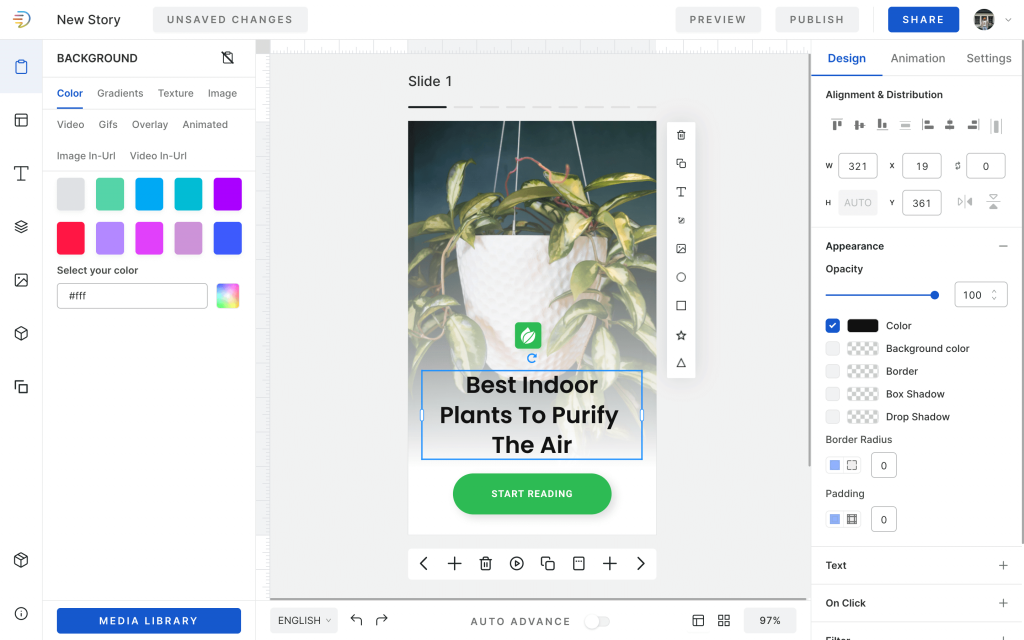
MakeStories is a drag-drop, no code Web Stories builder. It offers 100+ features, 100+ high-quality templates, SEO capabilities and much more. It’s everything you need to create and publish stories on the web.
To know more about MakeStories and its features, visit here.
Let’s deep dive into how WordPress and MakeStories work together!
How to use MakeStories In WordPress?
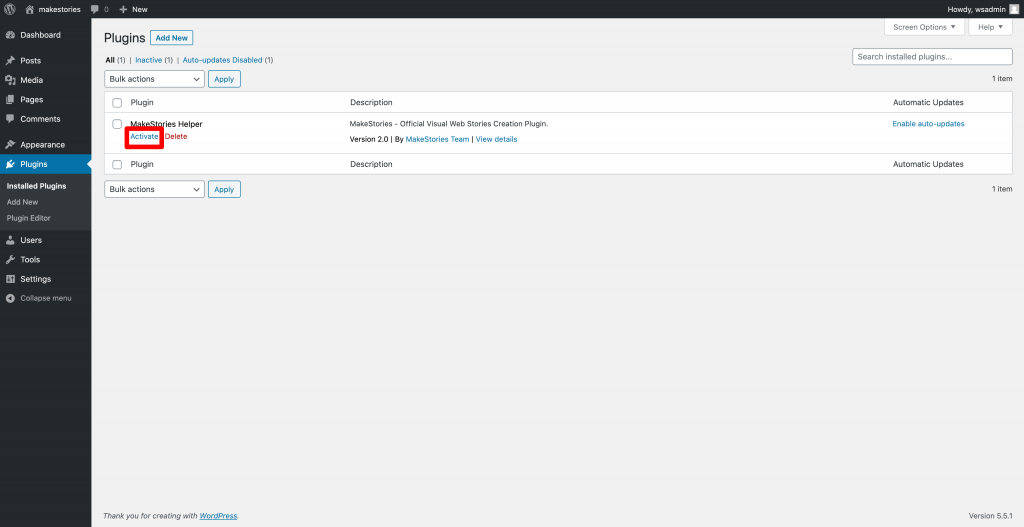
Integrating MakeStories with WordPress is very simple. Install the MakeStories WordPress plugin. This will bring the entire MakeStories editor into your WordPress dashboard.
Creating your MakeStories user account is the first step. Following this, download the MakeStories WordPress plugin from here.
Once downloaded, click on activate the MakeStories plugin. Connect your MakeStories account to your WordPress website after it’s activated. You will see a text that says, “Please Login to your MakeStories Dashboard”. Follow the instructions mentioned.
Read a detailed guide to installing and configuring the MakeStories plugin.
How to authenticate a WordPress site on MakeStories?
You have to authenticate your WordPress site on MakeStories while you’re using it for the very first time. To do that, you have to,
- Click on the MakeStories tab and wait up to 40 seconds to load the editor. This way, the MakeStories editor will automatically transfer your files into the WordPress system for a seamless experience.
- The moment when a page is loaded, it will show you a message that no MakeStories connected account was found, click the below button to connect your account.
- Once you click on connect to MakeStories, it will send a connection request and once it is sent, another message will pop up saying that your connection request has been sent.
- To accept that connection request, you have to login into your WordPress dashboard and click allow to accept the connection request.
- When you are done with all of these steps, you have to go back and click on I have verified my account and this is how you can authenticate your WordPress website on MakeStories.
Key takeaways for creating Web Stories exclusively using MakeStories WordPress Plugin
1. MakeStories Plugin Settings to Understand
We at MakeStories, allow you to control your post-type slug. When you use the MakeStories plugin, by default your web stories have a slug “web-stories”. This can be https://yourdomain.com/web-stories/post-slug this. You can change the slug by visiting the settings page under the MakeStories tab.

Enabling Categories for Web stories
MakeStories does allow you to enable categories for your web stories.
All you need to do is head towards the settings option under the MakeStories tab. Select the option that says, “Add categories to Stories” and hit the save changes tab. It is simple and quick to activate at any moment.
You can assign categories at the time of publishing, in case you missed it at first.
Publishing web Stories using MakeStories
MakeStories WordPress plugin provides an assisted publishing option when publishing a web story. You have to follow a 4 step process to make sure you have filled all the required things.
This process will help you to build up SEO for your web stories. You can even skip this assistive publishing if you wish to.
But if you want to follow this process, then follow these steps mentioned below
- Fill up the relevant SEO details and hit the publish story tab
- If you have enabled the categories option, then you will get an option to assign categories to your Web Stories.
- Enter Slug of your Web Story.
- Hit the publish button.
These simple steps show you how to use MakeStories on the WordPress dashboard.
WordPress MakeStories Editor Features
MakeStories and WordPress both have their own exclusive media library. By default, whenever you click the media library, it will open up the WordPress media library. When you click the MakeStories symbol, it takes you to the MakeStories media library. All your previous uploads will also be available here.
- The WordPress media library launches once you click on the tab media library.
- The publishing interface is a little different from the MakeStories interface. On WordPress, you can pick website names and stories slug.
- You can enable categories. You can even create a new one by clicking add a new category if you are unable to find a choice of your category.
- You can upload media to WordPress. You may move all your assets from the MakeStories server to your site using MakeStories. This ensures all your data will remain safe and secure with a simple one-click publishing.
- You can use all native features of WordPress.
- All the SEO related settings features are also available.
- MakeStories WordPress plugin is the only one that works with both Gutenberg or the Classic Editor.
- You can publish many stories together without putting much effort at a time.
- We will be releasing Small Circle Carousels on your WordPress website soon. This will provide you with a seamless experience like Instagram Stories.
- You can show particular category stories together in that one category field. If you have ten web stories connected to travel, you can group them all together in the Travel category.
- Generating a shortcode link is possible on WordPress for web stories. Using the MakeStories plugin makes this possible.
- All the MakeStories editor features are also available in the MakeStories WordPress plugin.
We’ve attempted to provide comprehensive support for all WordPress users. With the MakeStories WordPress Plugin, they may grasp the notion of AMP Web stories and WordPress.
How MakeStories and WordPress interlinked for building Web Stories?
MakeStories is the best web stories editor for WordPress. It is the only plugin that is compatible with all types of major SEO plugins. These include Yoast SEO, All in one SEO, and RankMath.
Several SEO customizations and settings are also offered by MakeStories. This is for the WordPress AMP stories plugin. This helps to boost the ranking of your Web Stories on google.
MakeStories is multilingual. It supports 7 different languages. These include English, French, German, Italian, Portuguese, Russian, and Spanish.
Conclusion
Installation and setup of the MakeStories WordPress Plugin is so easy. It requires only a few minutes to activate the plugin. Learn more about it here.


